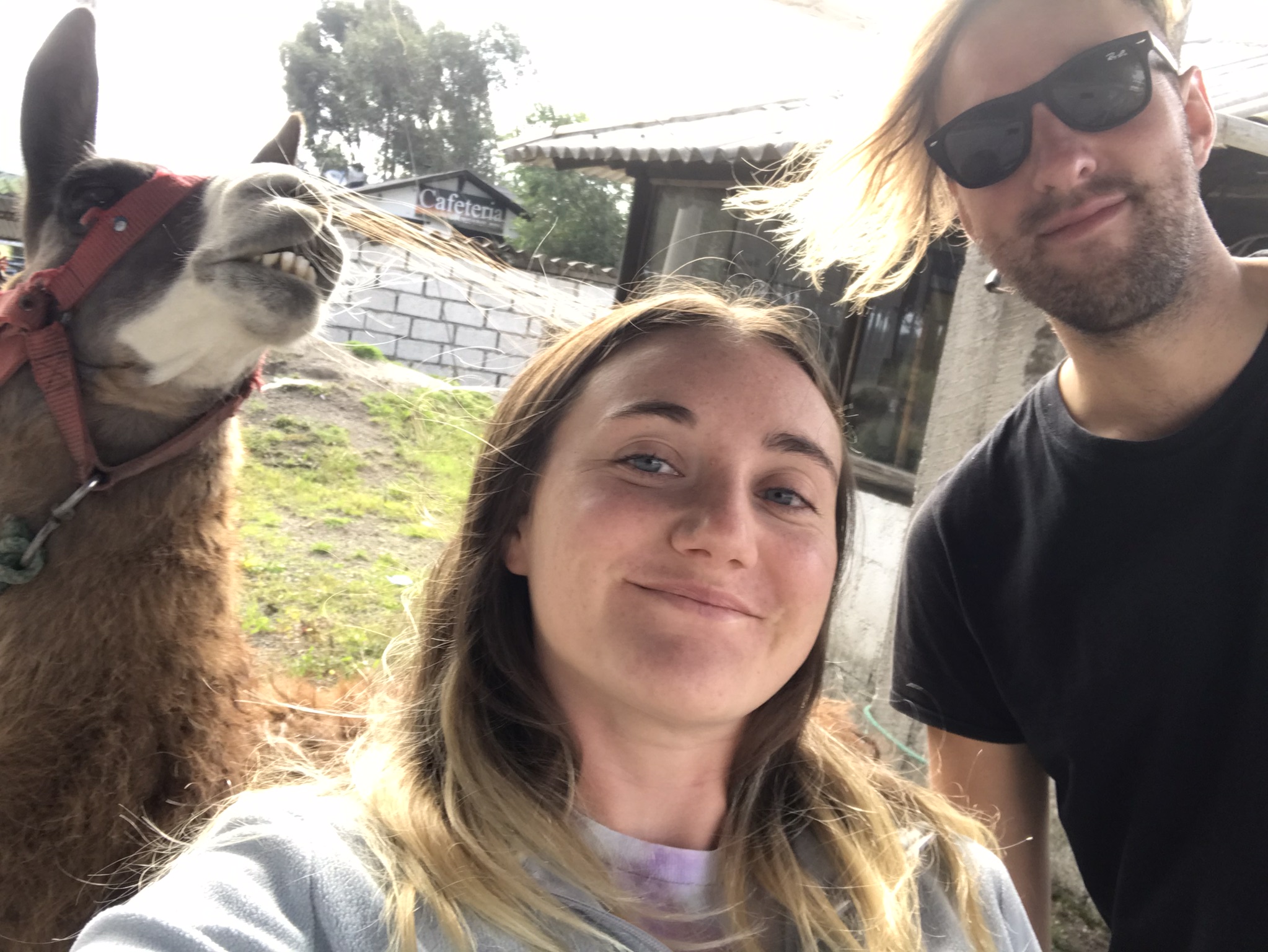Bangladesh is not on the radar of most travellers but it should be! Relative to its population, Bangladesh is one of the least visited countries in the world. When we told people we were heading to Bangladesh, most were dumbfounded and proceeded to ask us why we were going there. Bangladesh is considered by some to be a struggling, poverty-stricken and natural disaster-prone area with little to offer to foreign visitors. I whole-heartedly disagree with that last point. Check out our Bangladesh travel experiences below!
Khulna, Bagerhat, Barisal, Dhaka, Sonargaon, Sreemangal, Sylhet

Bangladesh is the 8th most populated country in the world and one of the most densely-populated, with much of the population residing in rural settlements. Strangely, despite the high population density, most of Bangladesh didn’t feel claustrophobic or overcrowded to us. Apart from the sprawling metropolis of Dhaka, you won’t find huge, congested megacities here. Instead, passing through the countryside you can find a patchwork of waterlogged paddy fields, small townships and settlements, with the occasional chimneys of brick kilns rising high above the landscape.
Bangladesh has so much to offer those willing to give it a chance. Did you know Bangladesh is home to the world’s largest mangrove forest, the Sundarbans, which is teeming with biodiversity? The Sundarbans have even received international recognition and UNESCO World Heritage status. Other places of interest include the lush tea-growing regions in the north east of the country, with miles and miles of neatly pruned tea bushes blanketing the rolling hills, as well as the long stretch of beach at Cox’s Bazar, which Bangladeshis proudly declare to be the longest stretch of beach in the world. Even the congested capital Dhaka shouldn’t be skipped!
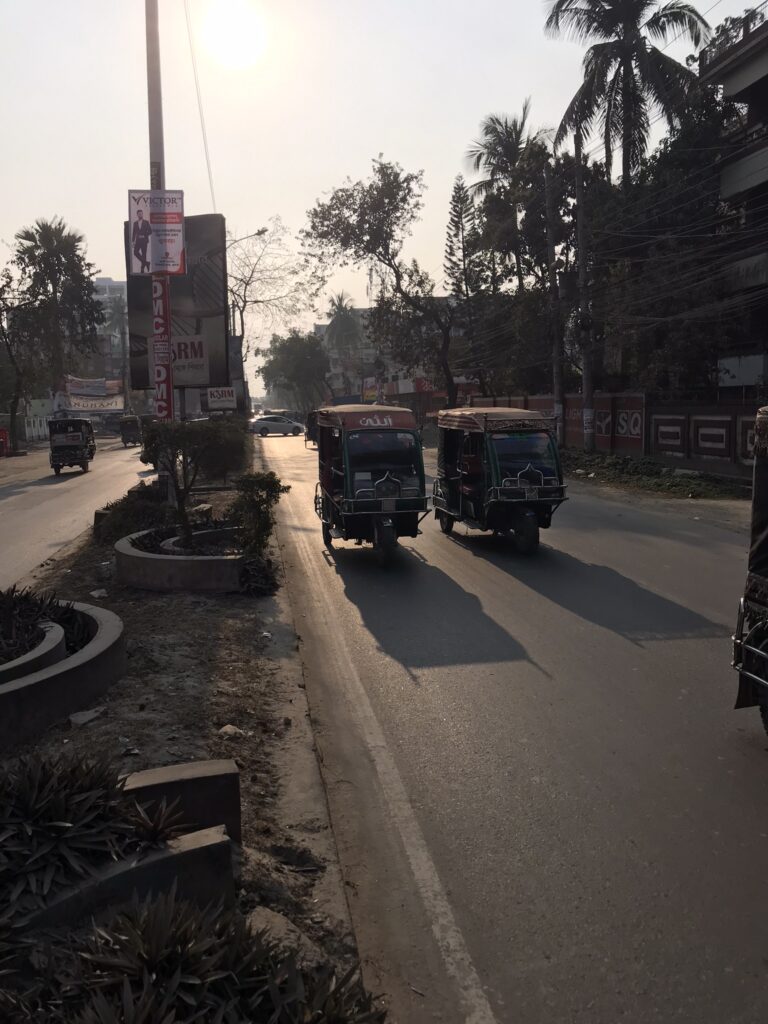
Like in other parts of the Indian subcontinent, auto-rickshaws (tuktuks) are the most common form of transport within cities. In Bangladesh, they are known as CNGs as they run using cannisters of compressed natural gas.
Bangladesh is known as the ‘Land of Rivers’. It’s one of the lowest-lying countries in the world and a large proportion of the land is situated within river deltas, creating a myriad of waterways that snake their way throughout the nation’s territory. The most prominent of these rivers is the Padma river, which is known in India as the Ganges. Rivers are the life-blood of Bangladesh, they are used for transport, agriculture and many other everyday activities, forming an essential part of the region’s identity and culture. Each year the monsoon season greatly increases the river levels throughout the country, submerging much of the landscape and bringing floods of varying severity.
We visited Bangladesh in February during the dry season when the rivers were low. Temperatures were hot but manageable at this time of year and there were no issues with heavy rainfall or flooding. To experience the full extent of the rivers, swamp forests and floating markets you would probably need to visit during or just after the monsoon season, although there may also be problems with flooding etc at that time of year.
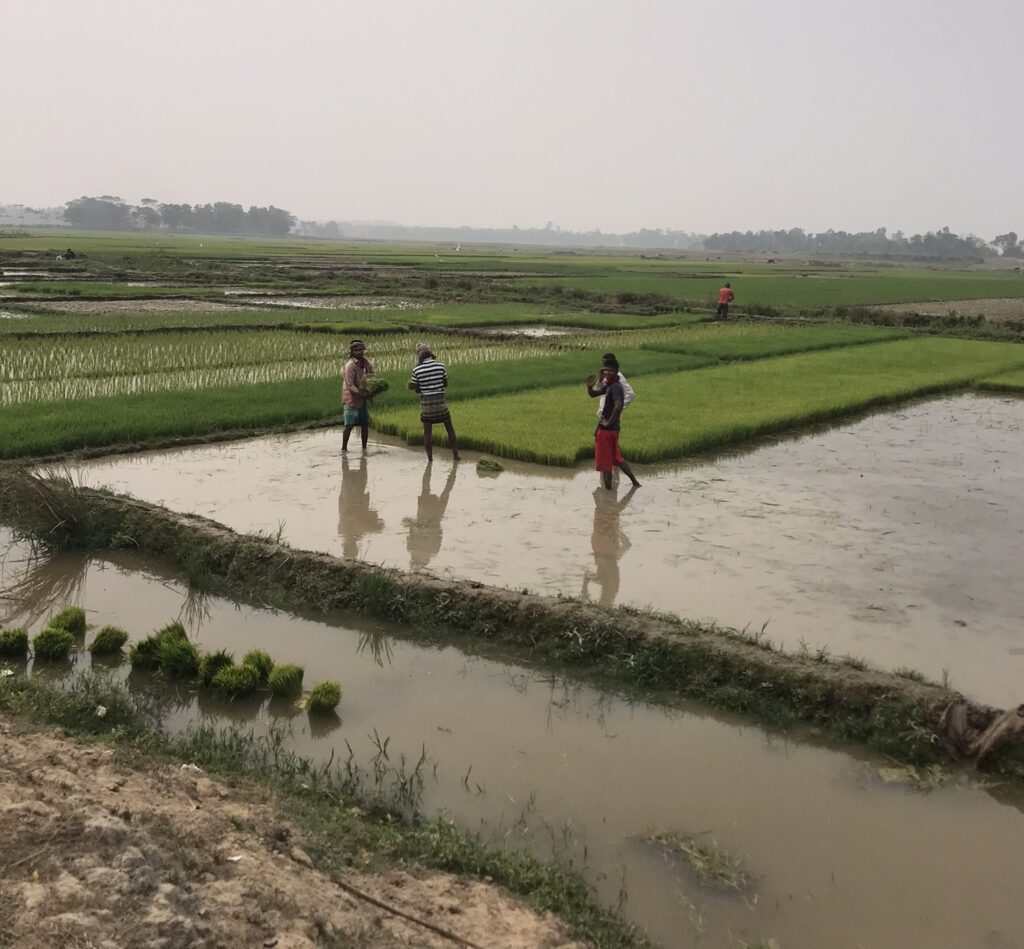
The low-lying flood-prone landscapes create great conditions for rice paddies, which can be found throughout the country
What really separates Bangladesh from other countries is the people. Locals in Bangladesh were so happy to see us and just wanted to interact with us all the time. As rare foreign visitors to the country we were treated with reverence and felt like celebrities as we constantly gathered crowds of onlookers wherever we went, queuing up to talk to us and shake Dan’s hand. Walking around and interacting with the locals was a real highlight of our time in Bangladesh. We attracted a lot of attention but all of the interactions we had felt genuine and respectful. The people of Bangladesh are some of the friendliest we have encountered anywhere in the world; when visiting you have to be prepared to interact with the many people who just genuinely want to talk to you.
It isn’t all sunshine and rainbows, poverty is prevalent in Bangladesh and many locals will try to warn you of pickpockets, criminals or other ‘bad people’ in the country. We did see plenty of fights erupting between hotheaded locals and even a family dispute which ended up with a woman brandishing a shard of glass at her rival. Fortunately the only negatives we personally had to deal with in Bangladesh were a couple of CNG drivers who tried to overcharge us (these scammers exist in all countries) and some overly-persistent beggars in the Sylhet region. The overwhelming majority of Bangladeshis we met were very helpful, friendly, gracious and eager to ensure we were safe and happy in their country.
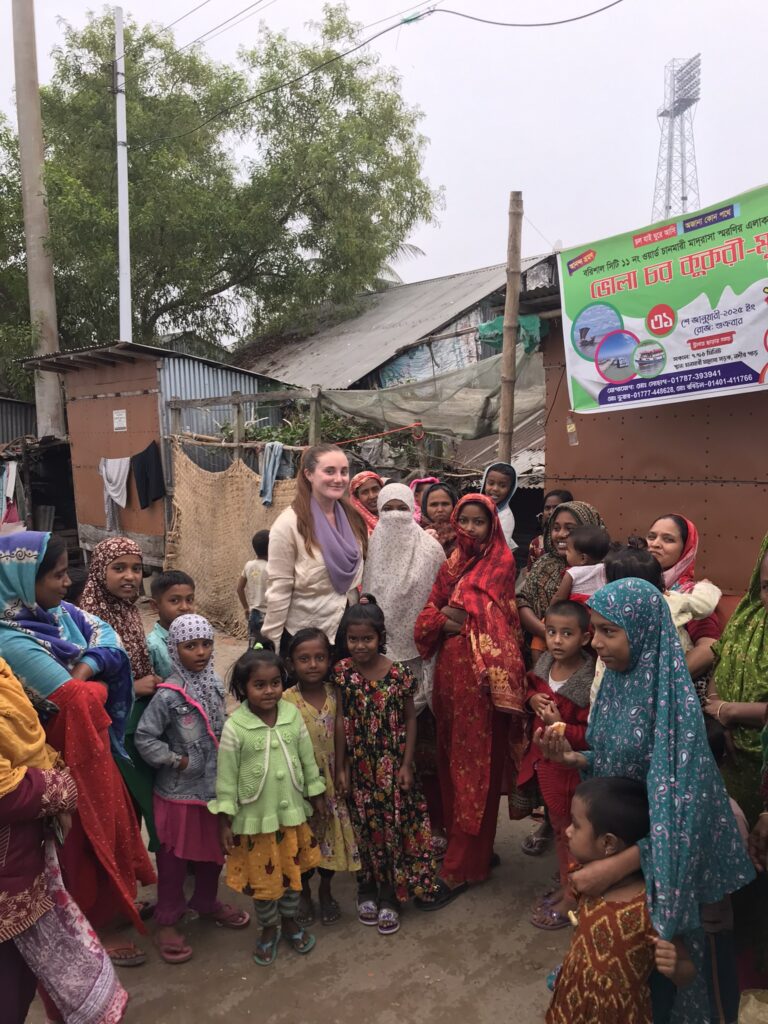
Throughout its history, the region comprising Bangladesh has been occupied by many foreign powers including the Delhi Sultanate, the Mughal Empire and the British Empire. As a former part of the British Raj, the territory of Bangladesh was originally separated from India as part of the Partition of 1947 that divided India and Pakistan. Bangladesh was initially an exclave of Pakistan known as East Pakistan, gaining its independence and becoming Bangladesh in 1971 following a war with Pakistan.
The majority of the people of Bangladesh practice Islam – a result of the 1947 Partition when Hindus and Muslims were displaced and moved across arbitrary border lines. Religion is taken seriously in Bangladesh. Alcohol and pork are forbidden and women generally dress conservatively. Friday prayers are a big deal – we found that the Dhaka metro was closed for a couple of hours during prayer time on Fridays. On one occasion when traveling on an inter-city bus on a Friday, the bus driver actually pulled over in a random town to call at a roadside mosque for prayers.
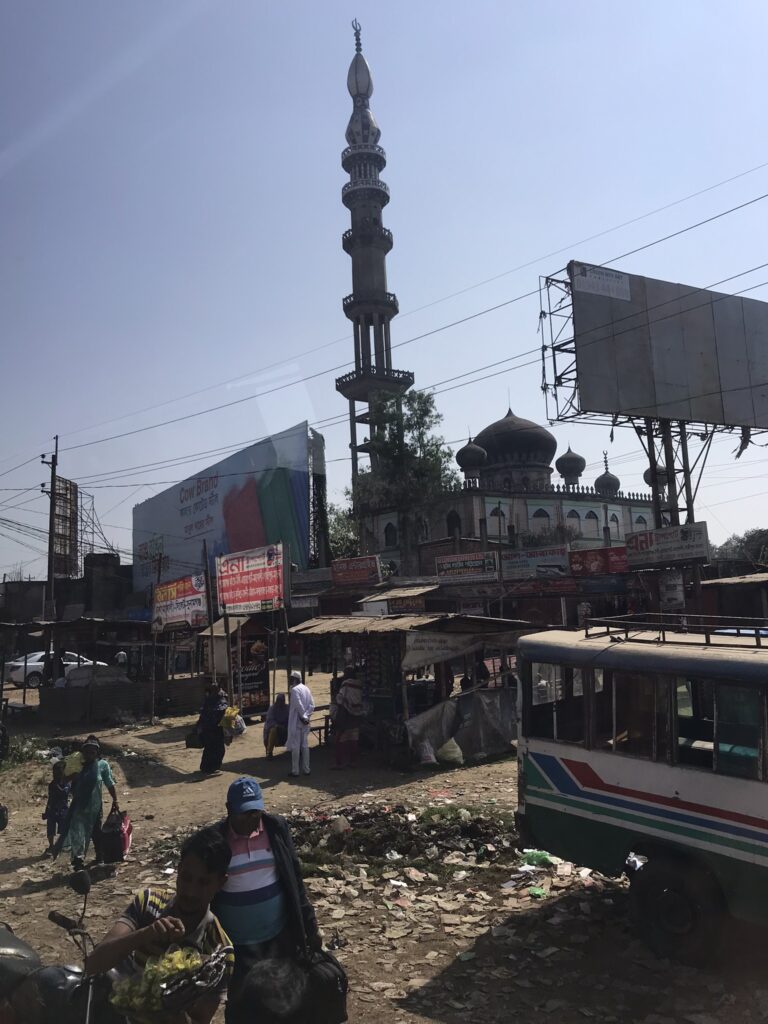
Our bus actually stopped at a mosque on a Friday so the local men on board could pray
Although religious, Bangladesh is not a fundamentalist country. We did encounter more liberal attitudes too, such as when we stumbled upon a youth women’s football match in Barisal. From our own experience, I’d say the Bangladeshi society in general felt a little less conservative than other regional Muslim countries like Pakistan or the Maldives. Still, as a woman it’s best to cover up – I tended to wear a long sleeved top, airy linen trousers and a scarf covering my chest area similar to a dupatta. This worked well and I didn’t receive any unwanted attention at all, the men we encountered were always respectful and usually were more interested in talking to Dan anyway.
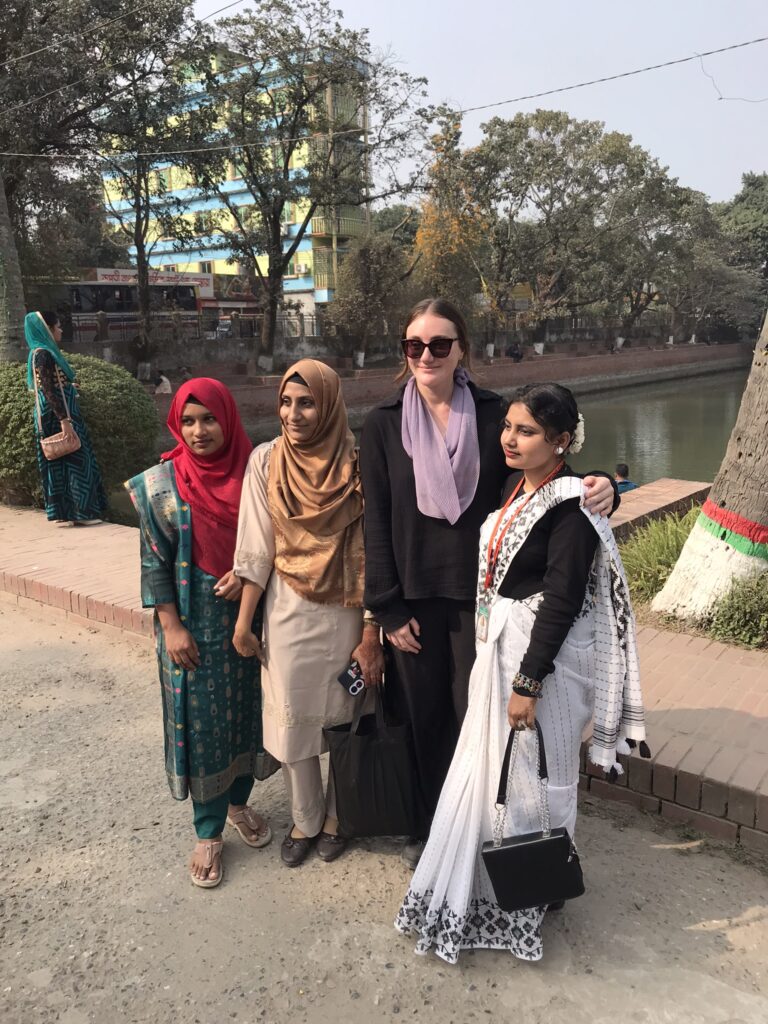
Bangladeshi women were often eager to chat and take photos, while the men usually wanted to take photos with Dan

Another quasi-religious thing we spotted was that a lot of Bangladeshi men have orange beards and hair – we were told this was reserved for respected elders. The men dye their hair and beards with henna. This can be seen throughout the Indian subcontinent but we noticed that it seemed to be particularly prevalent in Bangladesh.
One factor that contributed to the Bangladesh independence movement was the fact that Pakistan forcefully instated Urdu as the national language at the expense of the local Bengali language. The Bangladeshis are very proud of their language, which they share with the state of West Bengal in India. It’s often difficult to find restaurant menus, shop signs and information boards written in the Latin script. While Bengali is by far the dominant language, English is spoken as a second language by lots of people, especially students and educated professionals. Plenty of locals approached us to chat in English.
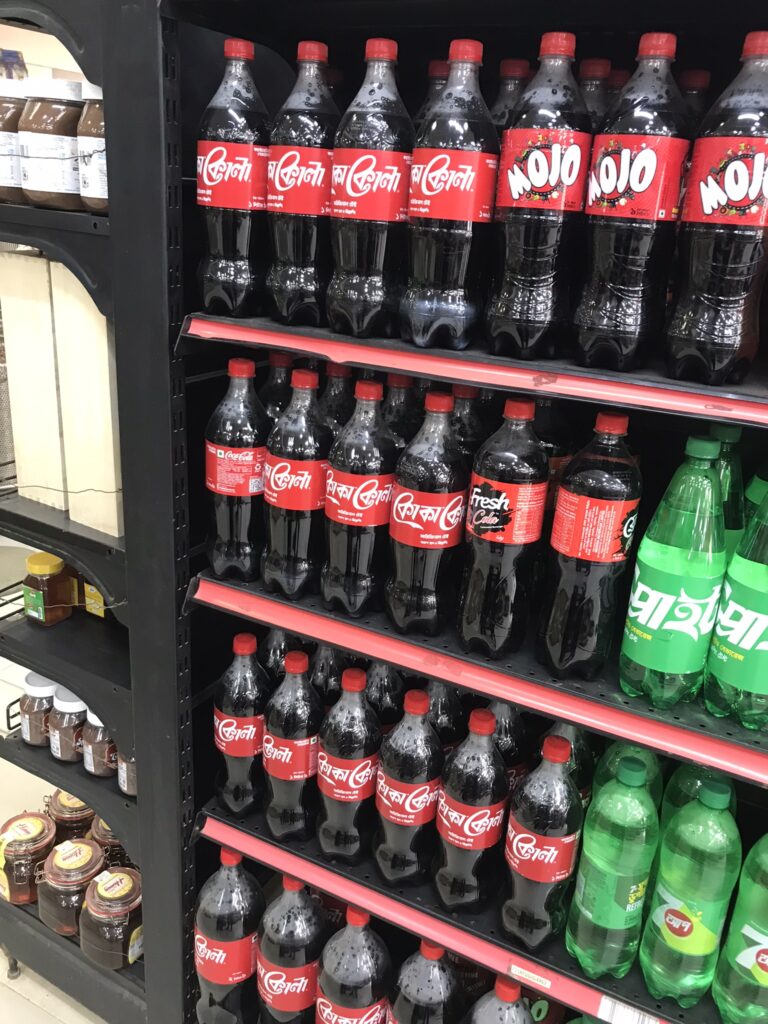
Bengali Coca-Cola
We entered Bangladesh from India via the Petrapole/Benapole land border. While the two countries do share some cultural similarities, after crossing the border we were immediately struck by just how different Bangladesh was from India. Although it has a reputation as an overcrowded and hectic place, for us Bangladesh actually provided a much needed respite from the chaos of India. We found that the standard of hotels was higher and generally many of the common annoyances of traveling in India were not present in Bangladesh. As foreign visitors are so infrequent, touts, scammers and the like are virtually non-existent in Bangladesh.
However Bangladesh is not without its own social problems which can make things challenging for travellers at times. Poverty is rampant in many places and there is often a lack of basic infrastructure. Health and safety and minimum standards of any kind are usually not enforced. Begging is not as prevalent as in India but we did find some of the beggars in Bangladesh to be very persistent, particularly in the north of the country. I wouldn’t recommend Bangladesh to inexperienced travellers or those unfamiliar with the Indian subcontinent. However I will say that we felt relatively safe and comfortable during almost all of our time in Bangladesh – aside maybe from the city centre of Sylhet, which we found to be a sketchy place.
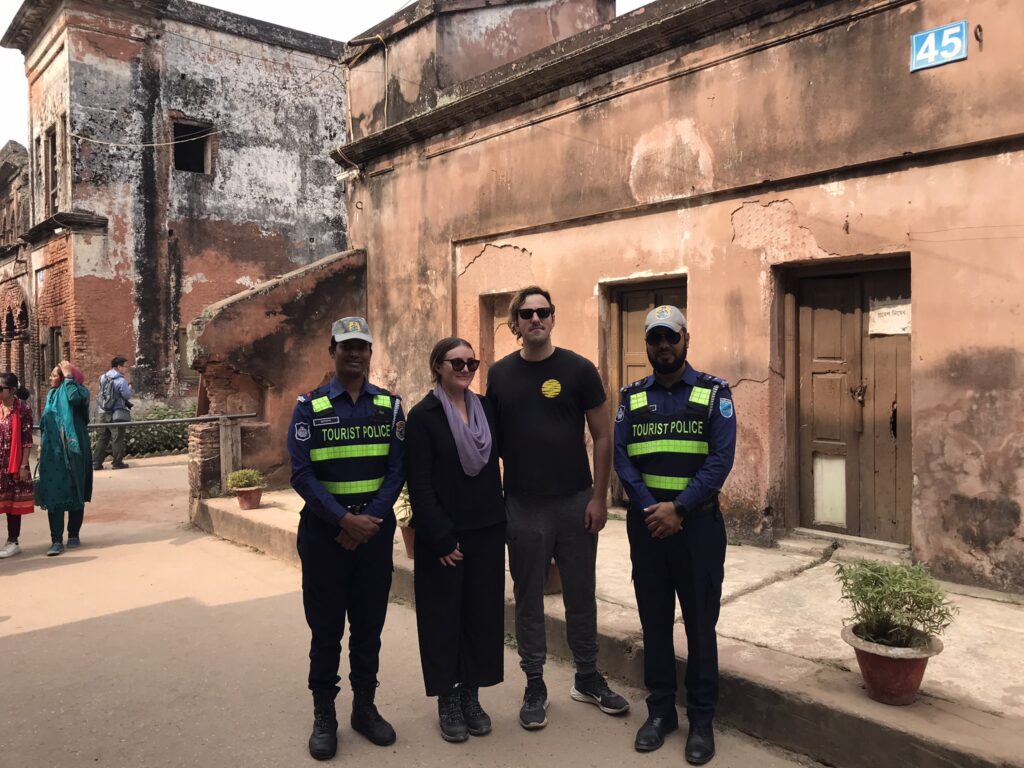
The tourist police at popular attractions were often keen to make their presence known
Don’t expect a social, hostel-style environment in Bangladesh. It is one of the least visited countries in the world relative to population size, only a few adventurous souls make it here and even fewer tend to stay long-term. We did actually encounter quite a few British Bangladeshis who were in the country to visit family – often these guys actively approached and engaged with us as they were usually quite surprised and happy to see foreigners visiting Bangladesh. Other than that, we only saw a small handful of other foreigners during our time in Bangladesh. When we did encounter fellow travellers we always had fun comparing our experiences and exchanging advice, but honestly the amount of other foreigners we met in the country can be counted on one hand.

Foreigners are a rarity in Bangladesh – confused stares may be forthcoming
Accommodation in Bangladesh is mostly limited to business-style hotels, although the cost of traveling in the country is so low that these are affordable even for solo travellers. Unmarried couples are not officially allowed in most hotels, but as a foreign couple nobody asked us any questions. Although there are many progressive ideals among the younger generations in Bangladesh, the idea of unmarried couples traveling together may still be considered a bit taboo so if you are travelling as an unmarried couple it’s probably best not to advertise the fact.
One of the main problems facing visitors to Bangladesh is transport. Tourism is not well-developed and we found that it was quite tricky to reach certain attractions using public transport (and impossible to visit others). We weren’t able to visit the Sundarbans as we found that the National Park and tour package costs seemed to be much higher for foreigners than domestic tourists – unfortunately out of our price range.
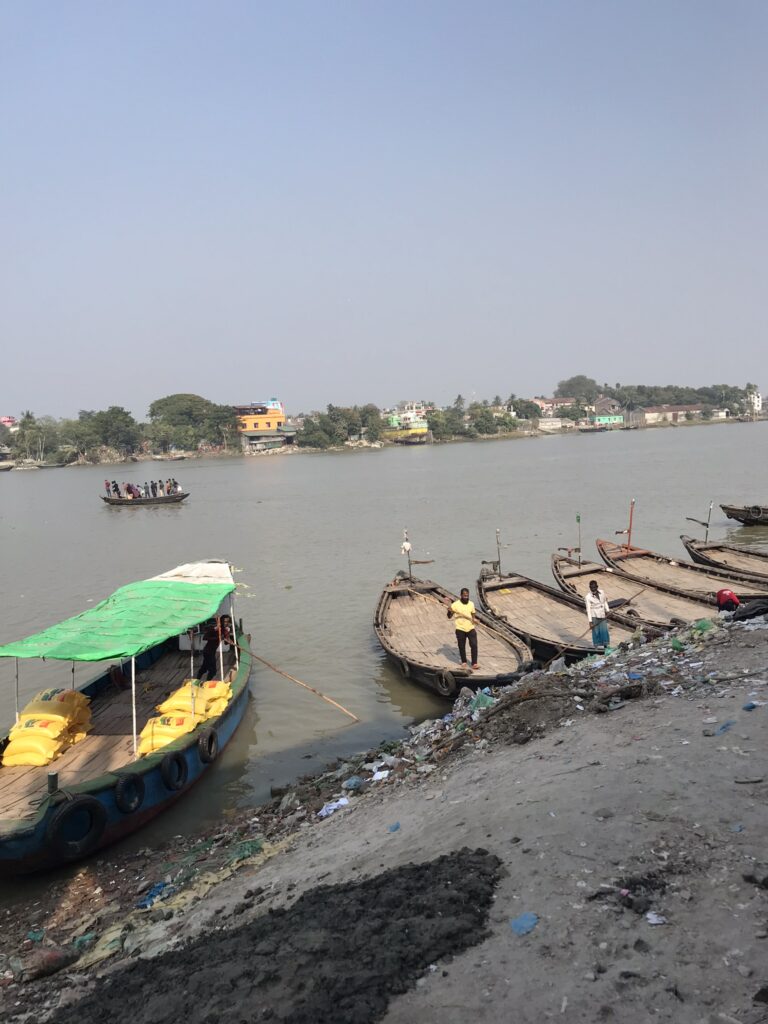
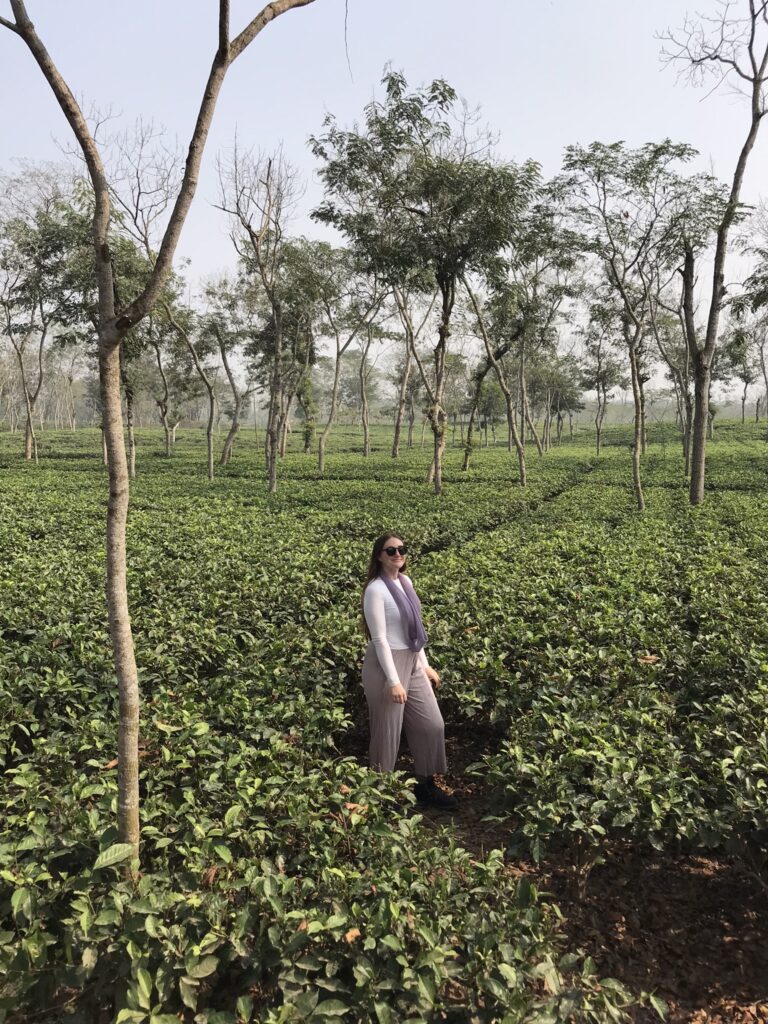
The waterways of Khula and the tea plantations of Sreemangal are two areas that can be accessed easily
Other attractions such as the floating markets at Barisal, the UNESCO site of Somapura Mahavihara in the north-west of the country and some of the natural sites around Sylhet can all be quite tricky to access via public transport. Sadly we had to skip all of these as a result. Cox’s Bazar (as well as the village of Teknaf which is the closest point to the border with Myanmar) is located along a thin strip of land which can only really be accessed via round trip from Dhaka. Due to time and budget constraints (domestic flights were annoyingly expensive) we sadly had to skip this part of the country too.
Most public transportation in Bangladesh, whether buses, flights or trains, runs to and from Dhaka. Getting directly between other cities can be difficult without lengthy back-and-forth journeys to the capital. On the other hand, getting from Dhaka to most places is pretty easy. Check out my guide to public transport in Bangladesh here!
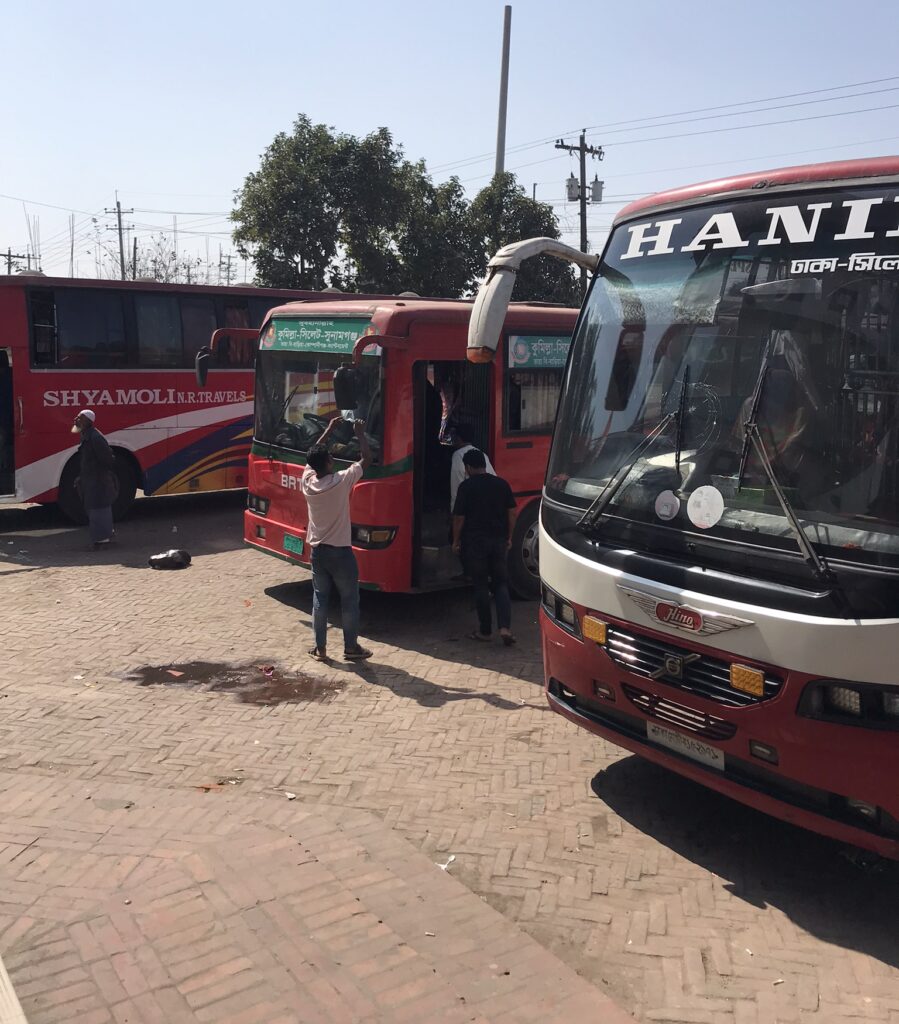
Bus travel in Bangladesh usually gets you from A to B, but it can be a hair-raising experience
Flying into Bangladesh is one of the only ways to get into the country, as most of the land borders with India and Myanmar are closed to foreigners. The exception is the Petrapole/Benapole border between Bangladesh and India in the west of the country. We crossed this border from Kolkata and it was actually fairly straightforward. Visas are required for most nationalities but we were able to obtain a Bangladesh visa on arrival at the land border and the whole experience was actually really pleasant. For my experience crossing the land border, obtaining a visa and traveling from Kolkata to Khulna, click here!
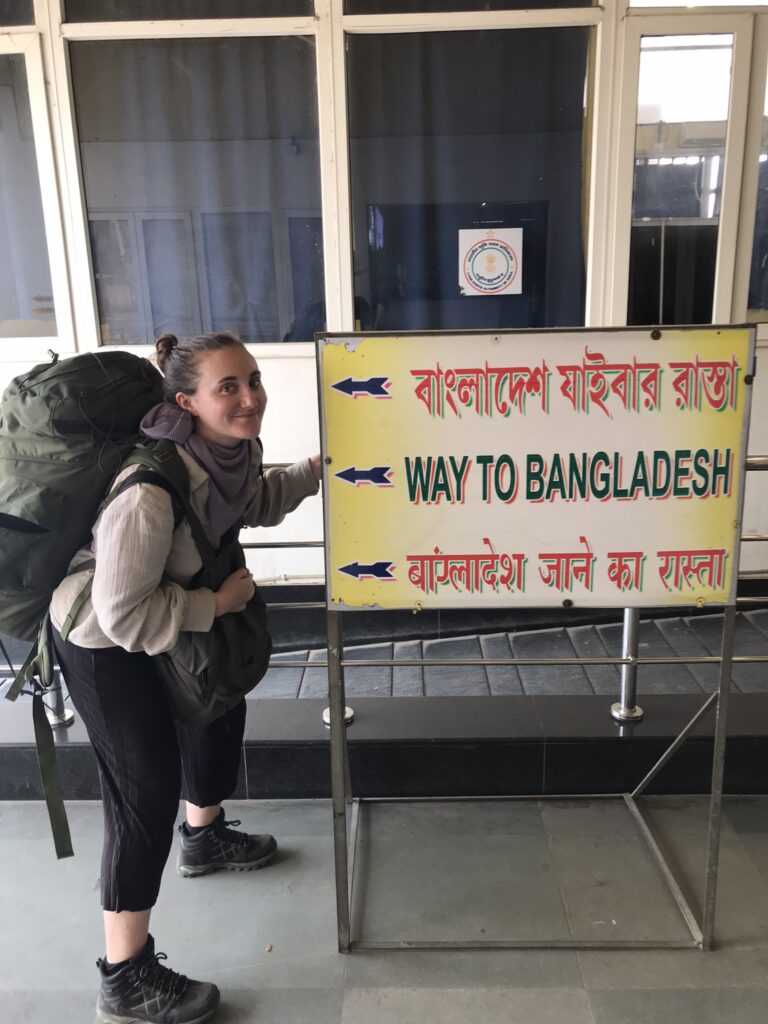
We had a pleasant experience at the border
Outside of the huge metropolis of Dhaka, Bangladesh is a very rural country. Whether by bus or CNG, while traveling around Bangladesh we were enamoured by the countryside views. Flooded rice paddies as far as the eye can see, with the occasional brickworks in the distance complete with towering chimneys emitting plumes of smoke and row upon row of newly cast bricks. Hay bales shaped in a unique way; every home seemed to have its own hay bale stashed in a strange hut-like shape. We visited out of monsoon season so water levels weren’t high, but we could see lots of large Chinese fishing nets along the river banks. Each family plot has a pond for bathing and washing clothes – we heard that many children die each year from falling into these ponds and that there are public health schemes being launched to encourage families to fence off these hazardous ponds.
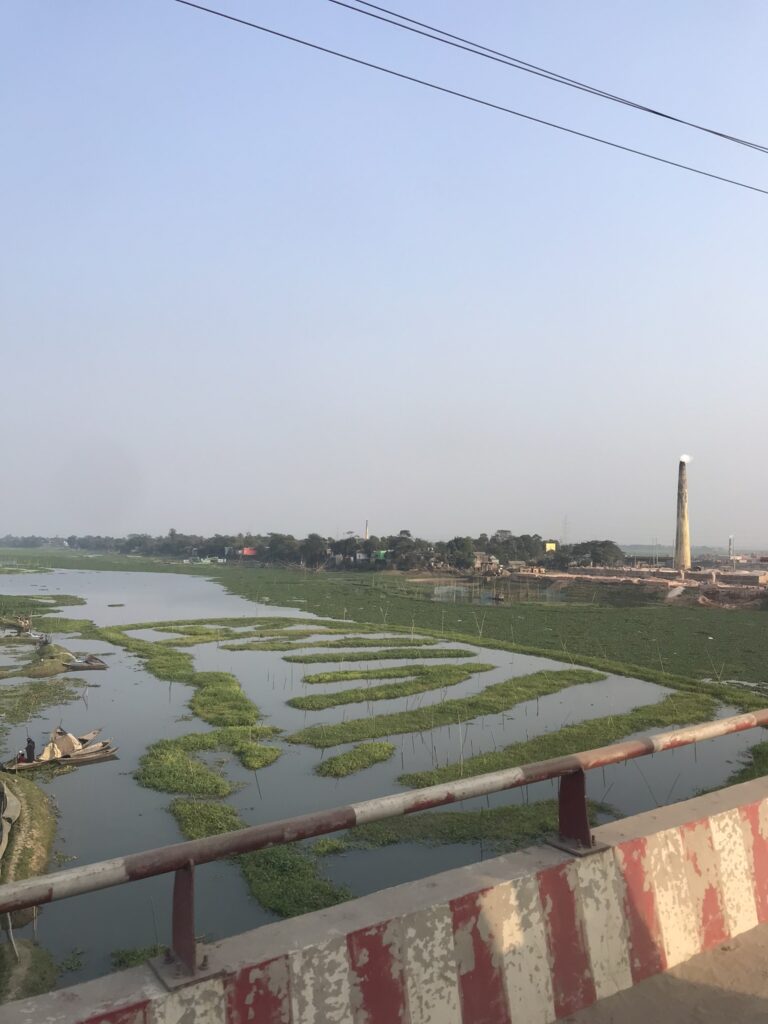

Classic rural scenes in Bangladesh
Bangladesh is a cash economy, which can be a little difficult for travellers as only a few banks are set up to accept foreign cards. A little trial-and-error may be required when first arriving into the country to find a bank that works. It’s not as bad as Tajikistan – a couple of banks worked for us. EBL and City Bank were two ATMs that usually accepted our UK-issued Mastercards. Card payments also usually worked on City Bank-issued machines with our cards. Aside from the difficulties withdrawing cash, the cost of traveling in Bangladesh in terms of food, accommodation, transport and entry to tourist sites is very low, even in comparison to nearby countries like Pakistan and India.
Bangladeshi cuisine has some special delights such as Kacchi (similar to biryani, a meat and rice dish accompanied by sauce and a side salad, usually eaten with your hands and not cutlery much to our chagrin), lacchi (lassi – always a favourite with us), bhorta (mashed vegetables sometimes in a ball), firni (a sweet rice pudding type dessert) and Borhani (a slightly odd yoghurt based green drink with green chilli, mustard seeds, coriander and mint). Kacchi is king in Bangladesh and you’ll find it everywhere, from high end restaurants to street vendors churning the stuff out in bulk. Food hygiene in the country isn’t always the best so it’s important to check the reviews of any restaurant before eating there, particularly as a lot of the food in Bangladesh is meat-heavy. We were careful to eat at reputable places and didn’t get sick.
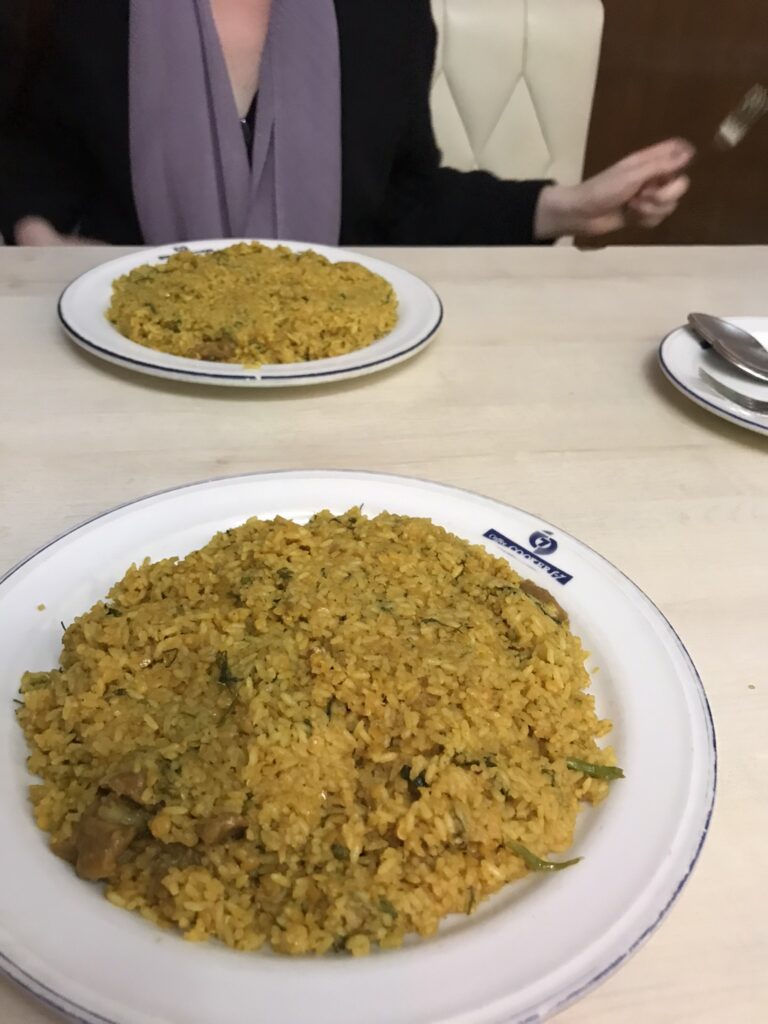
If you travel to Bangladesh, prepare for kacchi
Political turmoil erupted in the country recently when the sitting Prime Minister, Sheikh Hasina was ousted by student-led demonstrations in 2024 and fled to India. This led to the end of her authoritarian regime. At the time of our visit, Bangladesh was in a transition period without an elected government. However, aside from some roadblocks and graffiti relating to the student protests in Dhaka we didn’t really notice much evidence of this on the ground.
Khulna
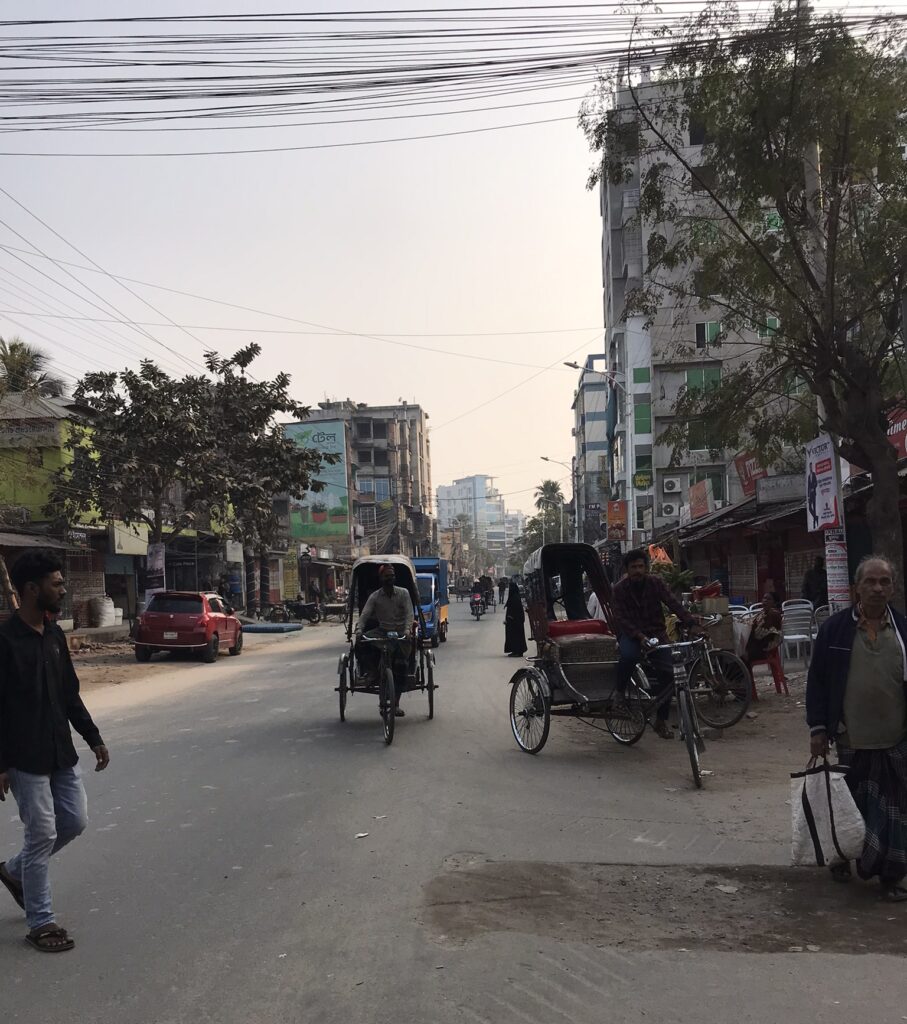
Khulna is the first city we arrived at in Bangladesh after crossing the border from Kolkata. A smaller and more relaxed city than Dhaka, it made for a gentle introduction to the country. Khulna is situated along a river (as with most Bangladesh cities) and is surrounded by smaller rural settlements and waterways.
After coming from India, we found Khulna to be surprisingly more developed than many northern Indian cities. There were pavements, Western-style supermarkets and modern shops. We even found a pretty good burger place, which was a novelty after not eating beef for months in India. The centre of Khulna was relatively calm and not too chaotic, there was a lack of traffic chaos and honking horns which again was a novelty which we were very thankful for after India. We saw families, groups of friends and young courting couples in the park, nobody really bothered us and we felt comfortable enough just walking around (although we didn’t venture too far out of the city centre so I can’t confirm that this is the same in the entire city).
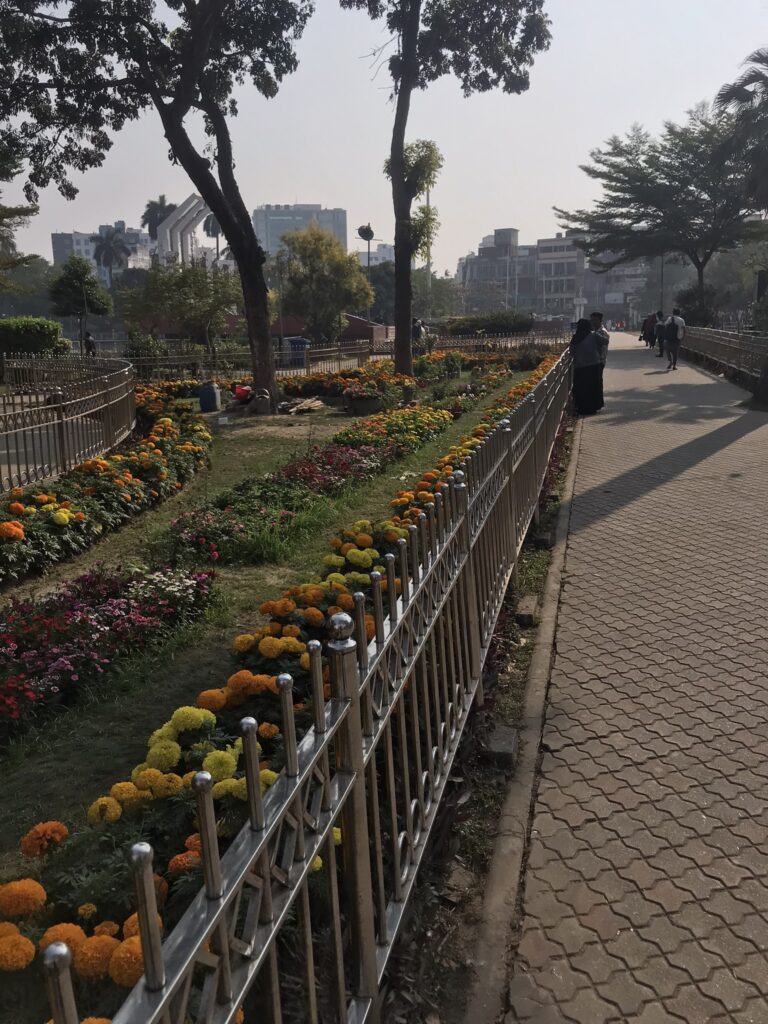
Shahid Hadis Park is a pleasant place for a stroll
For tourism purposes, Khulna mostly is known as a gateway to the Sundarbans, the UNESCO-listed wetland area which is one of Bangladesh’s few notable tourist attractions. However, even from Khulna the Sundarbans are still not really easy to access. Group tours are advertised online but at the time of our visit these were very expensive for foreigners and they also seemed to be a little unreliable and sporadic. We met a German guy in our hotel who said he had been trying to visit the Sundarbans for several days but kept being delayed and put off by his local contact. I’m not sure how legitimate this contact was; in any case, we didn’t end up visiting the Sundarbans.
As well as the Sundarbans, Khulna makes a good base for visiting the town of Bagerhat and the 60-Dome Mosque, one of the few UNESCO World Heritage Sites in Bangladesh. You can easily get to Bagerhat from Khuna on the bus or by CNG. The city of Khulna itself has a lack of notable attractions, but we enjoyed walking along the riverfront and through the Boro Bazaar area (spice market) with its array of colours, sounds and smells.

If you want to buy heavy metal t-shirts, apparently Khulna is the place
The main bus stand in Khulna is Sonadonga, which is within walking distance of the city centre. This is where we were dropped off when coming from the border and is also the place to get a bus to Bagerhat. To travel to Barisal we went to the BRTC ticket counter here, I can’t vouch for this being reliable though – our original bus was cancelled and we ended up departing three hours later than expected.
Accommodation
Jatra Flagship Khulna City Centre – An excellent choice if you’re looking for somewhere comfortable to stay in Khulna. Slightly unusual layout in the fact that the whole property consisted of two adjacent apartments subdivided into two or three hotel rooms each. The staff were always happy to help with information, exceedingly welcoming and professional. The rooms were modern, comfortable, to western standards and quiet, allowing peaceful rest. A fantastic location within walking distance (13 minutes) of the main bus terminal. We thoroughly enjoyed the Bangladeshi breakfast which consisted of juice, fruit, curried vegetables and paratha, as well as the room-service Chinese food.
Foodie Places
Kudos – Khulna – a typical Western-style burger joint. We went straight there to have a beef burger after crossing from India. The server was very helpful and eager to know that he had done a good job.
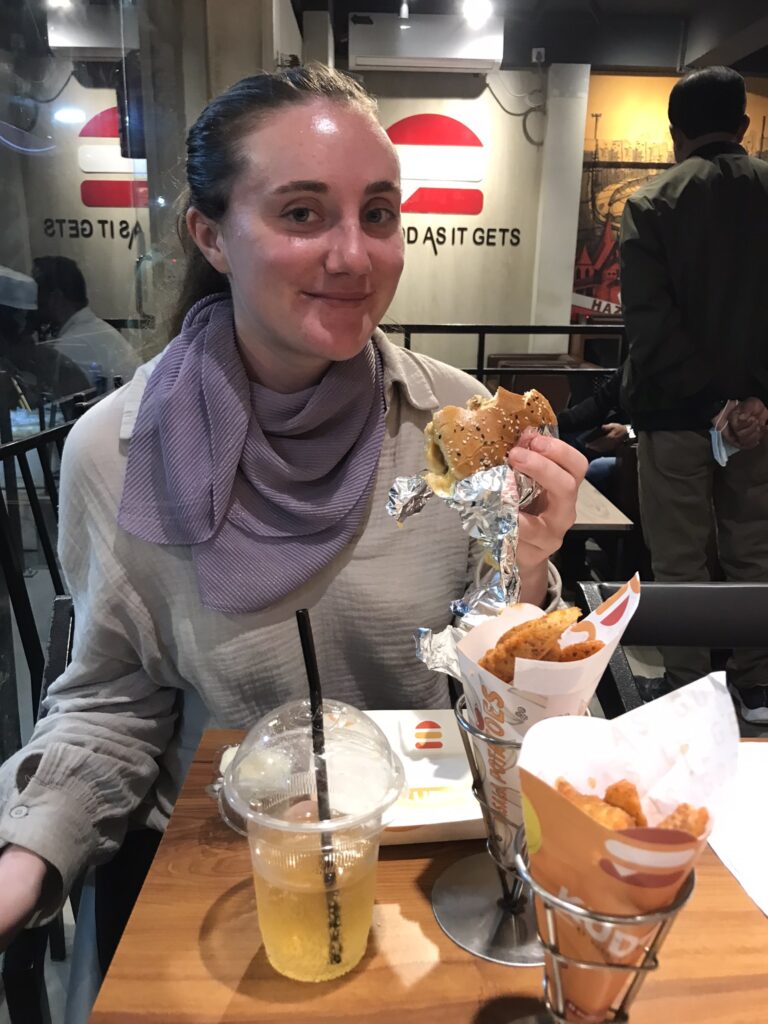
This was the first beef we had eaten in months!
Kacchi Bhai – Khulna – a great place to try Kacchi. The place was full of locals and almost everyone eating with their hands – we followed suit, which can get very messy. Nobody here spoke much English and the menu was completely in Bengali, but we managed to communicate what we wanted easily enough. I think most people in here were surprised to see foreigners. A great authentic kacchi experience.
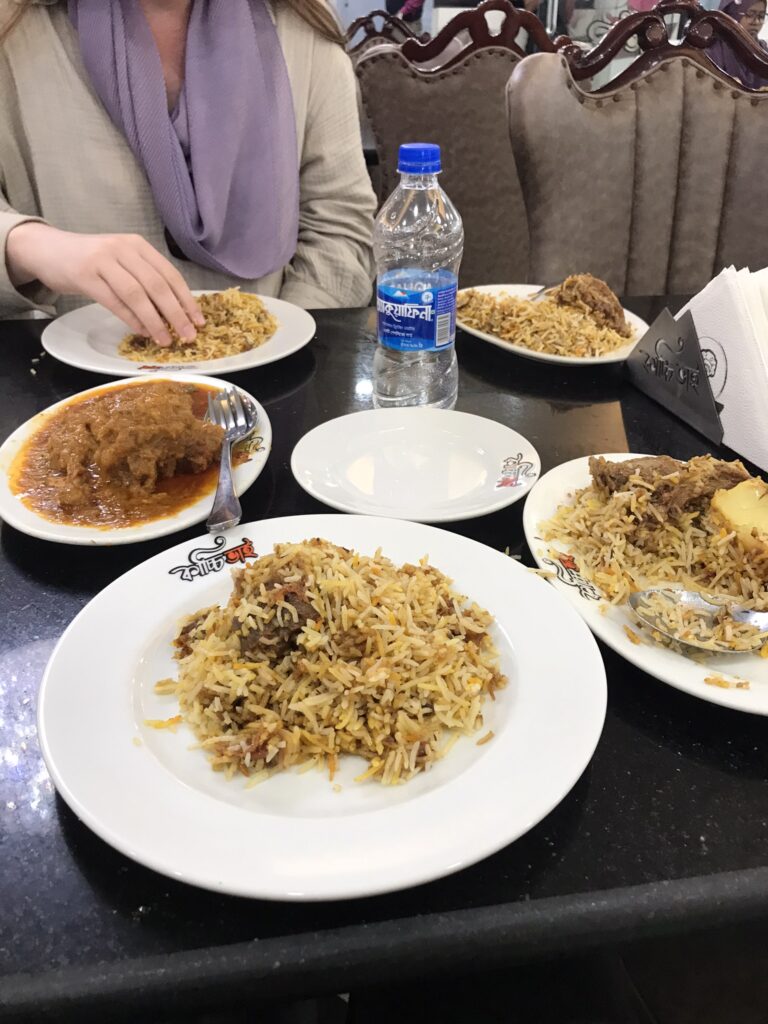
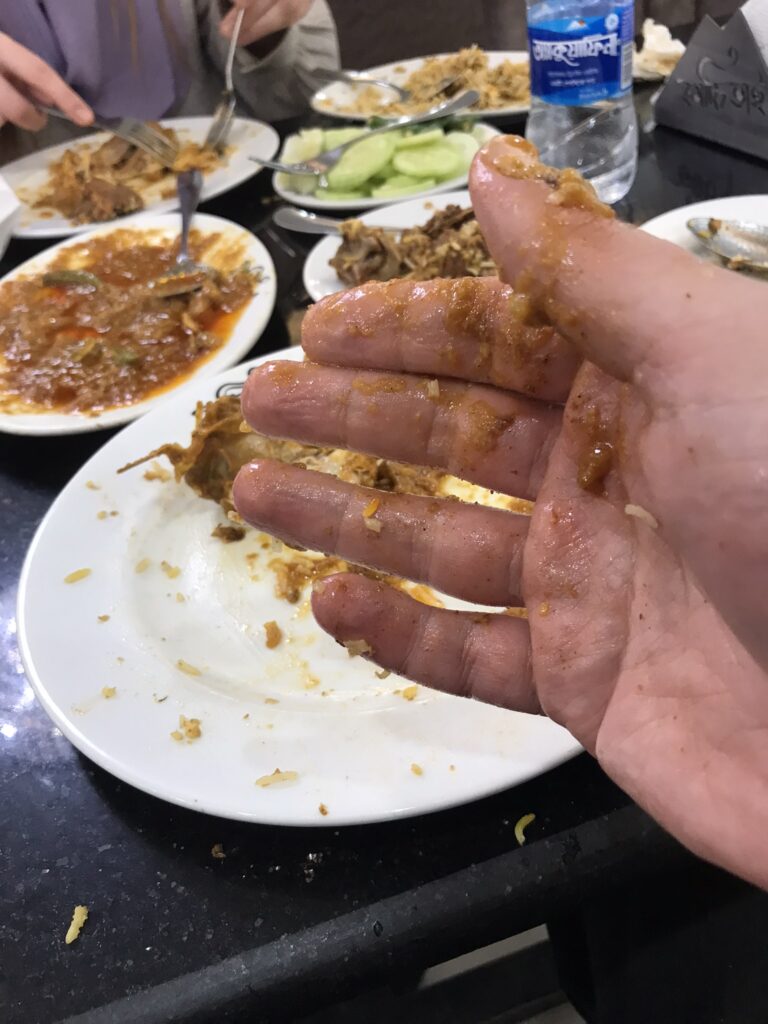
Messy times at Kacchi Bhai
Activities
We had a short walk around the city centre near to the train station including:
Rupsa River – one of the many large rivers winding their way through Bangladesh, this is a typical busy Bangladeshi waterway the likes of which have played a major role in the daily life of the local people for generations. Trade vessels, passenger ferries and tiny fishing boats all ply these waterways. It’s possible to find a couple of decent viewing areas on the banks of the Rupsa river near the train station. We particularly enjoyed watching the passenger boats – all of the passengers stand upright rather than sitting down, which seemed odd.
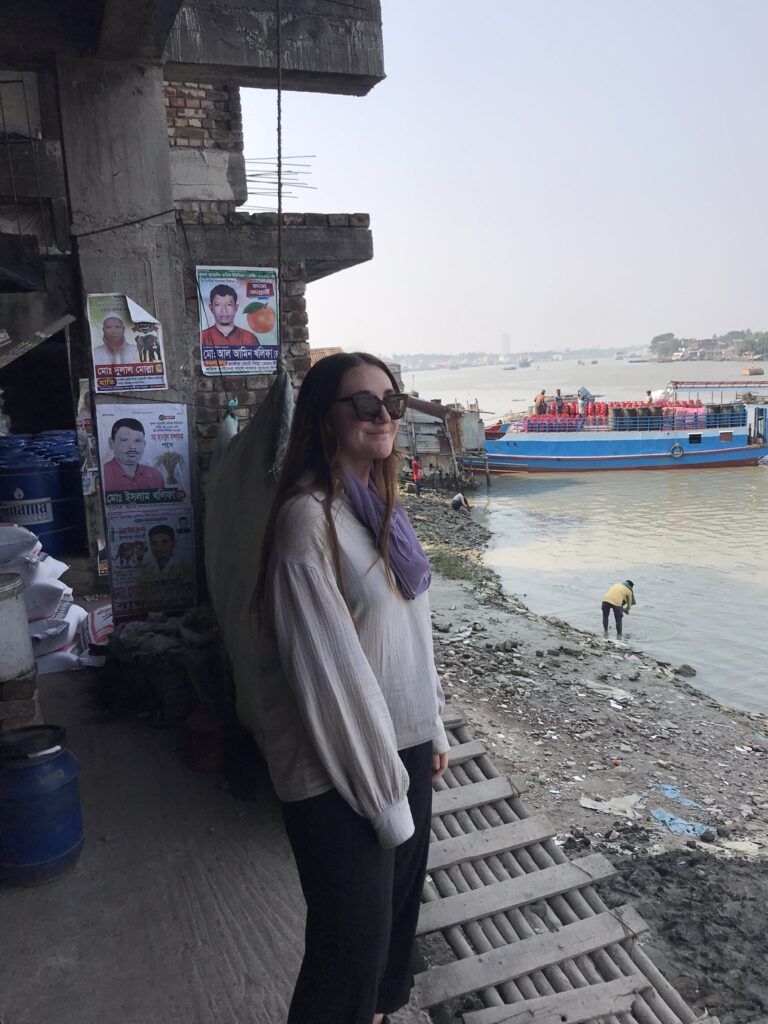
We enjoyed watching the many boats along the river
Boro Bazar – near to the bank of the river, this old bazaar and spice market is an atmospheric area and seems a world away from the modern streets just a couple of blocks away. A plethora of goods are on sale here, from bulk hessian bags of spice to knock-off Nike shoes. This is an interesting place to wander and explore at leisure, although at points it can become a bit crowded and overwhelming (although the same can be said for any bazaar in this part of the world).
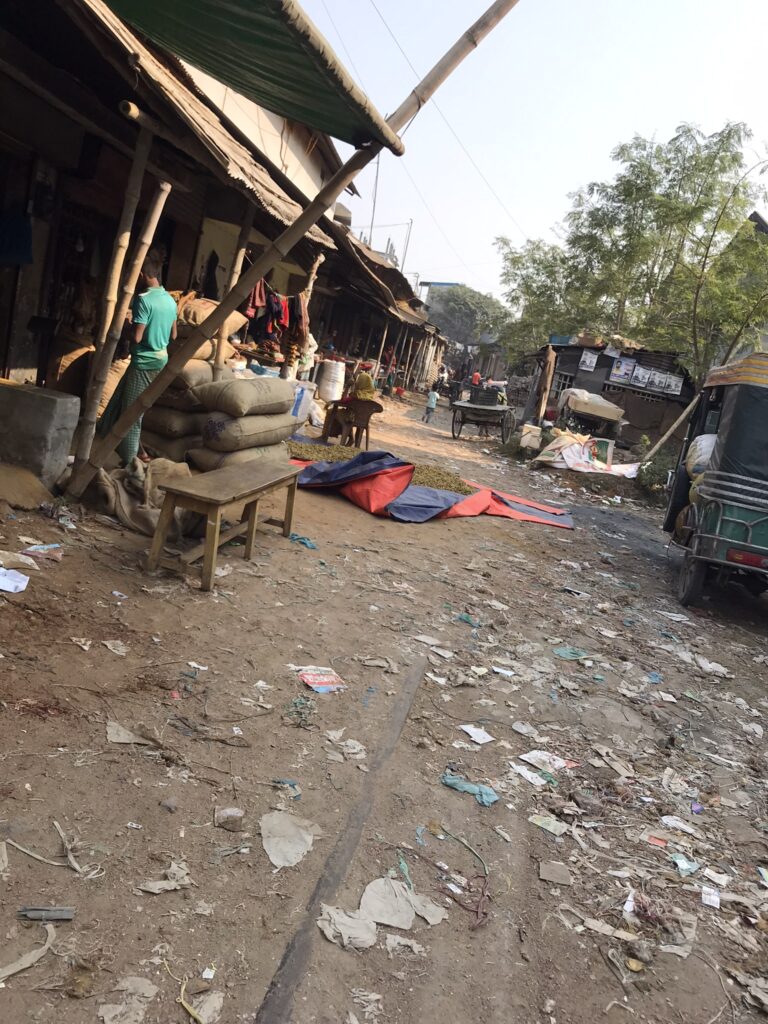
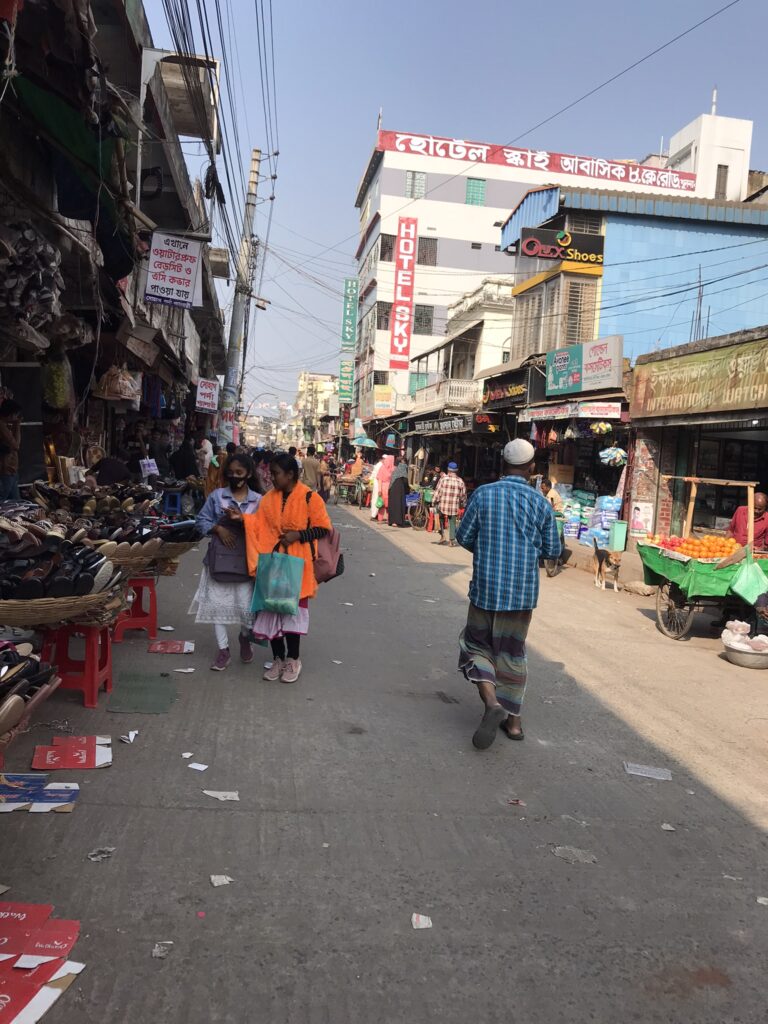
The smell of spice is pretty prevalent on the streets around Boro Bazaar
Shahid Hadis Park – a small park with a lake in the centre. The park contains some nice flowers and greenery which makes for a welcome change from the concrete jungle bustle of the city. This park seemed to be a favourite for young courting couples, who sequester themselves away in the various nooks and crannies.
Bagerhat
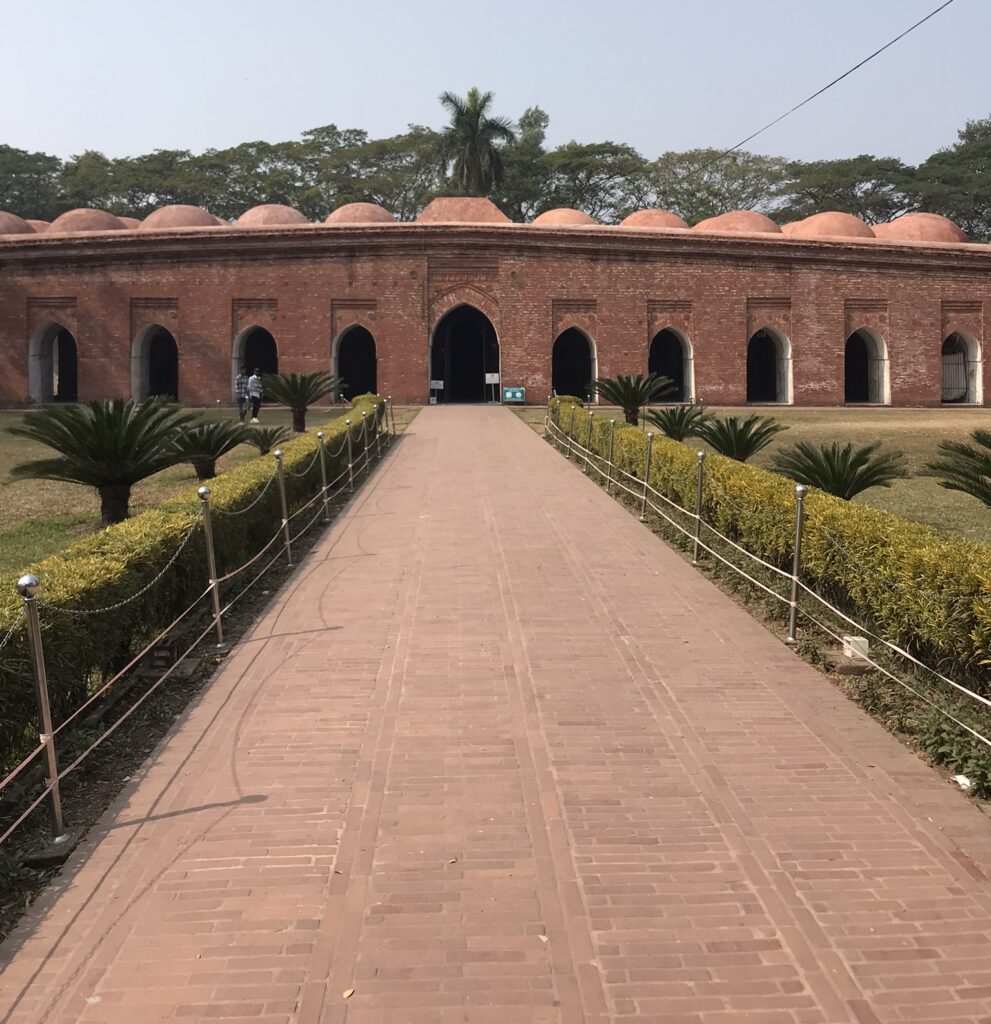
We took a day trip to the town of Bagerhat, which is located around 1 hour away from Khulna. A UNESCO World Heritage Site, Bagerhat is the location of the 15th-century town of Khalifatabad, which was constructed by a ‘great warrior saint’ named Khan i-Jahan. By far the most famous attraction at Bagerhat is the 60-dome mosque, otherwise known as the Shait-Gumbad mosque. This mosque actually has 77 domes and is the largest and most impressive of the Khan Jahan-era monuments. However this is not the only historical monument in town.
Other surviving monuments include the Singair mosque, Bibi Begni mosque, 9-dome mosque, Chunakhola mosque, Ranovijoypur mosque, Khan Jahan’s mausoleum, the single-domed mosque, tomb and mosque of Zindapir and Rezakhoda mosque. These sites are all in varying states of repair and are spread out over an area of 15 square kilometres.
There are two main clusters: the 60-dome, Singair, Bibi Begni and Chunakhola mosques are all located in the same area, while the Rezakhoda, 9-dome mosque and mausoleum of Khan Jahan are also clustered together in a separate area, around a water tank in the south east of town which is purported to contain a sacred crocodile. It is possible to walk or take a CNG between these two areas. There are many other small monuments and archaeological remains in the wider region, but you would probably need a local guide or knowledgeable CNG driver to take you to them.
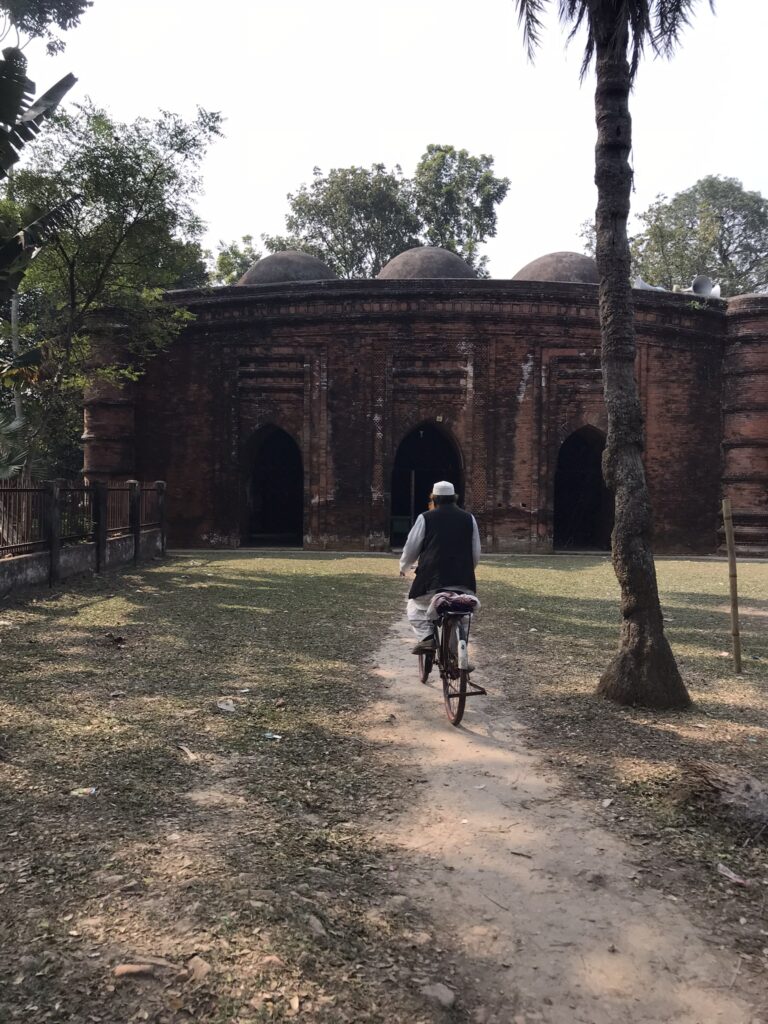
The 9-dome mosque is another of the heritage sites in the Bagerhat area
It’s easy to get a bus to Bagerhat from the Sonadonga bus station located here in Khulna– buses are regular, just ask any of the hawkers at the station for the next bus to Bagerhat and you will be directed to the right place. The bus driver was really helpful and dropped us off right outside the entrance to the 60-dome mosque, which is along the main road. You can also get a CNG from Khulna if you want, but this is much more expensive than getting the bus.
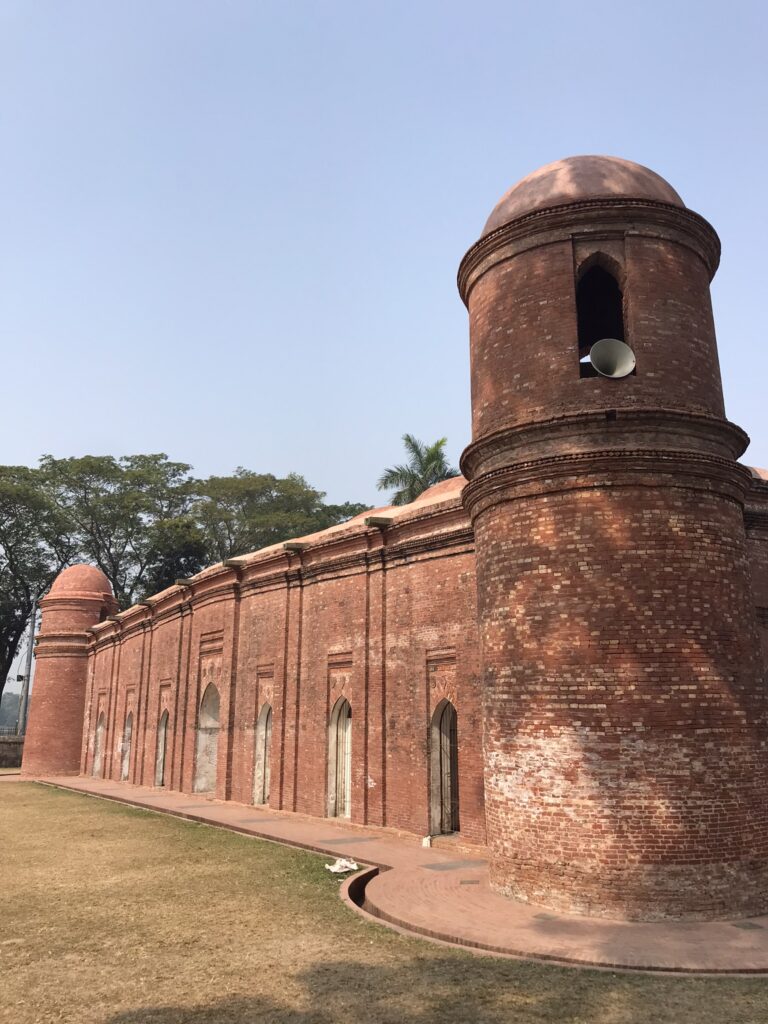
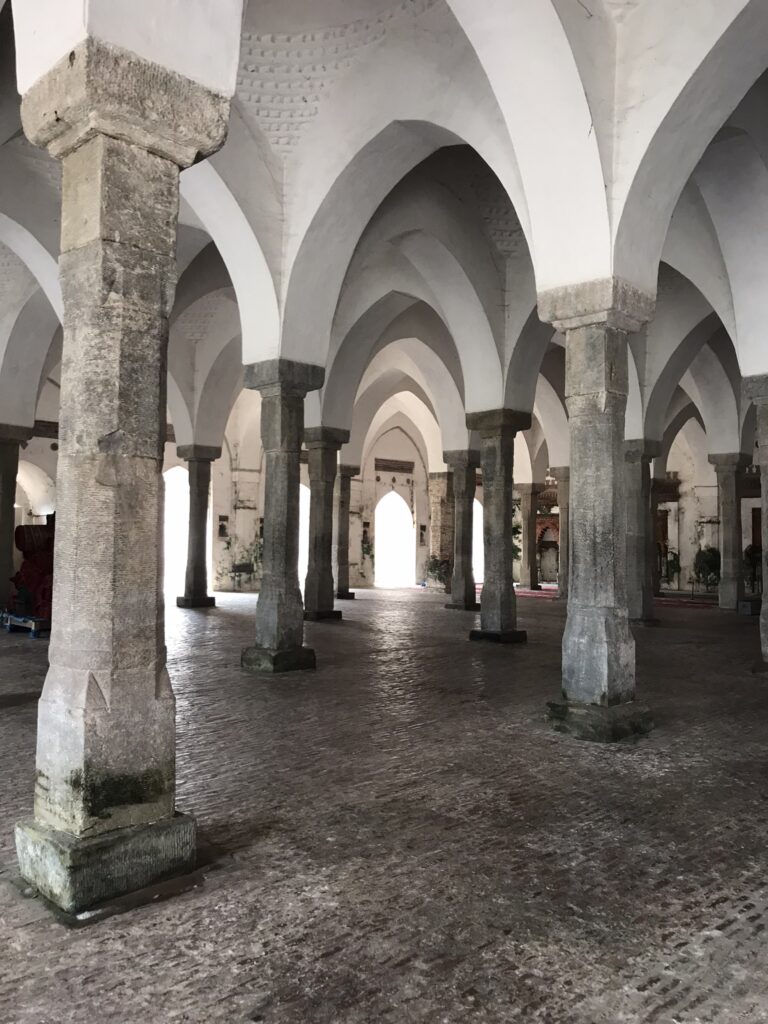
The main attraction – this is one of Bangladesh’s few UNESCO World Heritage Sites
The 60 dome mosque is part of a larger complex also including a garden, a water tank (ghora dighi) and a small museum. Entrance to this complex is paid and there are tourist police around who are eager to greet you, reassure you that the area is safe and, most likely, ask you for a photo. We enjoyed resting by the water tank, which is filled with water lilies and surrounded by picnic benches. It is possible to go inside the 60-dome mosque outside of prayer times – although there isn’t too much to see inside, the imam was happy to give a short explanation for baksheesh.
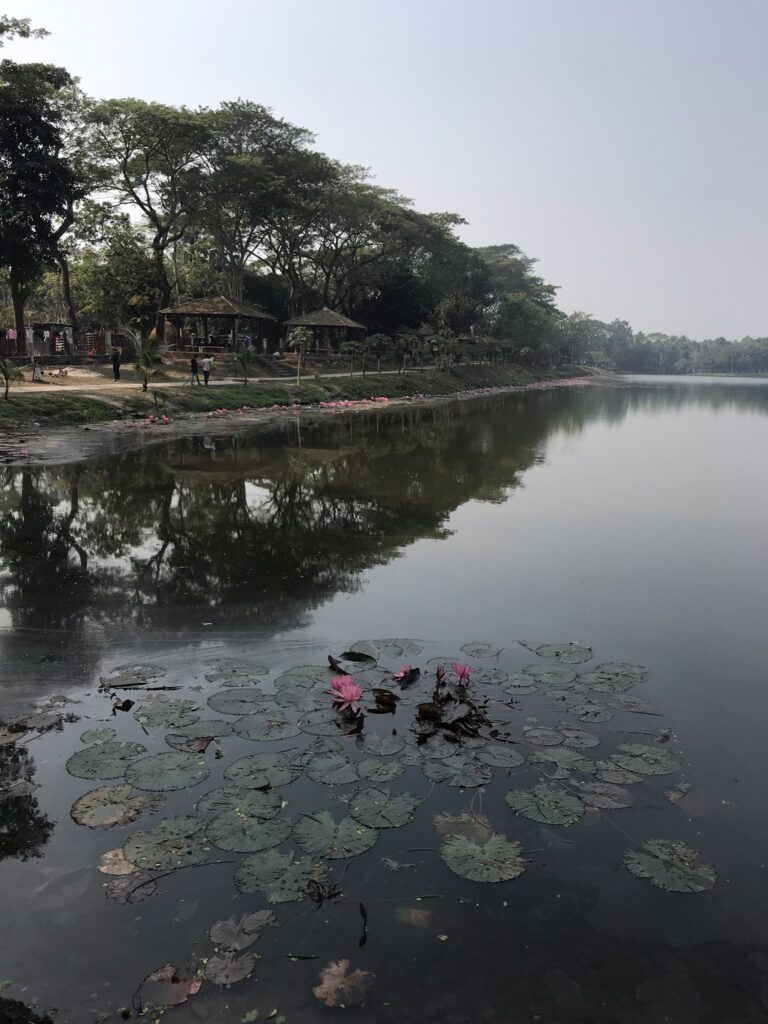
The water tank within the 60-dome mosque complex is a peaceful place to relax
After visiting the 60-dome mosque we planned to walk to the area around the Khan Jahan mausoleum, however a local CNG driver offered to take us there and then drive us all the way back to Khula for a good price. We decided to take him up on the offer as we pre-emptively didn’t fancy waiting around at the side of the road for a passing bus back to Khulna.
The area around the Khan Jahan tomb was really nothing special. The tomb itself felt like a bit of a scam and a tourist trap. As a woman I wasn’t allowed inside, Dan went in but was whisked into the back, given a 5 second ‘blessing’ and then immediately asked for money. They also tried to ask for money for guarding our shoes. If you want to visit this tomb then make sure to bring lots of small change for the never-ending baksheesh requests.
The most interesting thing in this area is the water tank with its resident crocodile, which we didn’t personally encounter but is said to be quite aggressive. People still bathe in the tank despite the presence of the croc. We were also taken to the nearby 9-dome mosque on the CNG before heading back to Khulna. The CNG journey back to Khulna was enjoyable in and of itself as it gave us a chance to observe the daily life amidst pastoral, watery rural landscapes of the region as we chugged on by.
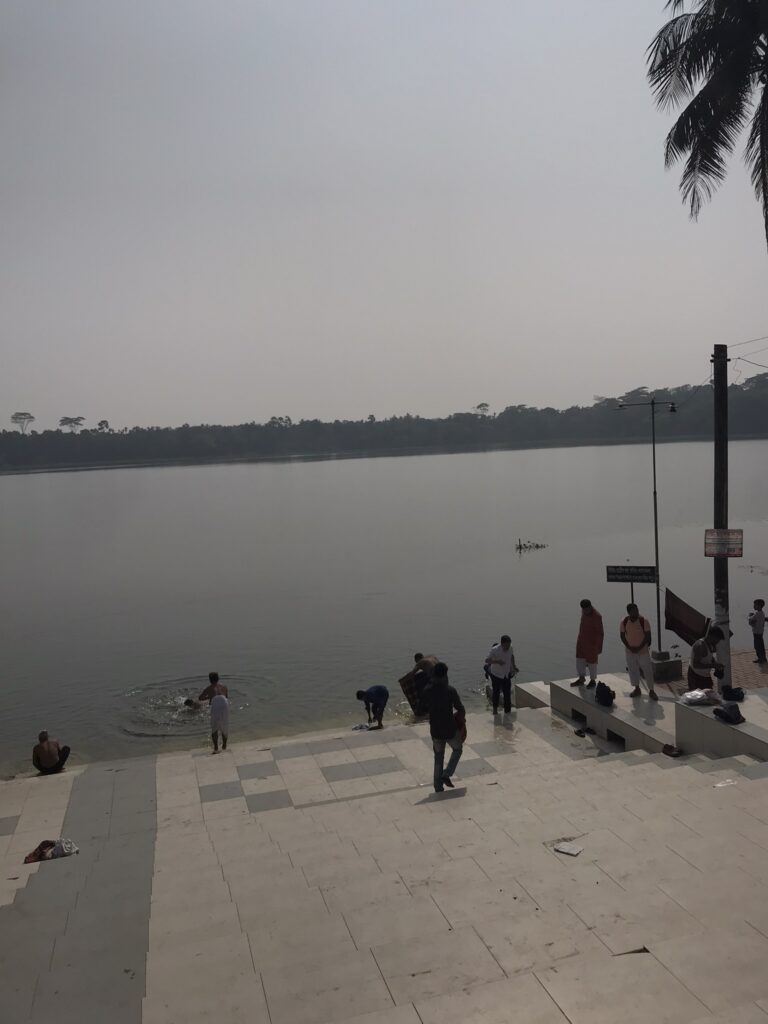
There is an angry crocodile in here but that didn’t stop these guys
Barisal
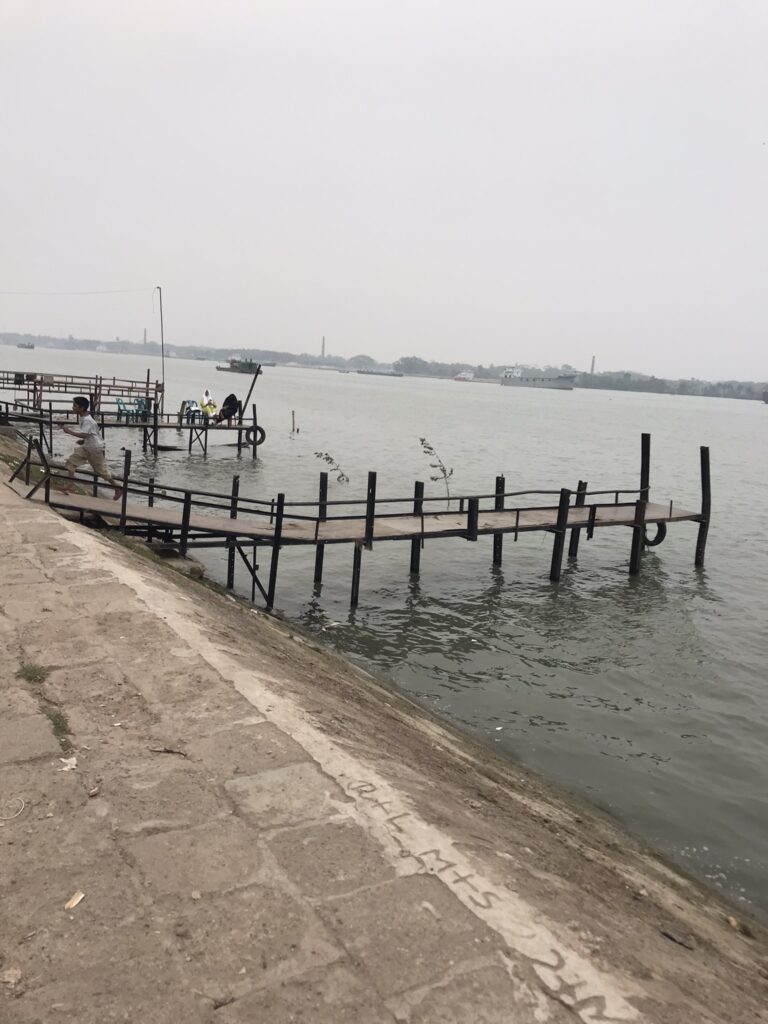
In the heart of the delta flood plains region, Barisal is on the banks of the Kirtankhola river and is an important link port along Bangladesh’s extensive river network. Previously, riding a ‘launch’ (a boat) from Barisal was the main way for passengers to get to Dhaka from the south of the country. However, following the inauguration of the Padma road and rail bridge in 2022, the importance of Barisal as a transit port for maritime traffic has been depleted. It’s now much quicker and easier to get to Dhaka by road. In fact, the number of daily passenger boats from Barisal to Dhaka has now been reduced to one. This boat travels overnight, making it no longer relevant as either a convenient means of transport or a sightseeing activity.
The few foreign visitors to Barisal often want to take the boat as a novelty, but we decided not to do this in order to save time, money and stress. While it would’ve no doubt been a memorable experience, truthfully it was just much easier and quicker to get to Dhaka by bus. I can’t really make any comment on the boat departure times and logistics as we didn’t make any enquiries and the small amount of information available online seemed to be out of date. If your heart is set on getting the boat then the best thing to do is probably just go to the harbour and ask.
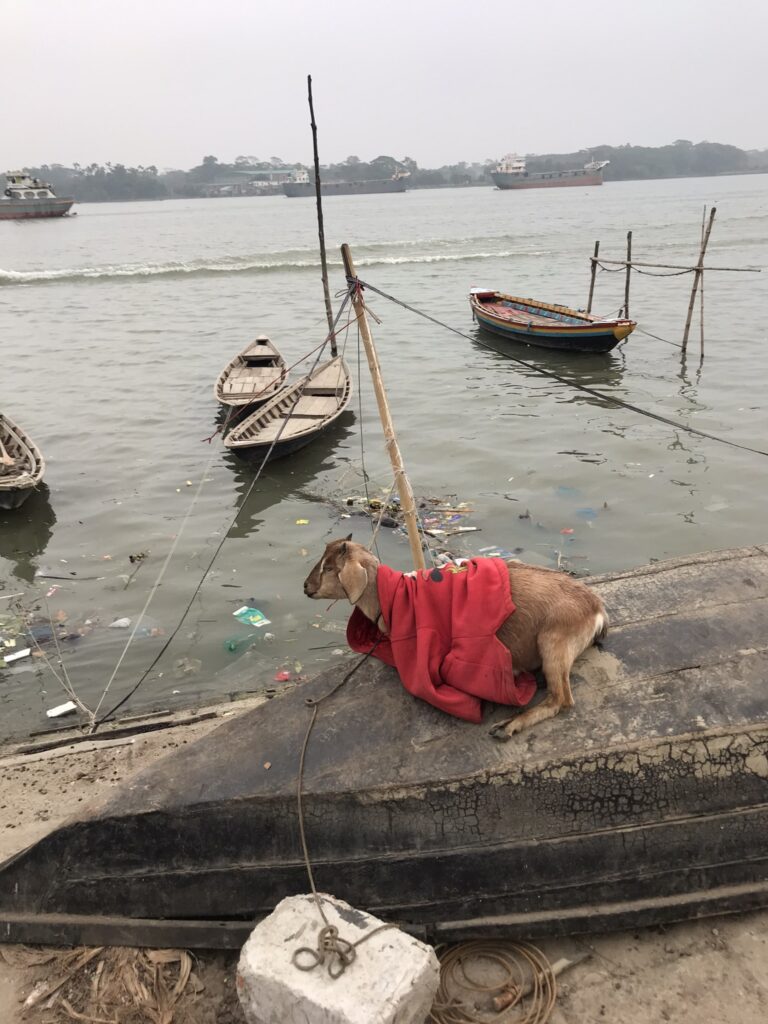
A goat in a coat on a boat
Barisal is also famous for the floating markets on the rural waterways in the surrounding region, particularly the floating guava markets. From our research, getting to some of these markets requires an early start and is tricky to say the least by public transport. As the markets are reportedly much larger and more prominent during the monsoon season, in the end we just didn’t feel like effort and/or cost of hiring a CNG or other private transport to make the trip would’ve been worth it. If we were in the country during the monsoon season, this would’ve definitely been an activity that we would’ve sought out.
As it is, our time in Barisal was mainly spent meandering around the streets and having worthwhile interactions with local people. The city itself didn’t stand out for its beauty or architecture but, in a country lacking in major tourist attractions, interacting with locals is one of the highlights of traveling in Bangladesh and we experienced some of the friendliest people in Barisal – from the soldiers and officials who invited us to watch a youth football match and gave us VIP treatment to the excitable children on the ‘30 Godown’ riverfront promenade.
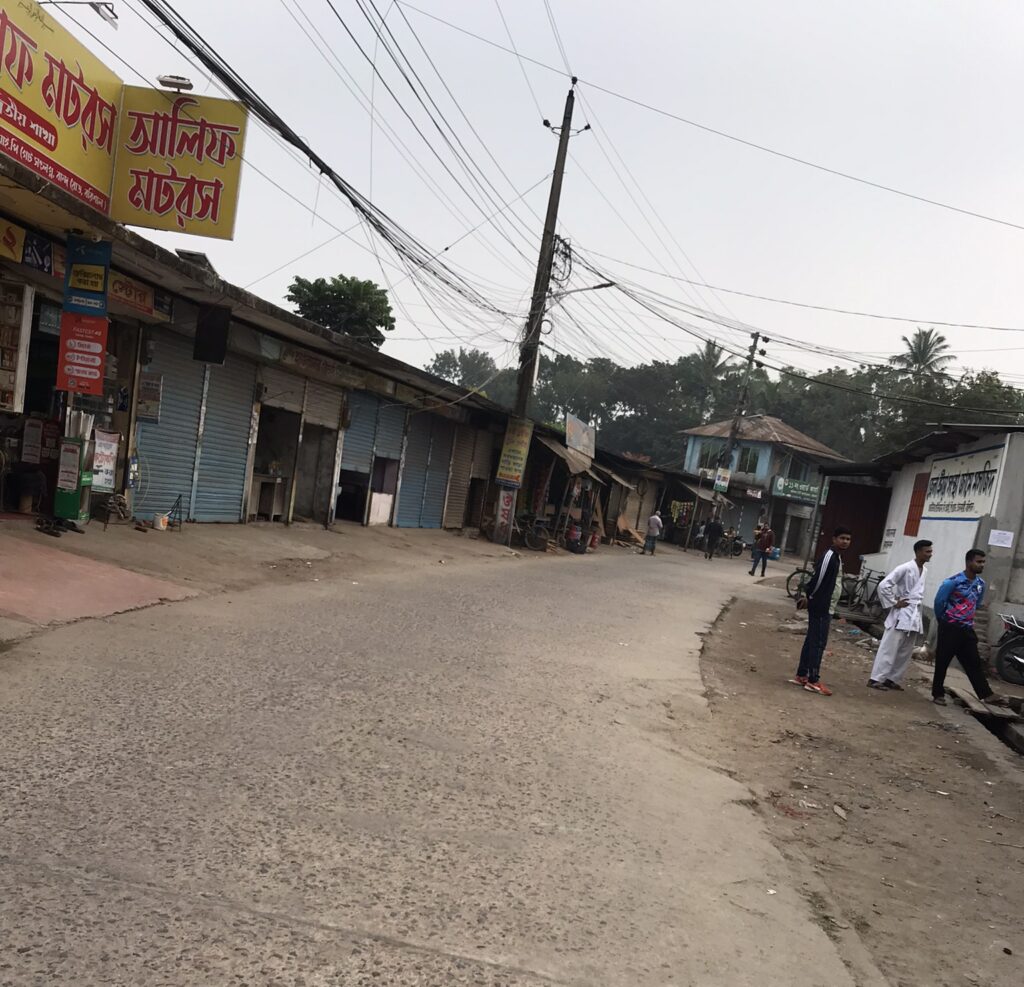
Barisal backstreets
The main intercity bus station in Barisal is Nathullahbad. This is where we were dropped off when arriving from Khulna and where we took the bus to Dhaka. The company ‘Sakura’ had a professional ticket office and waiting room with regular departures to Dhaka Gulistan. Rupatoli bus station to the south of the city is a more informal station, with buses mainly running southwards.
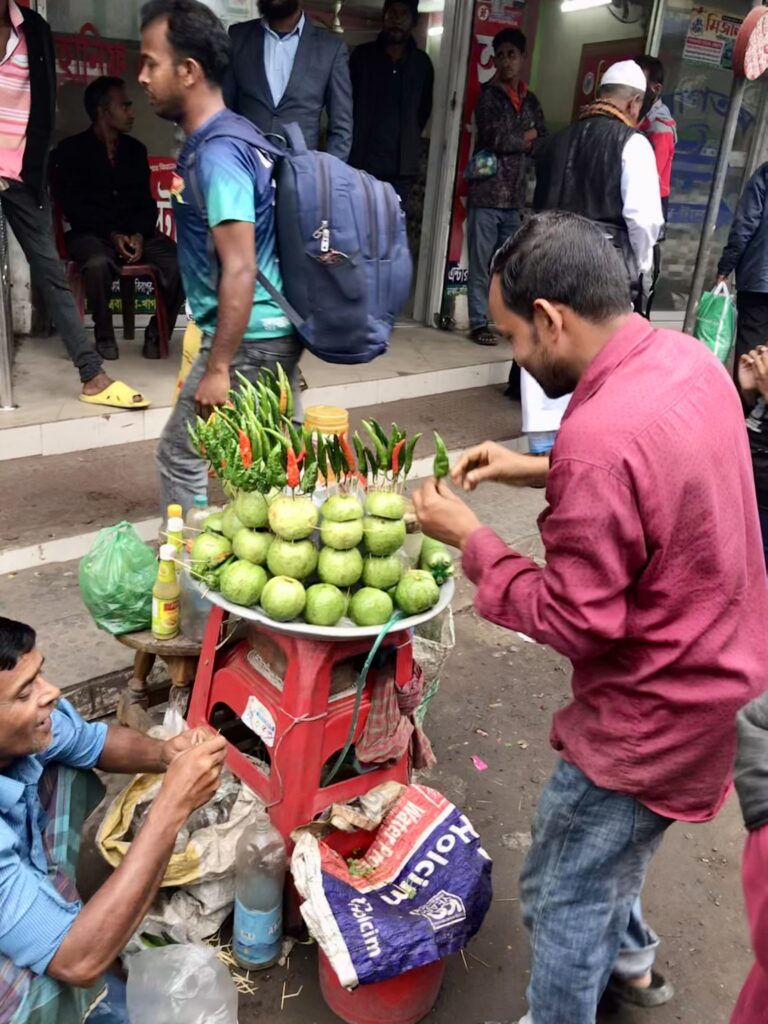
This guy was eager for us to try his strange fruit snack
Accommodation
Hotel Grand Park Barisal – a high-end, business-style hotel, similar to a Hilton or Radisson. This seemed like one of the only reputable places to stay in the city. Prices were high but we appreciated the included gym and swimming pool. Food prices were extortionate in the restaurant. The hotel overlooks Bells Park.
Foodie Places
Cinnamon – a pretty nice, upmarket-type restaurant with relatively low prices (it’s Bangladesh after all). The chicken chow mein was great.
Activities
Oxford Mission Church – an interesting religious building particularly as Bangladesh is an overwhelmingly Islamic country. Unfortunately the gate was closed when we arrived around sunset so we couldn’t go inside or have a proper look around.
Bells Park – at the time we visited, this park was hosting what looked like a local fair; a family event with activities and stalls. We had a quick look around and encountered many happy and friendly locals. We had to leave quite quickly before we attracted too much attention and caused a commotion – we would’ve struggled to get away from all the people that wanted to talk to us!

Fun and games at Bells Park
Riverside Walk along Kirtankhola river – the promenade along the river is marked as ‘30 Godown’ on maps, I’m not sure why. The promenade is a pleasant place to have a stroll and watch life along the river. Along the way we were inundated and swarmed by friendly and curious local children (and some adults) trying to practice their English.
Inadvertently stumbling upon a football game at Shahid Abdur Rob Serniabad Stadium – while walking past, we stopped to look at a small stadium that was being guarded by soldiers. It turned out that this was a trial match for the Bangladesh national u17s football team. The match was halfway through but the soldiers at the gate enthusiastically greeted us, invited us in to watch the football match and even gave us some sweets! We were then seated on the front row next to local officials including the local sports minister and treated like the guests of honour; offered water, snacks and even ended up being invited along with the officials into the team photos after the game! Many of the players and officials wanted selfies and Dan was even interviewed by a local journalist. After the boys match, there was also a girls’ u17 match as well. We were happy to see the girls being enthusiastically supported by the large crowd.
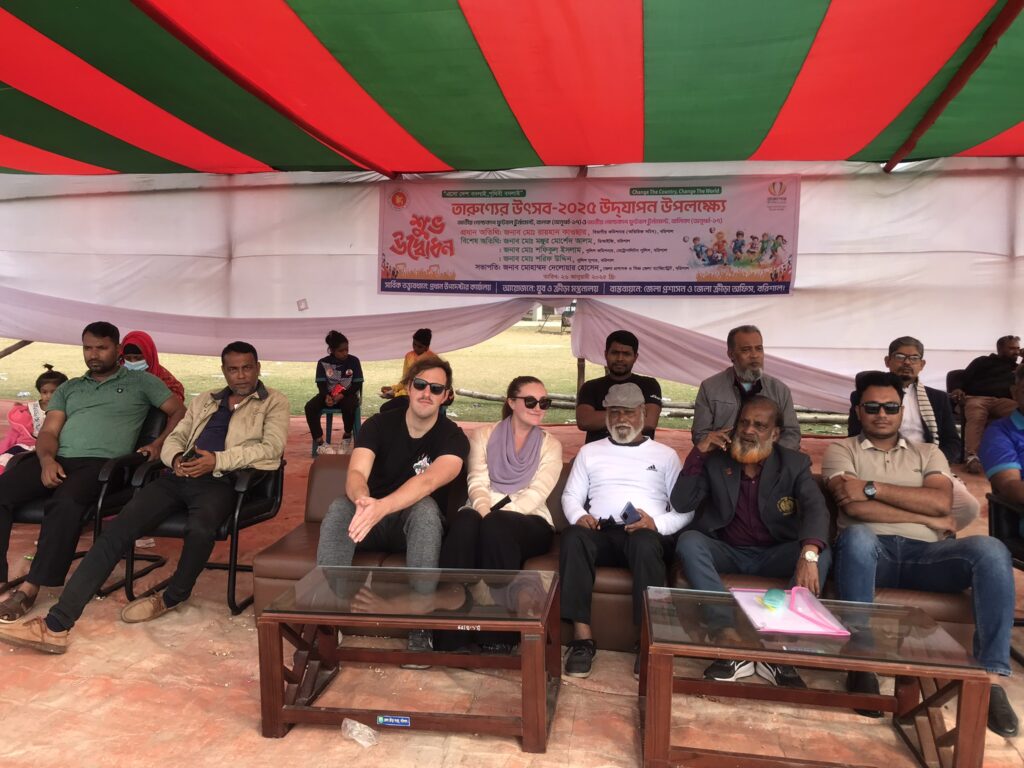
In the VIP seats
Dhaka
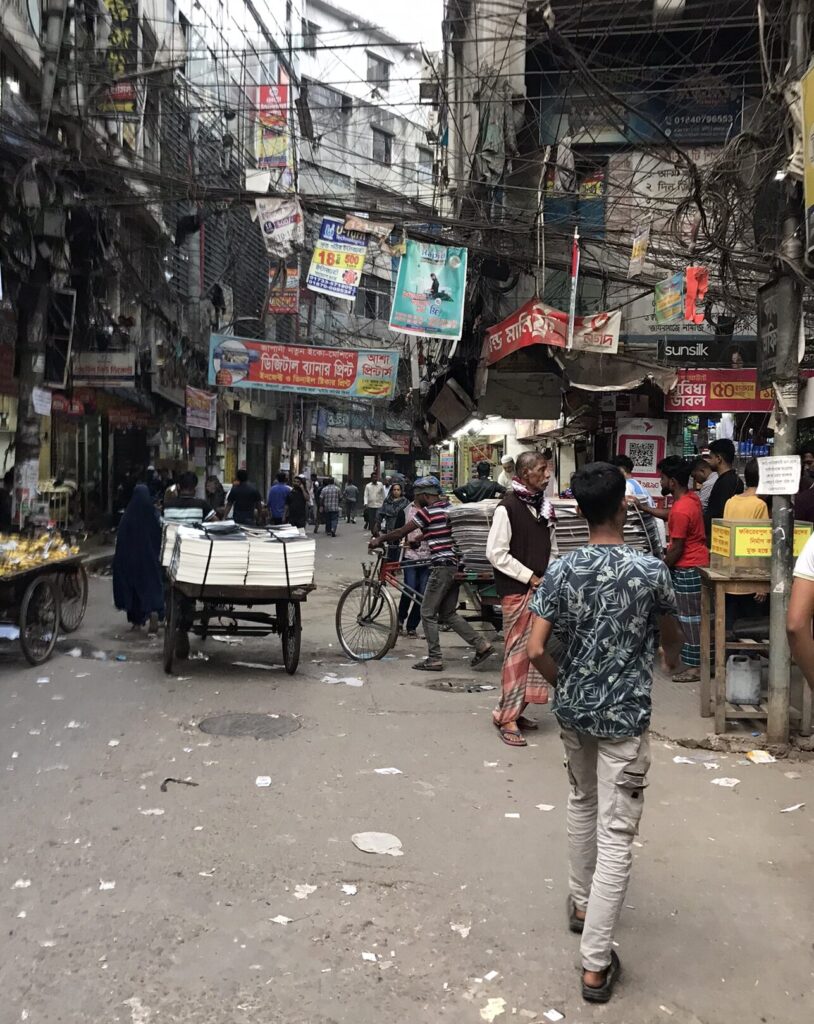
It’s safe to say that there is a lot going on in Dhaka, a swollen metropolis of winding streets, spidery passageways and crammed-in residential blocks in various stages of decay, with people of all demographics swarming the streets like ants. It’s often described as one of the most congested and overwhelming cities in the world. So it may sound strange to say that honestly we felt more relaxed walking around the streets of Dhaka than most major Indian cities. There were better pavements, less hazards, less honking horns, less cow and dog faeces on the ground. Generally we weren’t approached or hassled by scammers, hawkers or other annoying characters in Dhaka. Partly because of the large numbers of people around at all times, we were able to walk the streets of central Dhaka after sunset without really feeling uncomfortable or unsafe.
Many people assume the entire city of Dhaka is an overcrowded slum or some sort of dark hovel. However this isn’t the case. There are luxury, upmarket restaurants, well-maintained historical sites, good quality museums and fancy hotels. There are also areas of deprivation, the city can be an assault on the senses and is definitely not a place for the uninitiated. We stepped off the bus in Gulistan to be greeted with a cacophony of noise, people everywhere, market vendors crowding the streets and a general feeling of disorientation. Thankfully this feeling quickly passes as long as you have a plan in place and know where you are going and what you’re doing.
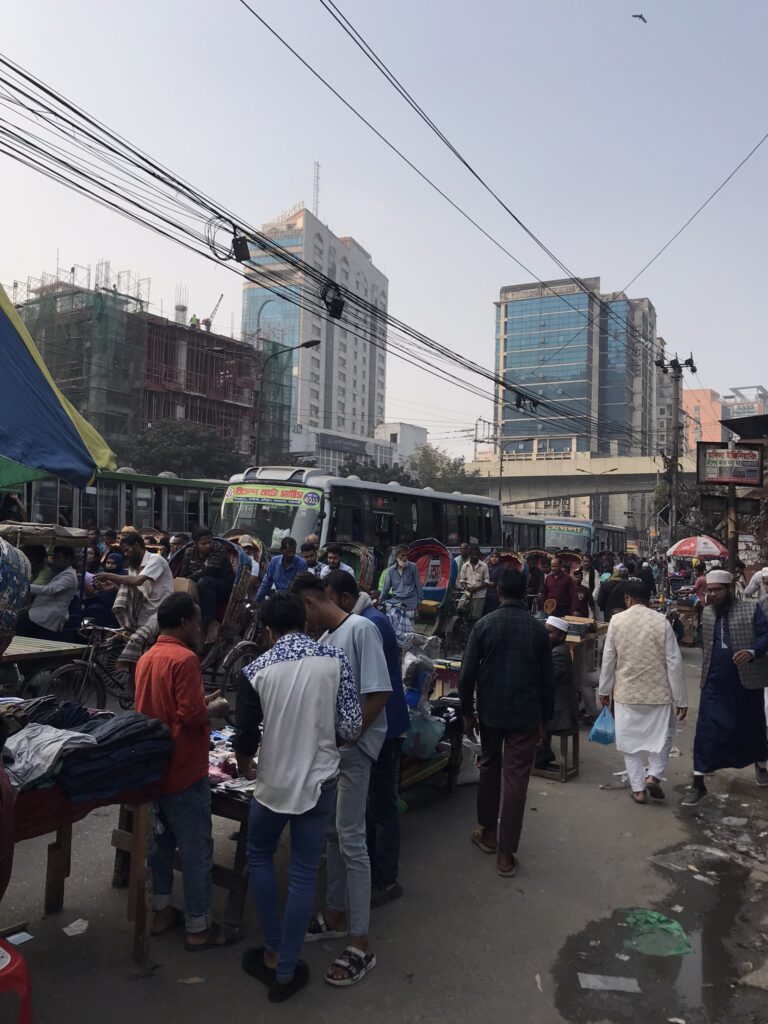
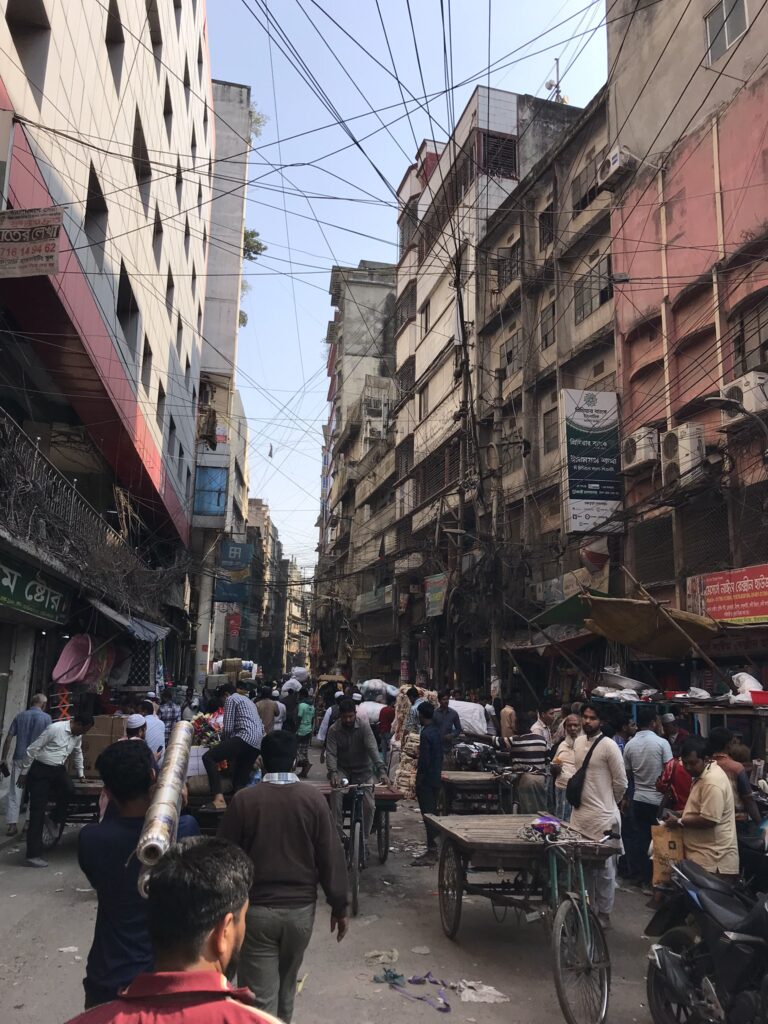
Yes, it’s busy and there is a lot going on
One of the reasons our experience in Dhaka was maybe more positive than the city’s reputation suggests is because of the Dhaka metro. Recently constructed, the metro provides an efficient, reliable form of public transport that cuts out a lot of the mania of the overcrowded streets and horrendous traffic jams. The metro only has one line so it doesn’t connect the whole city, but the major attractions are all just about walkable from the metro (usually between 30-45 minutes from the nearest metro station). We found very little info about the Dhaka metro before arriving in the city but were pleasantly surprised with how well it worked. The trains arrive at regular intervals, they are fairly comfortable and not massively overcrowded. There is a dedicated carriage for women, which adds to the feeling of safety. People on the metro are well-behaved; I was even told off by a woman for unintentionally queue jumping! For more info about the Dhaka metro, check my blog post here.
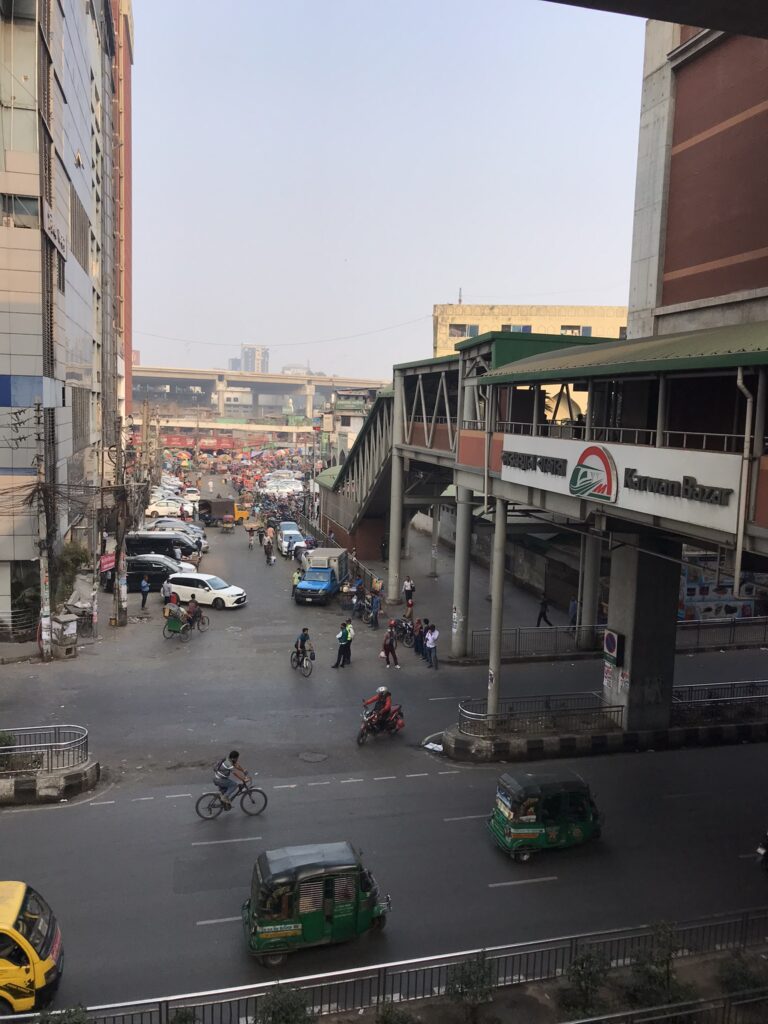
The Dhaka Metro was an absolute lifesaver for getting around the city
Uber exists in Dhaka but it doesn’t really work at all – the drivers will call, try to speak to you in Bengali and then most likely cancel the ride. We only used Uber once (to get from our hotel to the airport) and had to enlist the help of more than one hotel worker to actually get a driver to show up. It’s a lot of effort. I also recommend against using a CNG in Dhaka – on the sole occasion we flagged down a CNG from the street, the driver tried to scam us by doubling the price mid-journey despite us having written the agreed figure on a phone beforehand. We refused to leave and shouted at him until he gave in, but it wasn’t a great experience. If you do need a CNG, you’re more likely to find an honest driver by organising through your hotel.
Most of the city’s attractions are located in or around Old Dhaka. This is the most chaotic (and fun) part of town. We found the best way to get there was to take the metro to Dhaka University or Motijheel and then proceed on foot, which means taking a deep dive through the medina-like streets. It’s very difficult for cars to get around this area, so almost everyone is either walking or cycling. In my opinion, wandering through Old Dhaka and being immersed in the mayhem is an essential part of the Bangladesh experience. Along the way you’ll spot colourful, highly decorated cycle rickshaws, men carrying all manner of items on their heads, porters who seem to be dragging about 5 times their body weight on wooden carts and doddering older women stopping every 5 metres to browse the various stalls.

This is ridiculous
Other parts of the city are not so manic. Around Dhaka University, we were struck by the wide boulevards and newly-painted revolutionary murals along many of the walls, with themes of justice, freedom, womens’ rights and some socialist imagery. From what we could tell, these murals were created around the time of the 2024 student protests which led to the ousting of the former leader, Sheikh Hasina.

These elaborate murals are all over the streets surrounding Dhaka University – they were created during the uprising in July 2024
Accommodation
We were a little apprehensive about the accommodation situation in Dhaka. However we couldn’t have been more wrong after finding HOTEL STUDiO23 – it was a real gem and safe haven in the city for us. We stayed there twice. One of the best aspects was the closeness to the metro station, providing easy transport links. If visiting Dhaka, I definitely recommend finding a hotel within walking distance of the metro.
HOTEL STUDiO23 – A western-standard business-style hotel with great transport links – the metro was about a 5 minute walk away. Comfortable, quiet and clean. We loved that the hotel had a cafe where we could grab lunch or dinner, the food was very tasty and the prices very reasonable. The reception and restaurant staff were very professional and helpful. Overall an excellent choice for foreigners in Dhaka.
Foodie Places
The Courtyard at Park Heights – a high-end classy establishment, on the higher end of the price spectrum catering towards the well-to-do crowd. Bao buns, rice bowls and kathi rolls are just some of the trendy dishes on the menu. The interior was very modern and service was top notch!
Coffee Cookers 7 Restaurant – we underestimated this humble khichuri joint close to the metro – a business which has been around for years, it claims to be the best khichuri place in the whole of the country and I can’t really argue. If you want to try khichuri, go here. The servers spoke little English but were very courteous with us.
KFC near Lalbagh Fort – we struggled to find any reputable eateries close to Lalbagh Fort so ended up eating at KFC. It’s not terrible as a last resort choice. The servers inside seemed to be a little disoriented and confused.
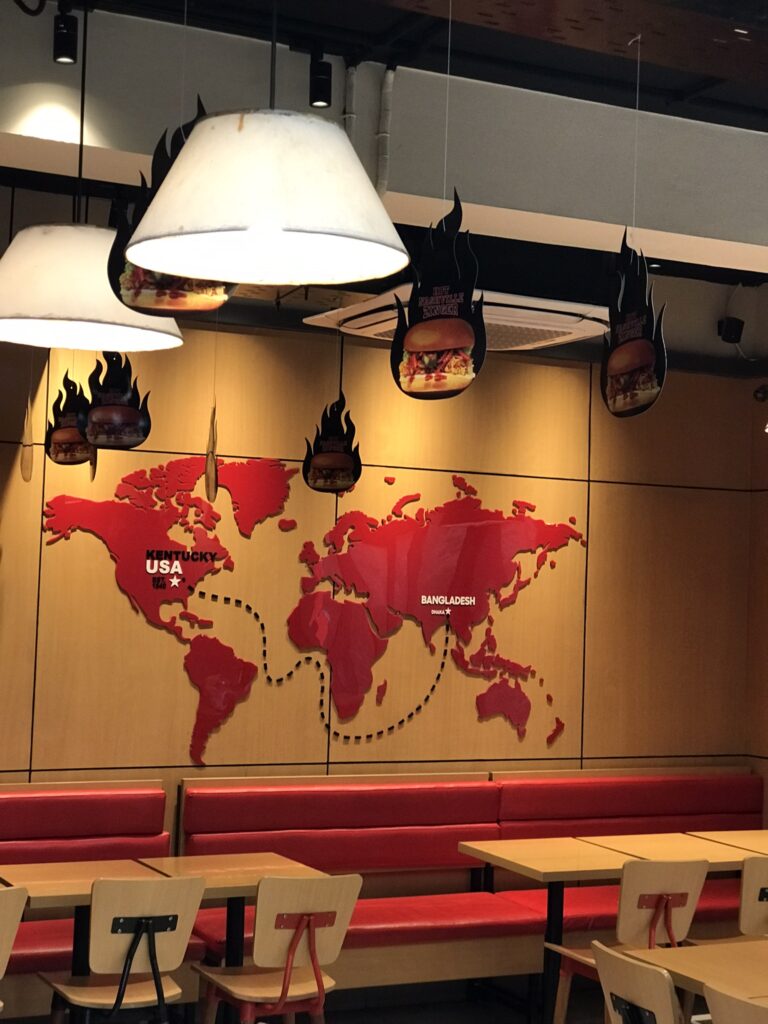
From Kentucky to Dhaka
Activities
Ahsan Manzil Palace – overlooking the Buriganga river, this resplendent palace resembles a pastel pink wedding cake. Prior to it being repurposed into a museum, the palace belonged to the Nawab (ruler) of Dhaka and was his official residence in the city as well as a lodging for important guests and high-ranking members of the British Raj. Inside the palace are a variety of exhibits focused on the history of the Dhaka Nawabs and the building itself, with some original items on display.
Some of the rooms have been restored to give visitors an idea of the grandeur of the Palace in its original form, including the billiard room, impressive dining hall and spacious ballroom. The grand staircase and open veranda provide perfect photo opportunities. The most memorable aspect of the palace is definitely the exterior – the quaint outside garden is likely to be full of locals taking photos (and you might end up in some of them too)
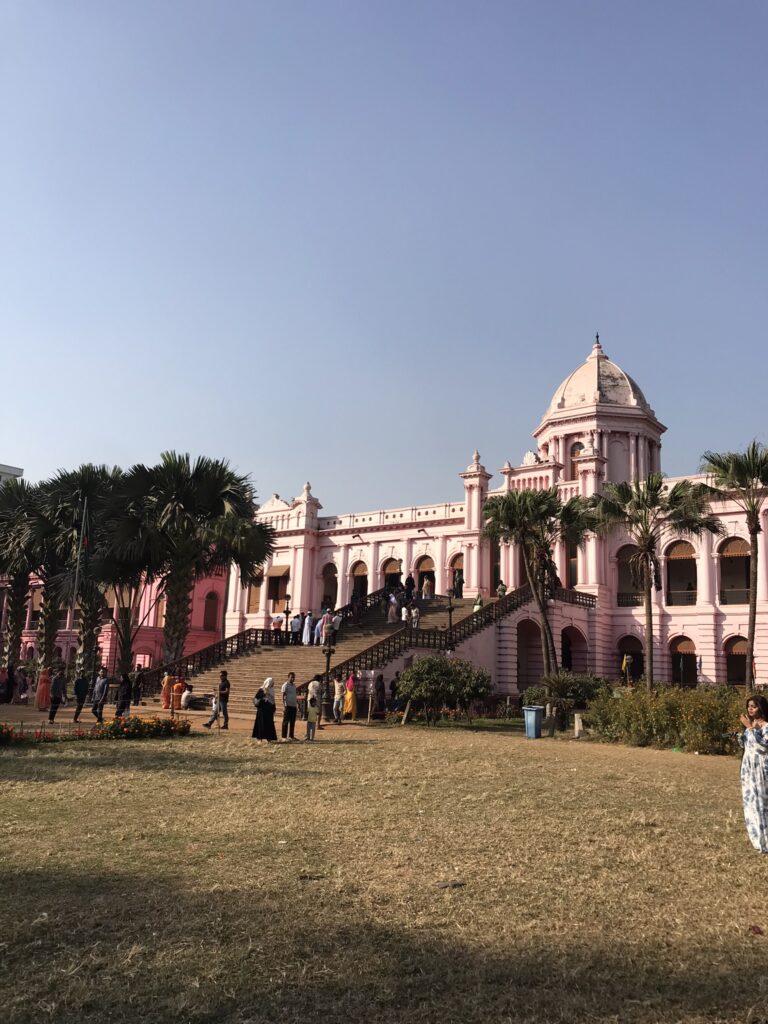
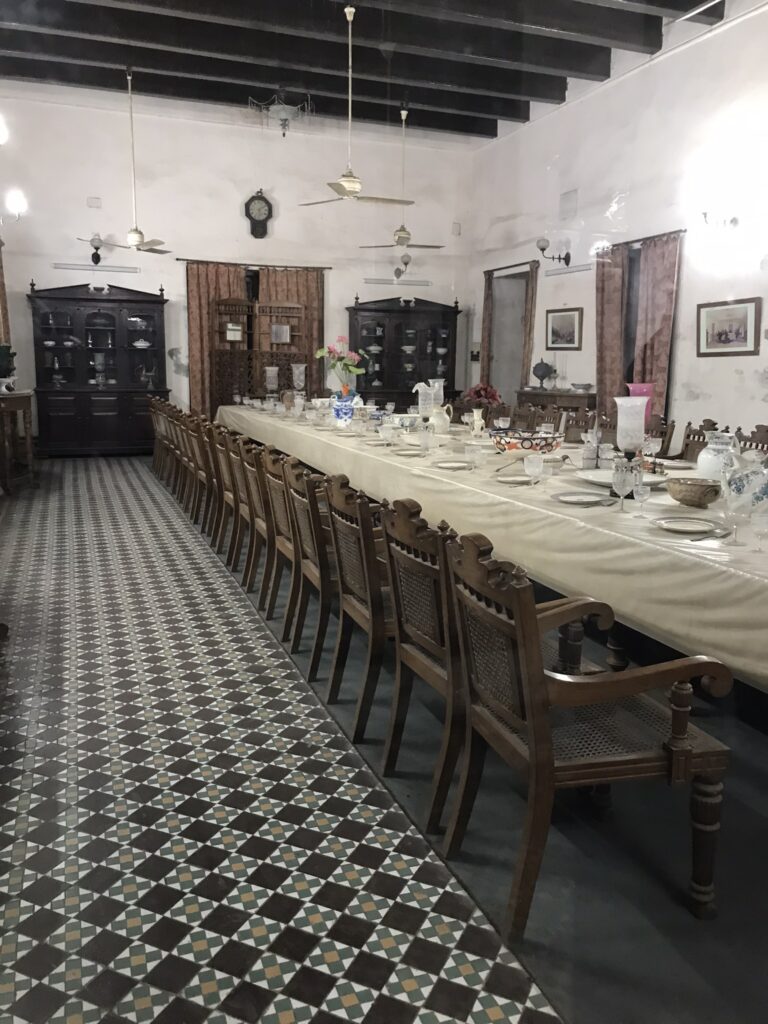
Ahsan Manzil Palace looks like something from a fairytale – the museum inside recalls the glory days of the Nawabs and the British Raj
Lalbagh Fort – The most visited tourist attraction in the city, the fort is a fine example of Mughal architecture. Its existence is a testament to the sheer size of the Mughal empire which stretched all the way to Dhaka from northern India and Pakistan. The fort was built by the Mughal Prince Muhammad Azam Shah during the reign of Emperor Aurangzeb. Interestingly, the fort complex was never completed as construction was halted due to the ill-omened death of Bibi Pari, the daughter of the high-ranking Mughal official who took over when the Prince was called away.
Within the walls of the fort are lush gardens with neat flower beds which add to the tranquil ambiance of the place, offering a peaceful escape from the grim hustle of Dhaka city. The structures that are standing inside the fort today are the Mausoleum of Bibi Pari, the Diwan-i-Aam (Audience Hall and Hammam) and the mosque (which was closed to visitors when we were there), all of which reflect the elegance of Mughal design. A man with a key hovering around the Diwan-i-Aam offered to show us around, unlocking the door to the first floor for us and sneaking us into restricted areas for baksheesh.
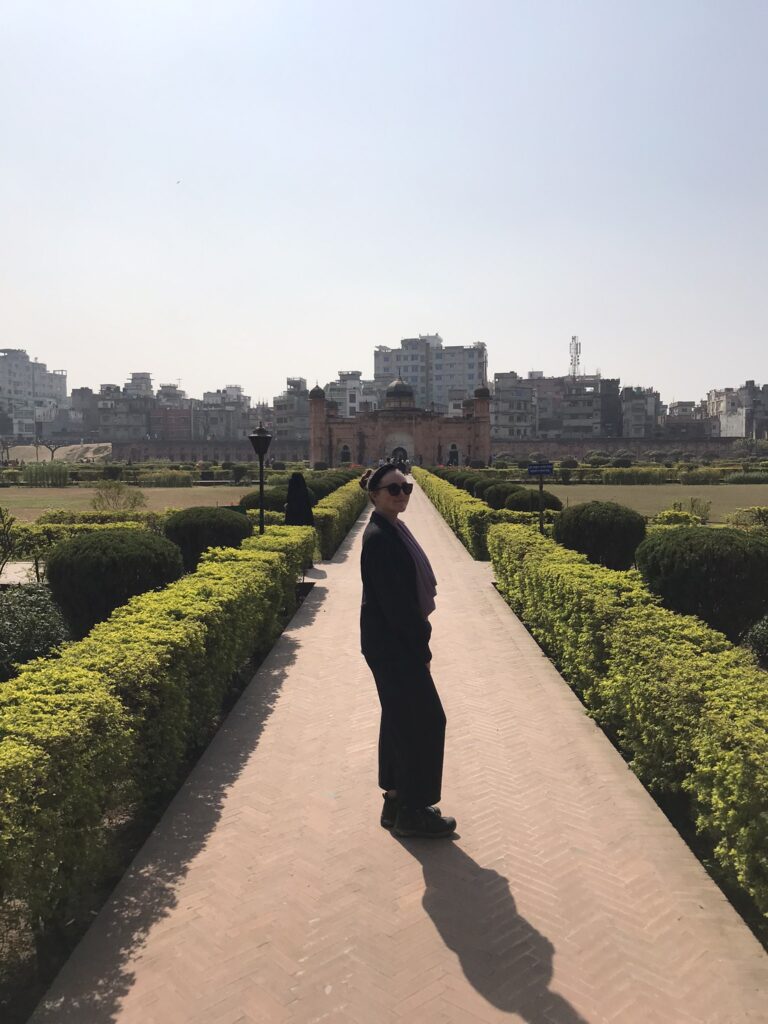
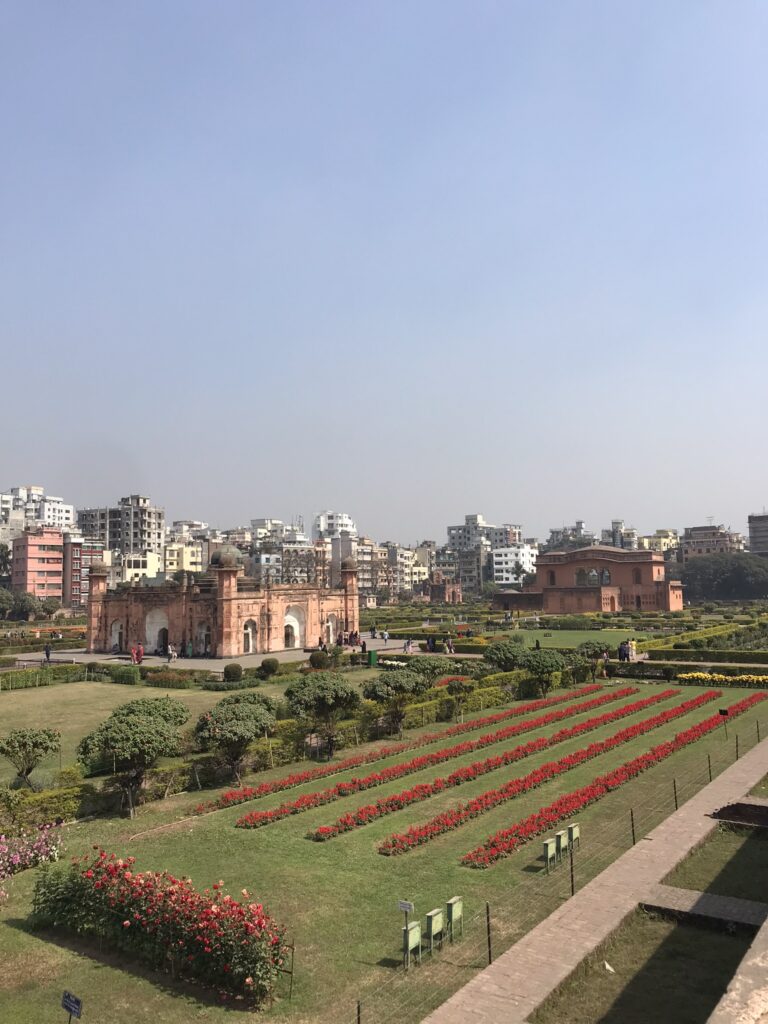
Lalbagh Fort is a garden of tranquillity in the mad city
Bangladesh National Museum – a very comprehensive museum covering everything from nature and palaeontology, historical artefacts and ancient weapons through to ethnography, clothing, furniture and a section on Bangladesh’s war of independence with Pakistan. We spent a very long time in the museum, partly because of the amount of excited locals that wanted to chat to us inside.
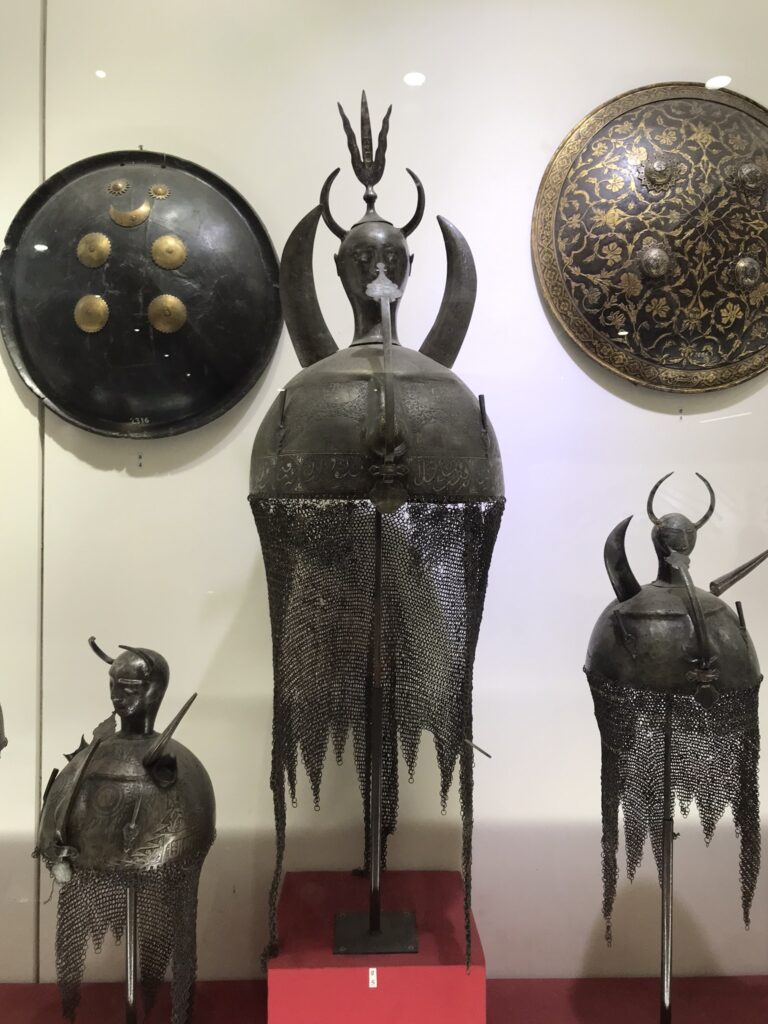
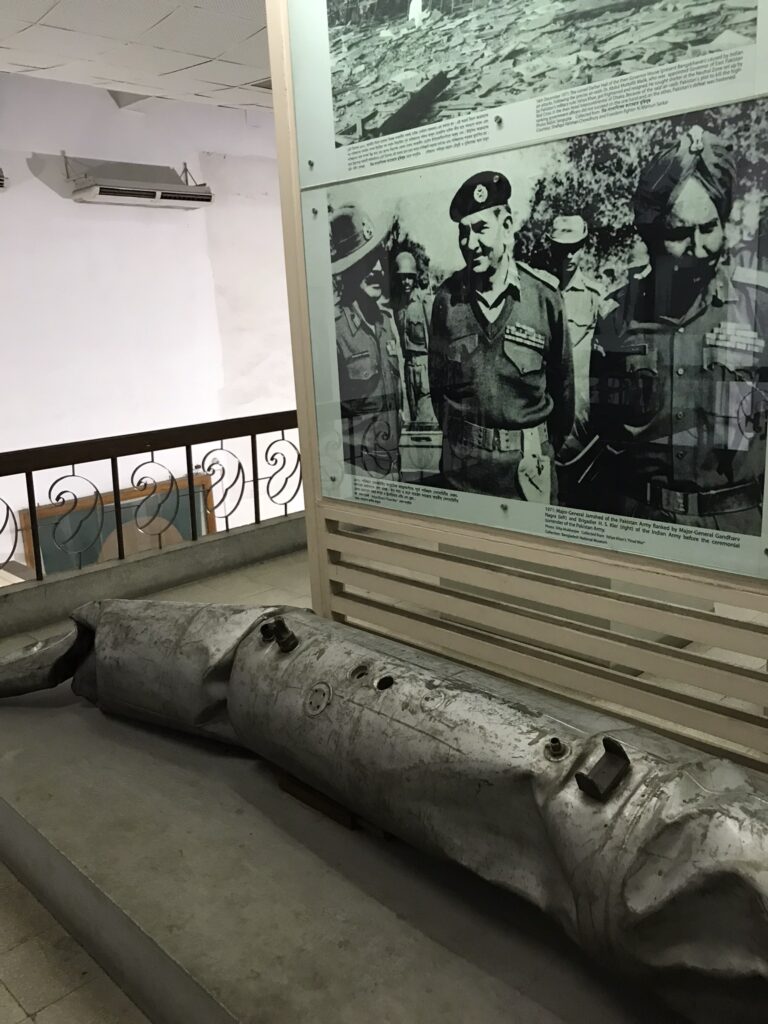
The museum is really extensive, covering everything from nature and displays of ancient artefacts to ethnography and modern history
Armenian Church – a testament to the small community of Armenian traders who once called Dhaka home. Armenians were sent to Dhaka in the 17th century after their country was incorporated into the Persian empire and remained until the 1900s. For a small tip the warden will let you have a poke around the church and graveyard. It’s interesting to see the various Armenian gravestones and hear the story of the church’s history and maintenance. Mother Teresa supposedly stayed at the church during a trip to Dhaka. When we enquired if any Armenians were still around, we were told that sometimes the Armenian Bishop of Asia and Australasia visits.
Sonargaon
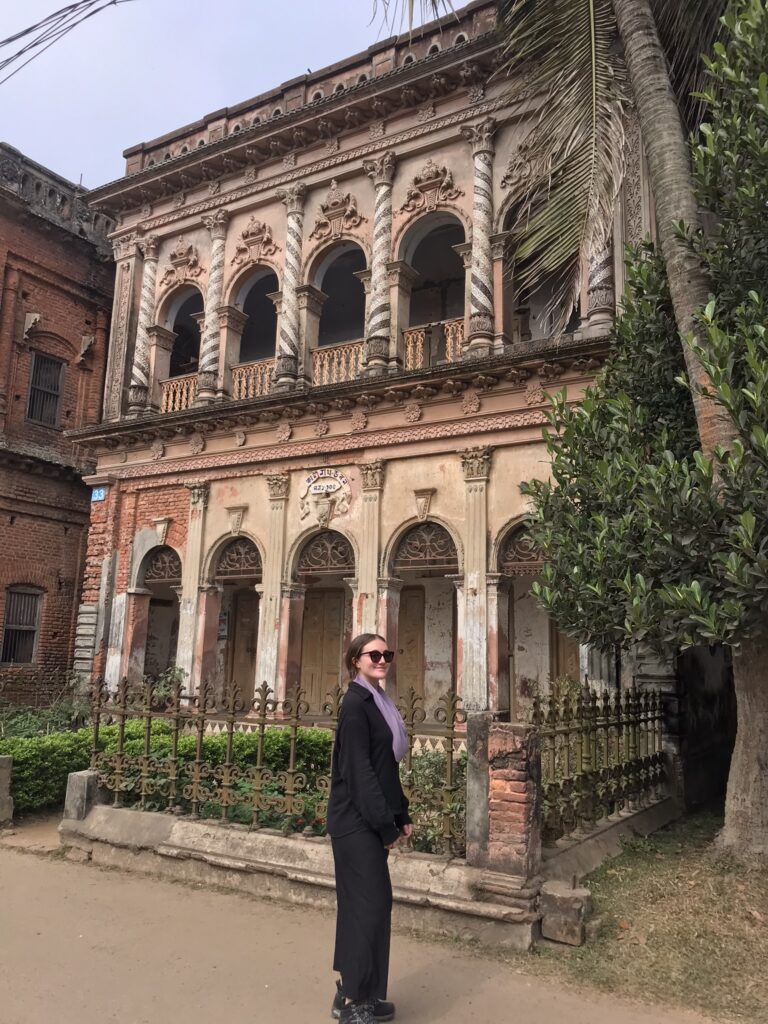
The historic city of Sonargaon is an easy day trip from Dhaka. Sonargaon is the former capital of the Bengal region, playing host to various sultanates and dynasties over the years before the centre of power was moved to Dhaka during the Mughal period in the 17th century. Sonargaon continued to be an important city and saw a revival during the British colonial period, when many Hindu merchants moved to the area. Today it is a relatively small and quiet city which has been absorbed into the larger Dhaka urban area. Sonargaon now mostly draws visitors to its museum and the ruined neighbourhood of Panam City, a protected area filled with the abandoned mansions of the wealthy Hindu merchants who left after Partition in the 20th century.
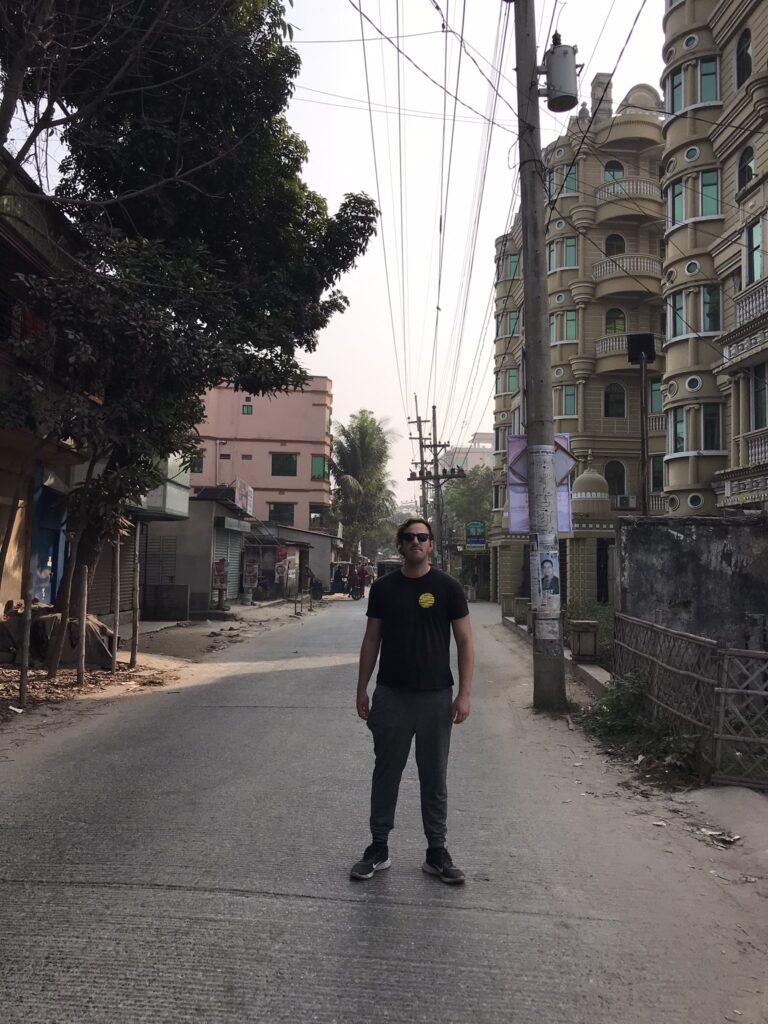
On the streets of Sonargaon
To get to Sonargaon from Dhaka you can get the bus from Gulistan (walkable from Bangladesh Secretariat metro station) to Mograpara. Gulistan is described by locals as a bus terminal but it’s really just a chaotic few blocks of streets filled with market stalls and buses everywhere. It’s an overwhelming place and difficult to navigate but we actually found the right bus pretty easily. After walking for a little while, we saw a guy sitting under a gazebo at the side of the street selling bus tickets. We asked the guy for Mograpara, he said yes, sold us a very cheap ticket and then took us to a bus which departed straight away and dropped us off exactly where we expected here in Mograpara. From the Mograpara bus stand it’s about 25 minutes walk to Sonargaon, and a little further on to Panam City.
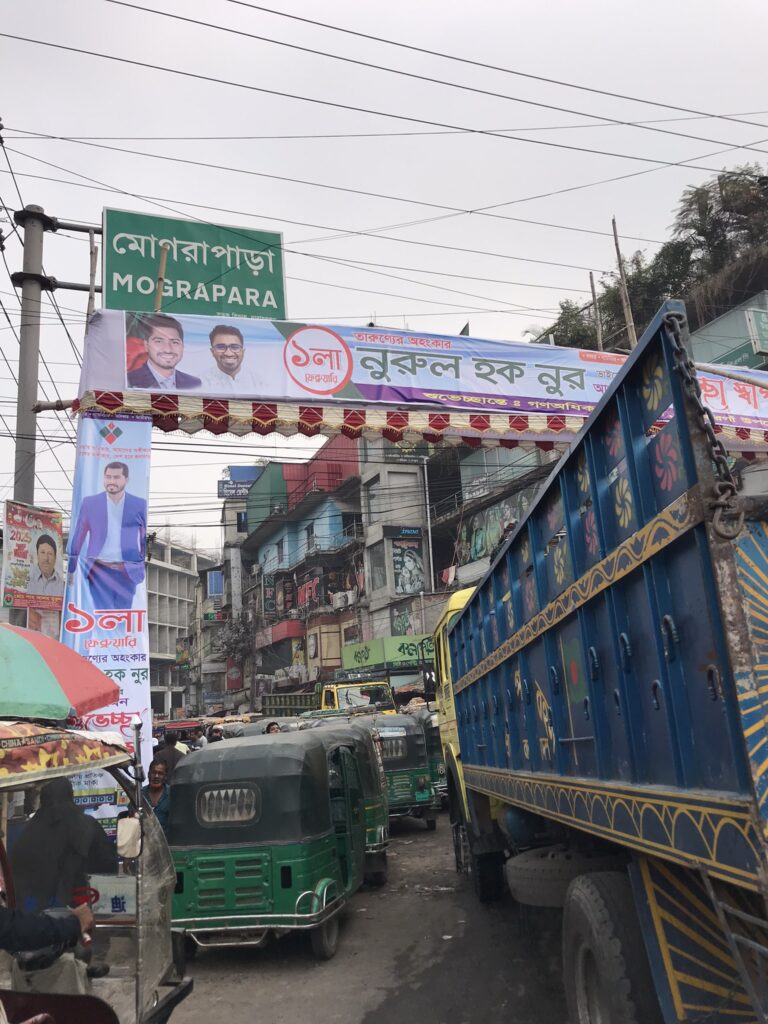
Tuktuk armageddon in Mograpara heading towards Sonargaon – it’s quicker to walk
Panam City – this is essentially a single long street filled with once grand but now crumbling and dilapidated mansions. The mansions used to belong to upper-class Hindu merchants who made their money in the cloth trade during the British colonial period. They were abandoned when the Hindus fled following the Partition of India. These townhouses contain a mixture of Mughal and European architectural styles. A visible sign of the former wealth and prosperity of the city.
The area stood in ruin for years before being recognised and protected for its historical value. Apparently the government had to evict illegal occupants from some of the houses. The neighbourhood is now a ticketed tourist attraction complete with friendly tourist police. The decadent ruined buildings make a popular instagram spot for locals and we saw plenty of impromptu photoshoots happening here
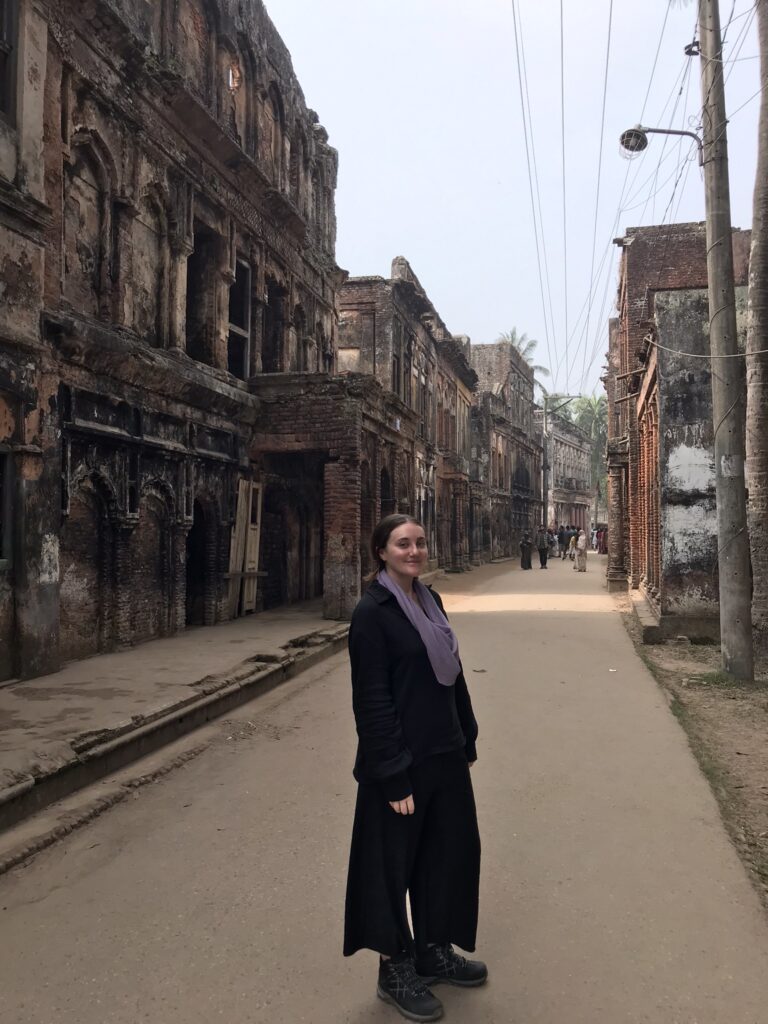
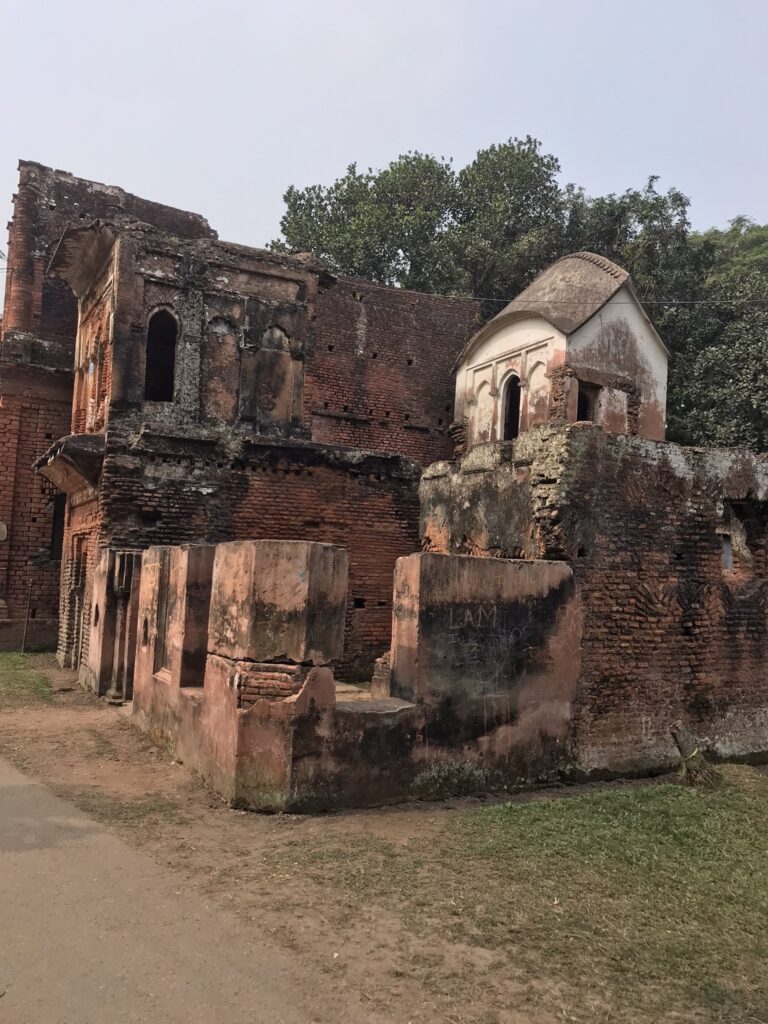
Ruined grandeur in Panam City
Bangladeshi Folk Arts and Crafts Foundation/Sonargaon Museum – the Folk Arts and Crafts Foundation is a ticketed complex, the admission ticket includes access to the museum and surrounding park which has a water tank and various other minor attractions. The museum itself mainly focuses on Bangladeshi arts and crafts. It has three floors with both typical and historical items highlighting traditional Bangladeshi handicrafts such as woodwork, ironwork, weaving etc. The grounds also contain a restored palace, Bara Sardar Bari, which is an additional cost and looked quite busy when we visited so we didn’t go inside – the view of the palace from across the water tank was good enough for us.

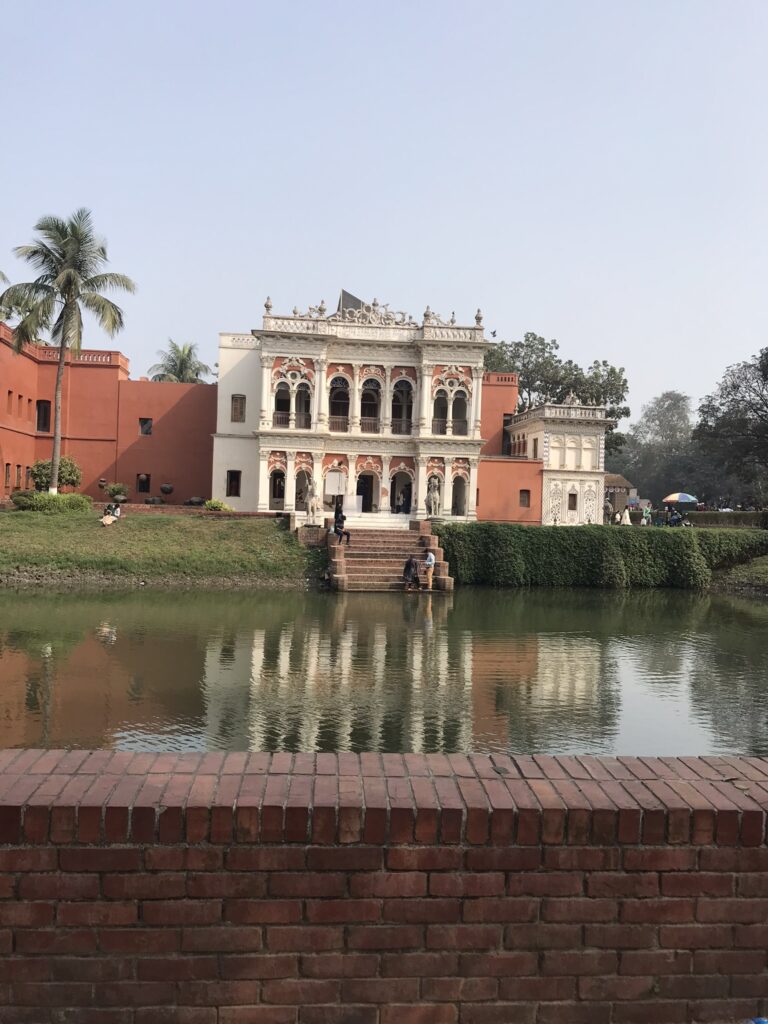
The complex contains a handicrafts museum and a palace – there is an extra charge for entering the palace
After visiting Sonargaon, we walked back to Mograpara and were able to get a bus back to Dhaka from the same spot that we were dropped off.
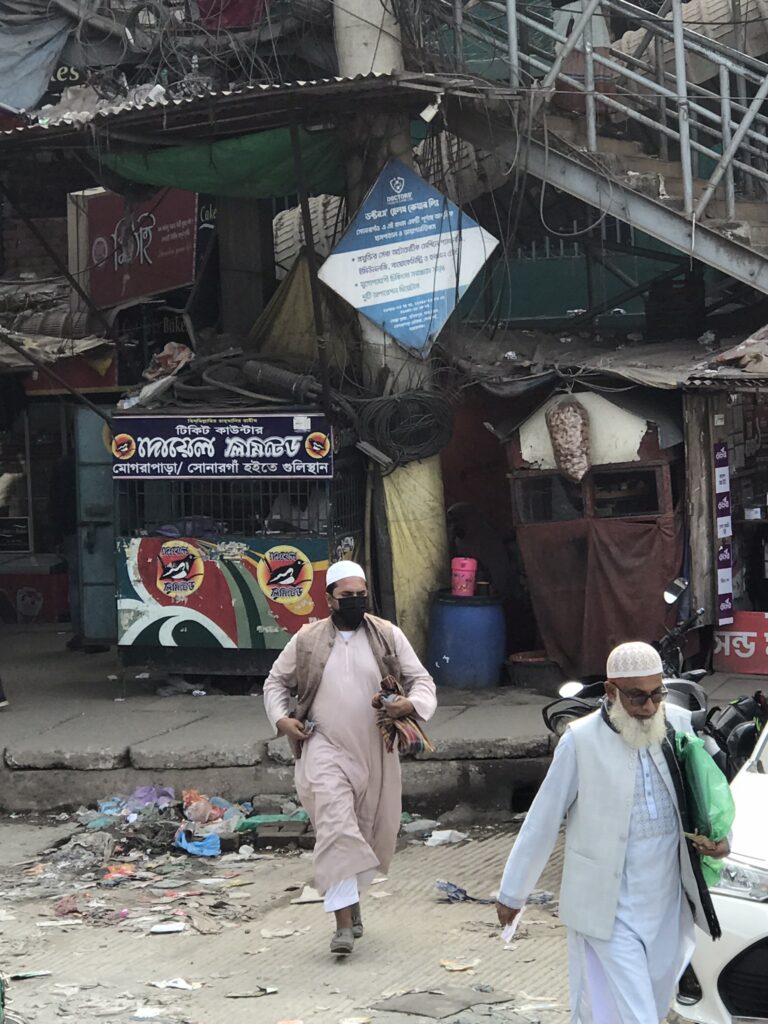
This little hut in Mograpara was selling bus tickets back to Dhaka
Sreemangal
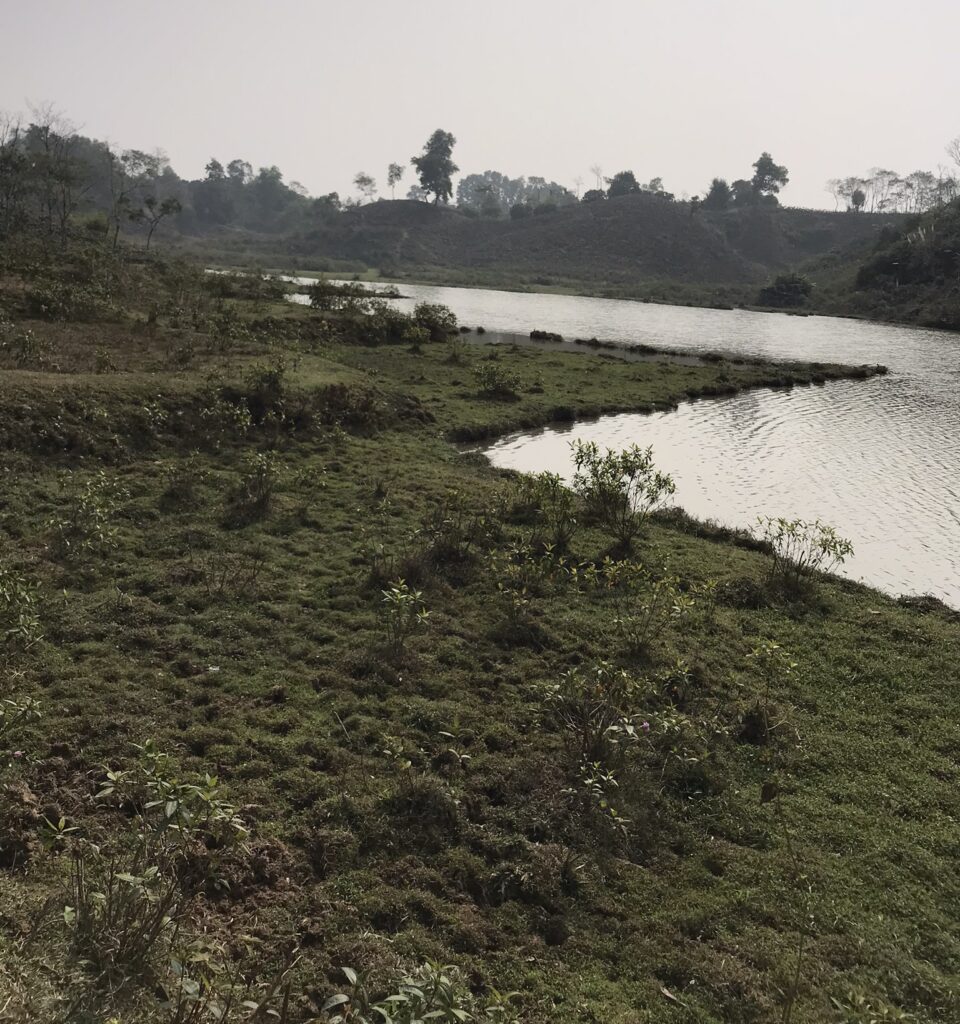
Known for its sprawling tea estates, Sreemangal is considered the tea capital of Bangladesh and is one of the most picturesque places in the country. The whole area is literally surrounded by lush tea gardens and plantations, as well as rubber plantations (which is the other key local industry). While the city centre of Sreemangal is quite crowded, chaotic and unpleasant, the tea plantations and the nearby countryside are a great place for a wander, particularly the enormous Finlay tea estate.

Sreemangal is surrounded by tea gardens and great countryside
Our time in Sreemangal was greatly enhanced by the fact that we encountered Christine, a French lady who was staying at our hostel and had been in the region for several months. Christine agreed to take us around the tea gardens and show us the best walking routes. Without her we would’ve been far less confident entering the tea garden, but as it is we walked around the entire estate freely without any problems. Domestic tourists have sometimes been denied entry to the tea estates on weekends, but nobody was making any attempt to control admission at the time we were there.
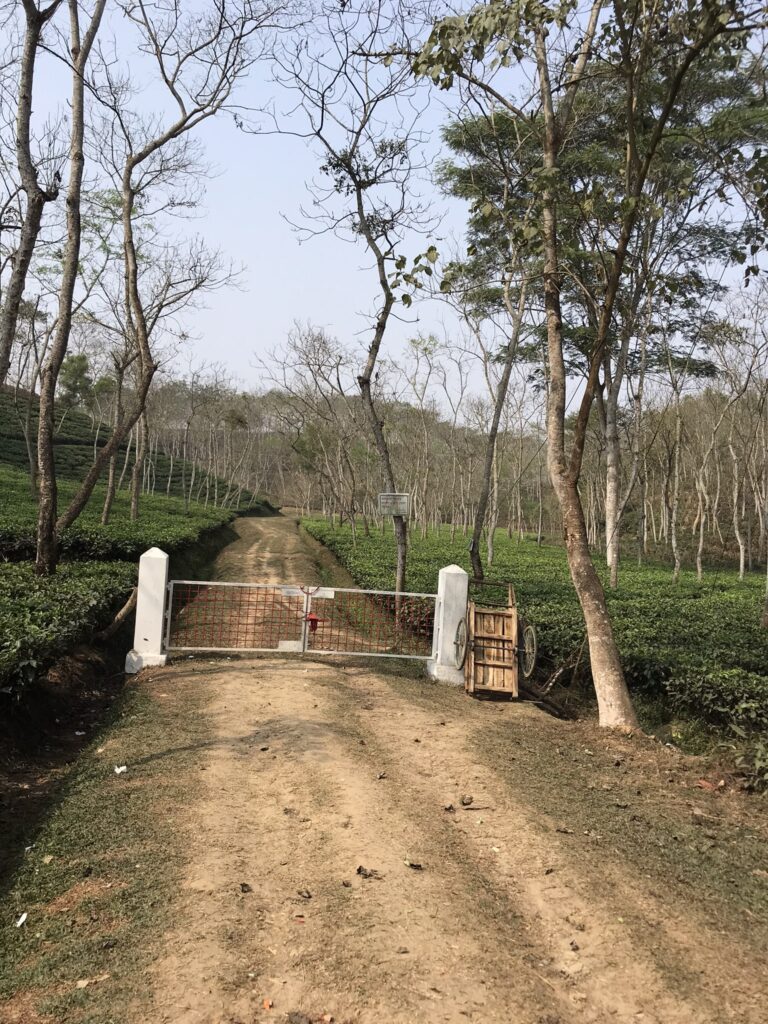
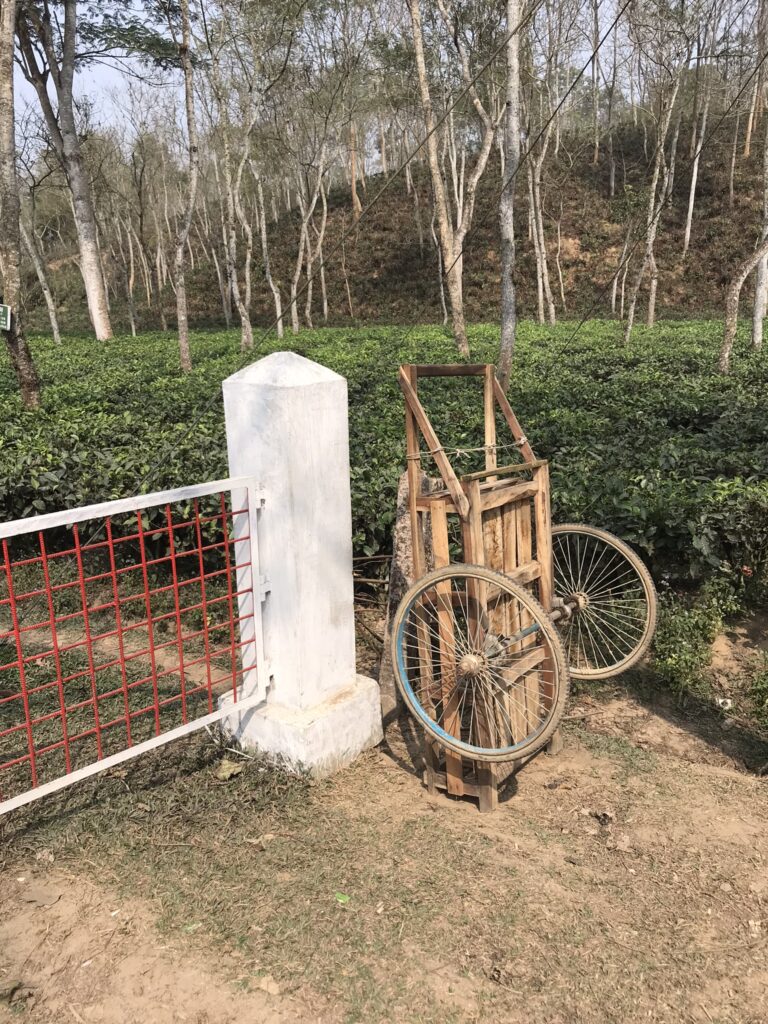
The entrance to the Finlay tea estate from the main road was closed off to vehicles, but we were encouraged to move the barrow and walk in
You can get to Sreemangal via a direct bus from Dhaka. It’s important to note that despite their proximity, there are no buses between Sreemangal and Sylhet (at least none that we could find). If you want to travel between Sreemangal and Sylhet, the only way is to get the train. There are at least a couple of trains per day – we went to the station the night before and were able to purchase a ticket. While the journey itself doesn’t take long, the train we took was very significantly delayed so don’t count on a fast journey.
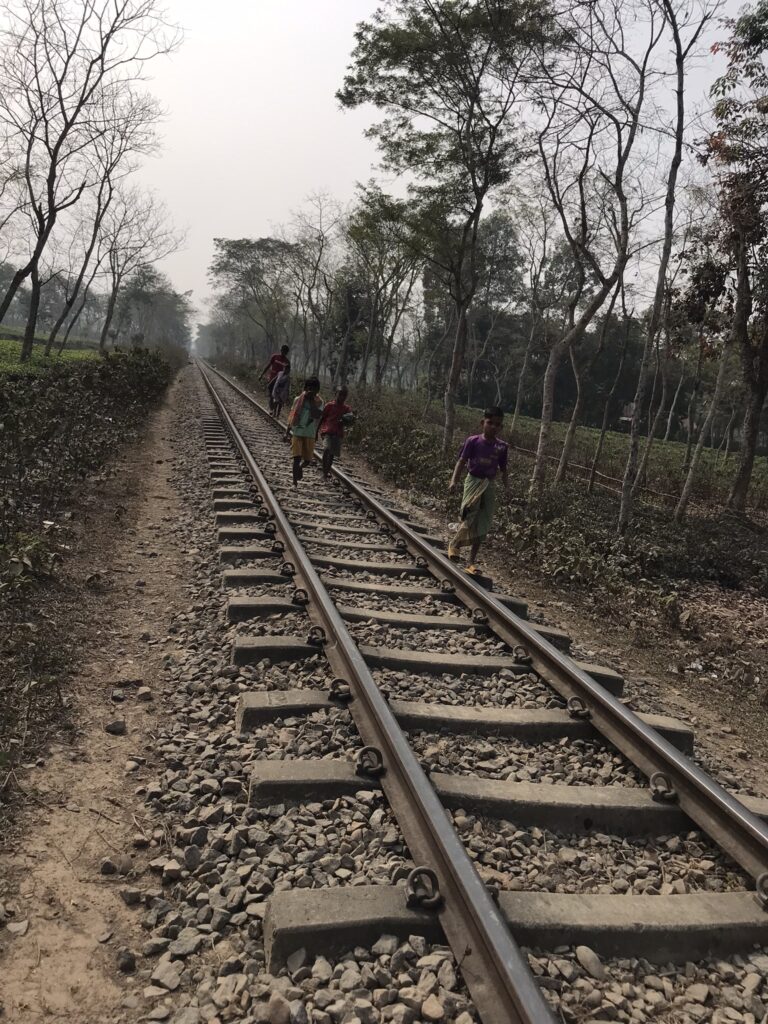
The train tracks run right through the tea gardens next to the town
Despite Muslims making up over 90% of the population of Bangladesh, we discovered that almost all of the low-paid tea pickers in the Sreemangal area are Hindu women. Throughout our travels to various tea-growing regions in India, Sri Lanka and Bangladesh we were consistently told that women make better tea pickers than men due to their dainty, dexterous hands which are perfect for plucking the tips from waist-high tea bushes.
These Hindu ladies and their families live in fairly isolated villages close to the tea plantations in which they work daily. We even noticed a Shiva shrine in the midst of the Finlay tea plantation so that the Hindu workers could worship without the need to leave their workplace. Across the board, female tea plantation workers are paid a pretty meagre wage for backbreaking labour, toiling in all weather conditions in the fields. We did spot a clear divide between the Hindu community and the rest of the population in Sreemangal. It was a humbling experience to watch these hard-working ladies in action.
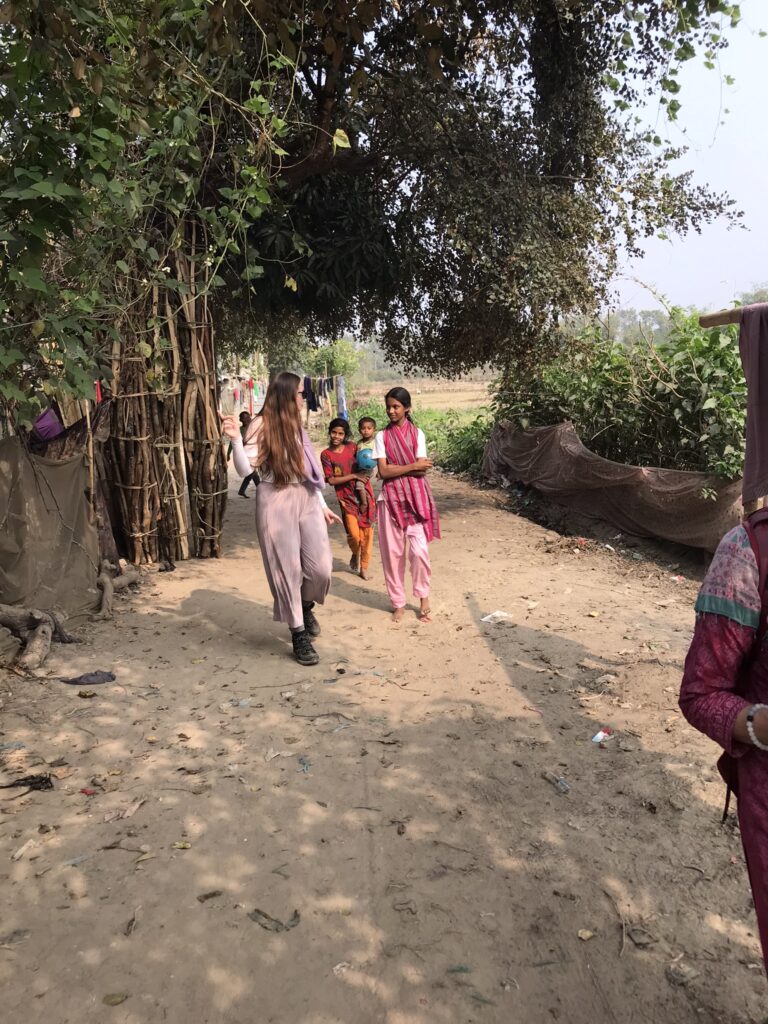
The small Hindu settlement is just outside the main town but feels a lot more rural
Accommodation
Green Leaf Guesthouse – don’t be scared off by the lukewarm reviews, the guesthouse is more like a hostel than a hotel with areas for socialising outside the rooms. The rooms are pretty basic but ideal for budget conscious travellers. We chose to stay here to be close to transport links (i.e. train station and bus depot), both of which are within walking distance. The manager was very friendly and helpful – he even treated us to a Bengali breakfast which was a really authentic and nice experience.
Foodie Places
We struggled to find highly rated restaurants in the centre of Sremangal and ended up eating quite a few times at Kacchi King – however they mostly serve Kacchi and don’t really offer other options.
Kacchi King – a down-to-earth inexpensive restaurant, unsurprisingly specialising in kacchi
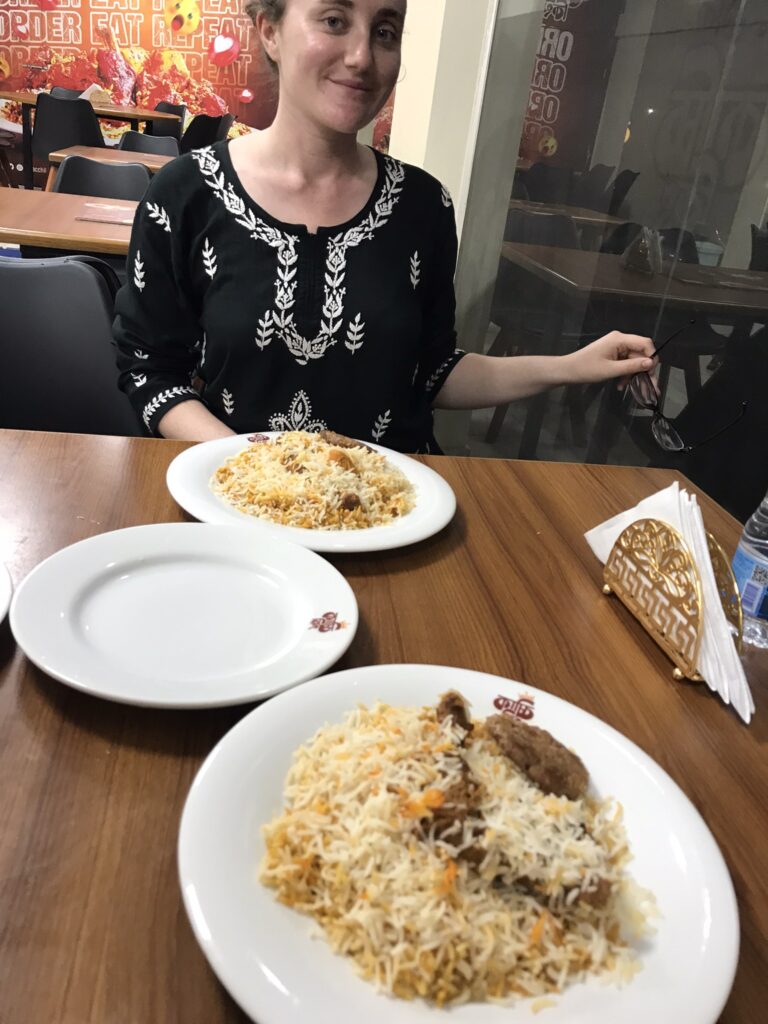
Kacchi really is king at Kacchi King, there’s nothing else on the menu
Treat দে – a pretty average cafe with chicken burgers and pasta available – it’s nothing special but beats another day of kacchi for dinner. We ate here and didn’t get ill. Finding the entrance to the cafe-cum-restaurant is not very straightforward as it involves entering the arcade and going up the stairs.
শ্রীমঙ্গল – a roadside teahouse on the main road near the gate to the tea plantation. We enjoyed a nice cup of tea and some cake.
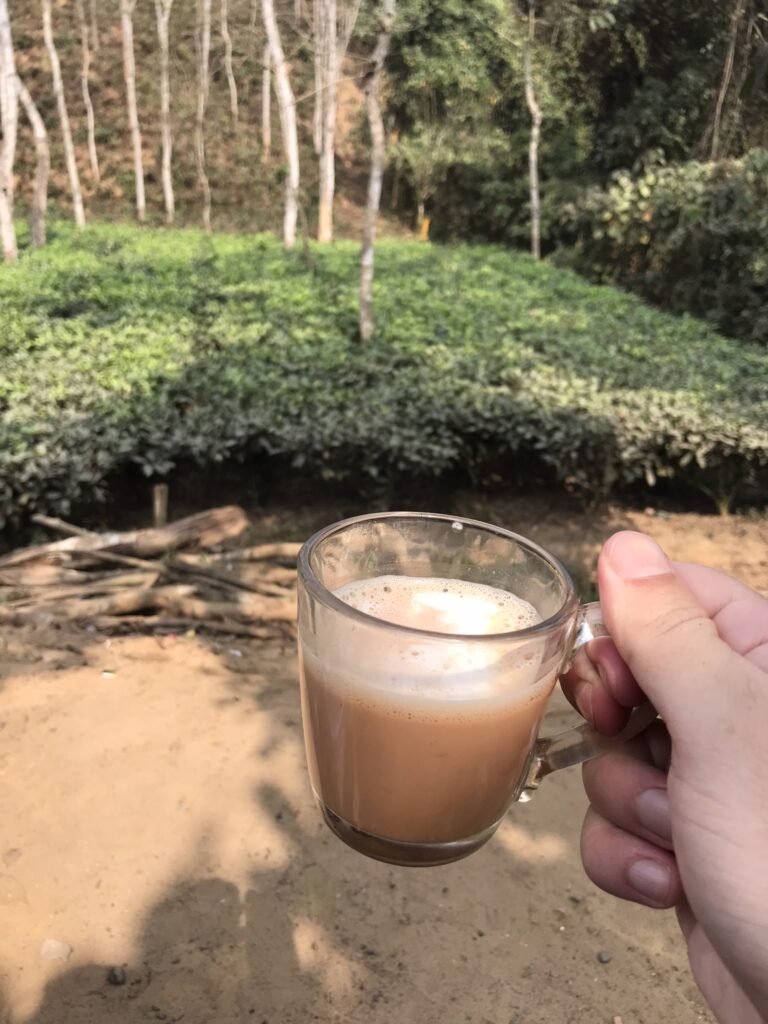
What it’s all about! This place is located right next to the entrance to the Finlay Tea Estate on the main road
Activities
Finlay Tea Estate – the entrance is closed from the road on weekends to stop Bangladeshi tourists from driving in and potentially harming the plantation. We walked around the estate freely with Christine – no one challenged us. We entered the tea garden from here, which is also close to the Hindu village. Workers are constantly trimming the tea bushes so that they don’t become overgrown and continue to produce new tea leaf shoots which make high-quality tea. Some areas of the plantation are bursting with vivid green bushes whilst other areas have been trimmed, so don’t be disappointed if you only stumble upon bare bushes to begin with.
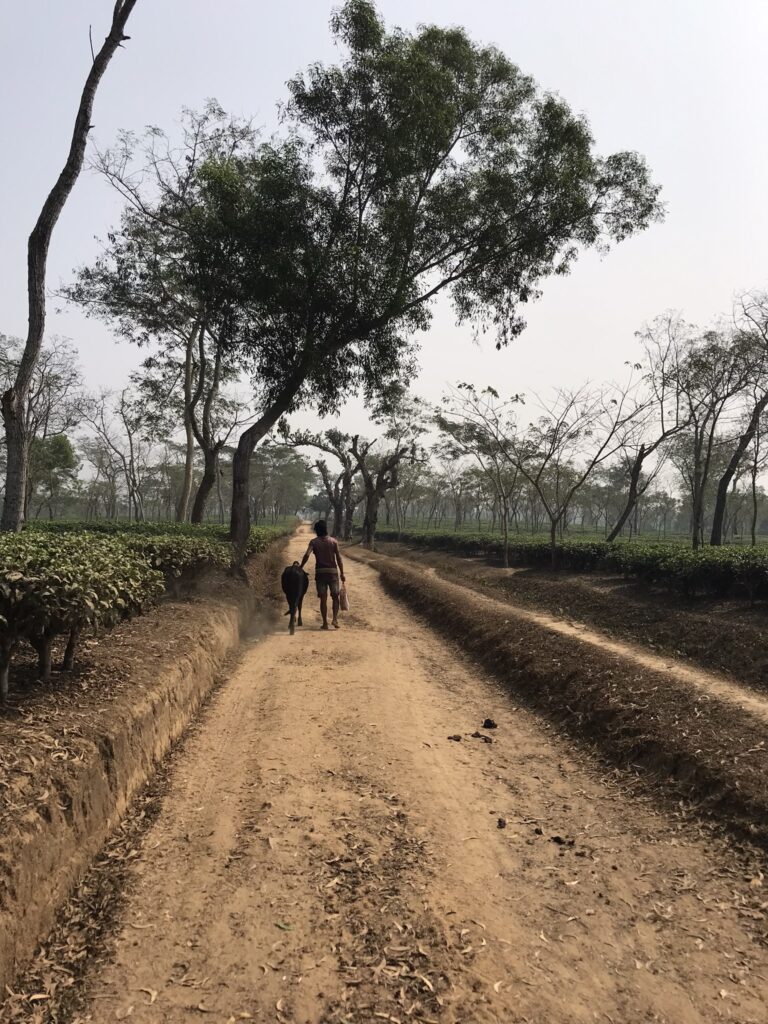
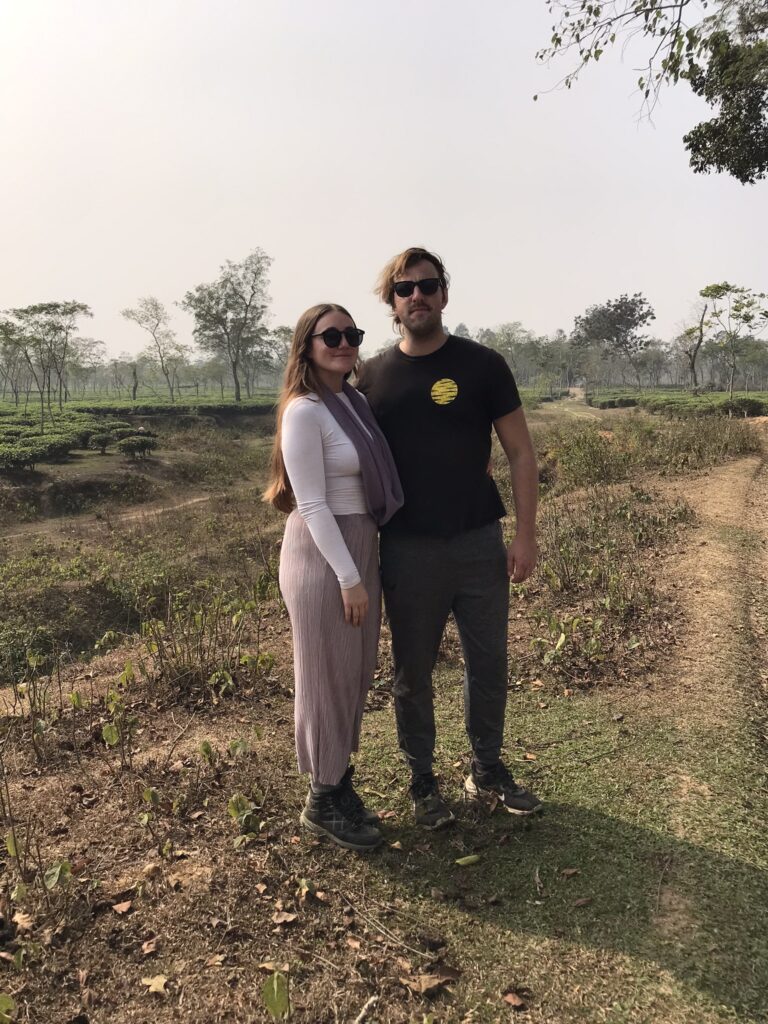
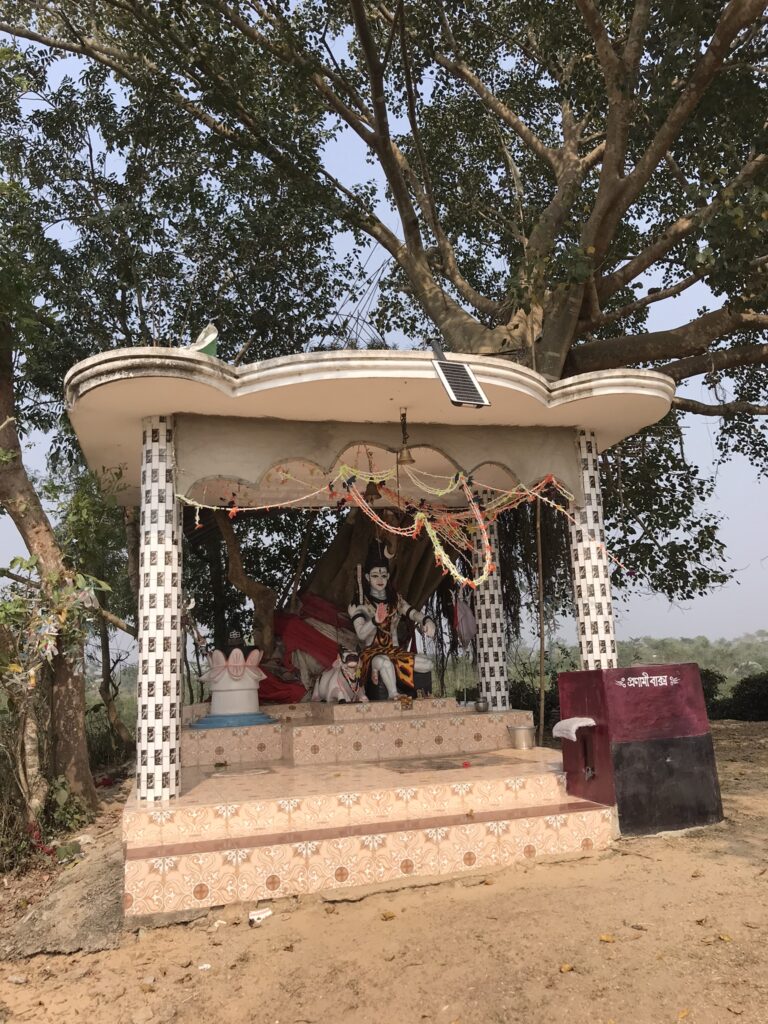
There are trackways around the whole plantation and it’s easy to get lost if you don’t pay attention to your route. There’s also a lake within the tea estate which is a pleasant place to sit for a while. The tea estate uses water from the lake for irrigation. Keep an eye out for monkeys having a tasty tea leaf snack in the trees dotted around the tea bushes. Playful children, roaming cows and the odd tractor are common sights in this vast tea estate.
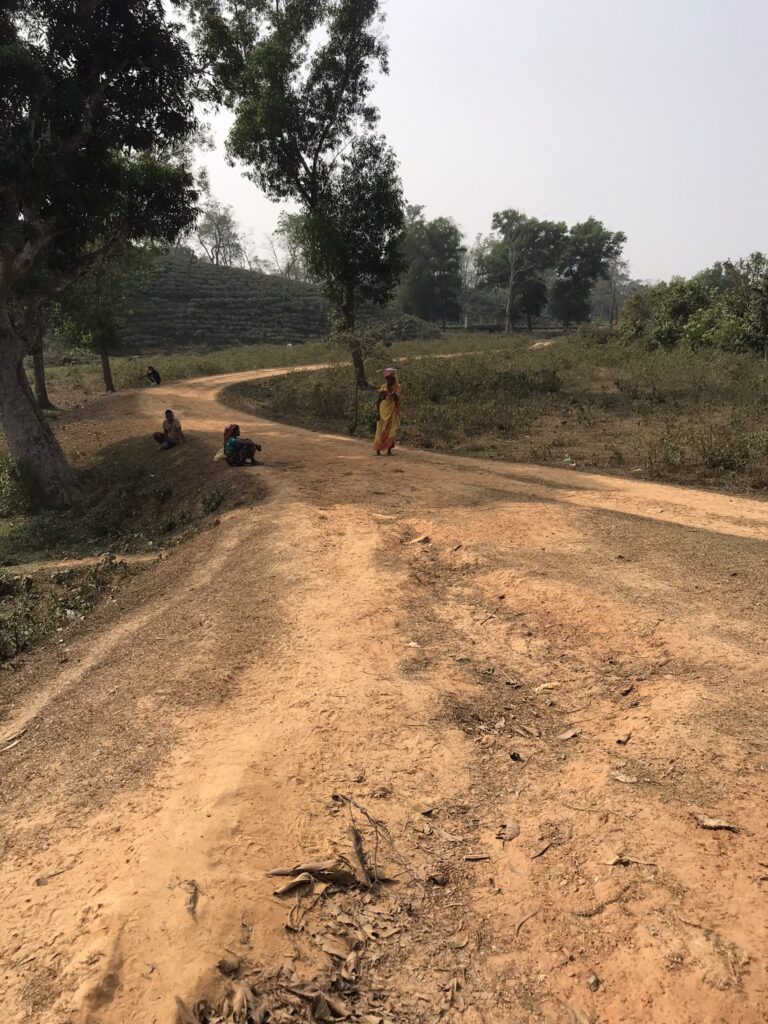


Sights and sounds of the Finlay Tea Estate
Nearby Hindu Village – it’s interesting to see another side of the tea plantation – shanty dwellings on the edge of the tea estates. The villagers were very interested in us and gave us a warm reception with lots of smiles and waving as we passed by.
Adi Nilkantha Tea Cabin – famous for serving the iconic 8-layered tea. According to the owners of the tea cabin, even former leader Sheikh Hasina has tried it. The 8-layered tea isn’t really that tasty – it’s overly sweet and all the flavours combine into one amorphous taste. Visiting Adi Nilkantha tea cabin is just one of those things that most tourists do in Sreemangal.
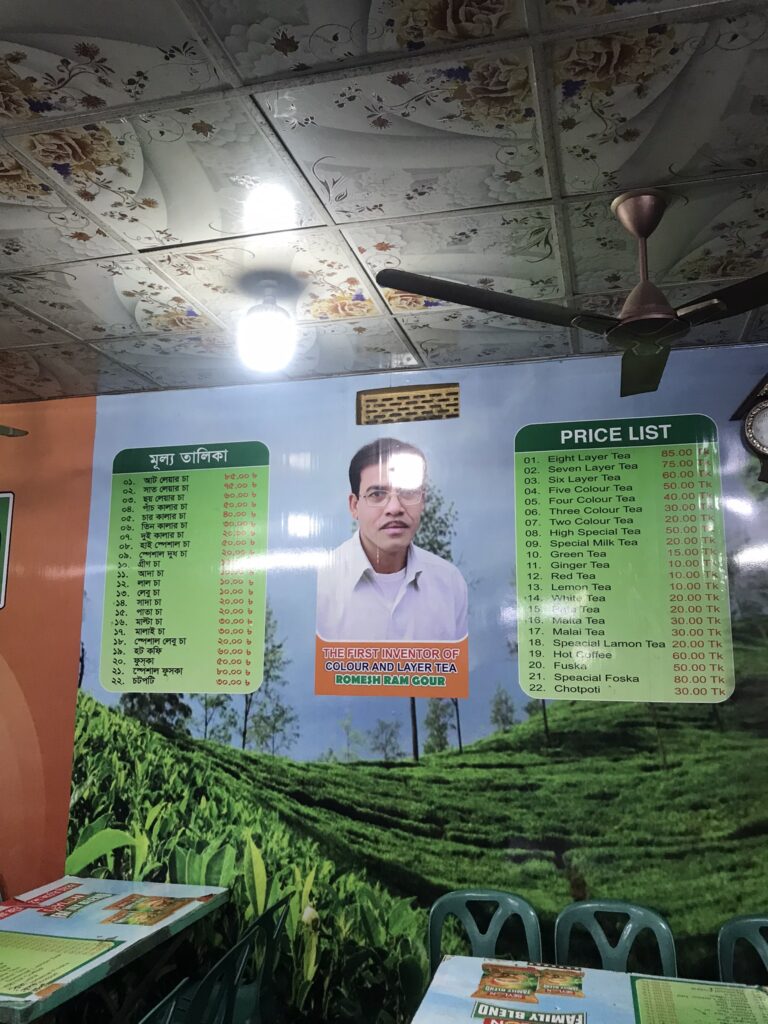
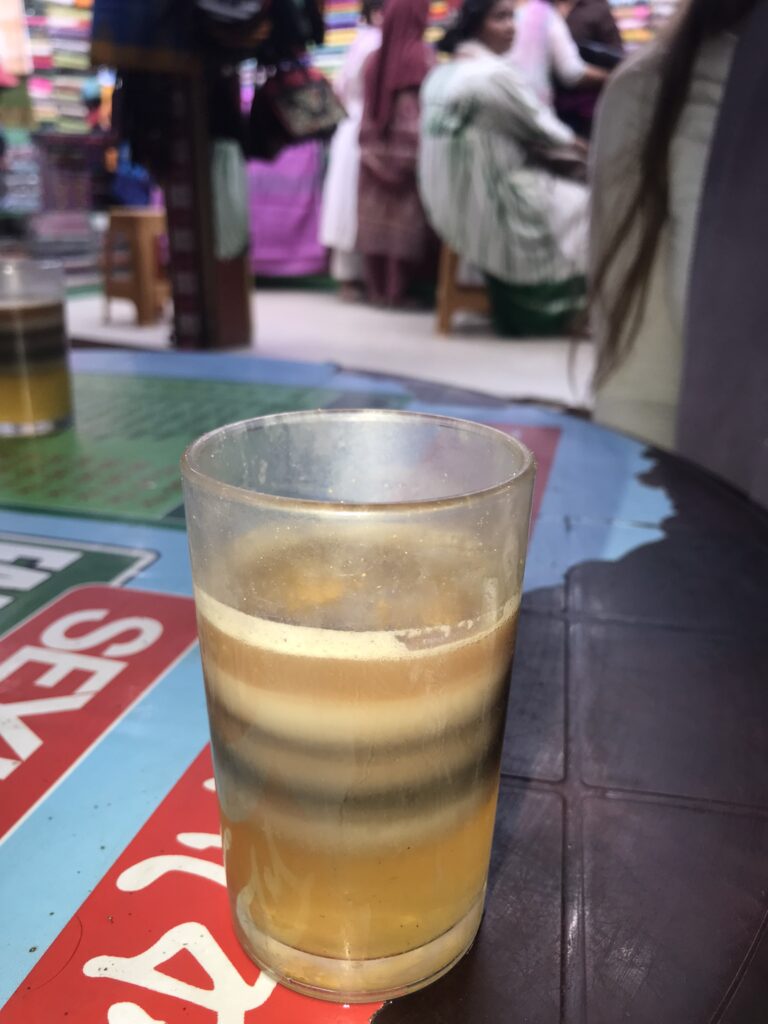
The layer tea is a total gimmick – don’t expect a great taste
Kalighat Rubber Garden – here you can actually observe the rubber sap slowly seeping out of the trees – it’s not the most thrilling spectacle but interesting for some nonetheless. There’s a whole orchard of these rubber trees next to the road. We passed by while walking to the Adi Nilkantha tea cabin and met a lovely local lady who lived nearby.
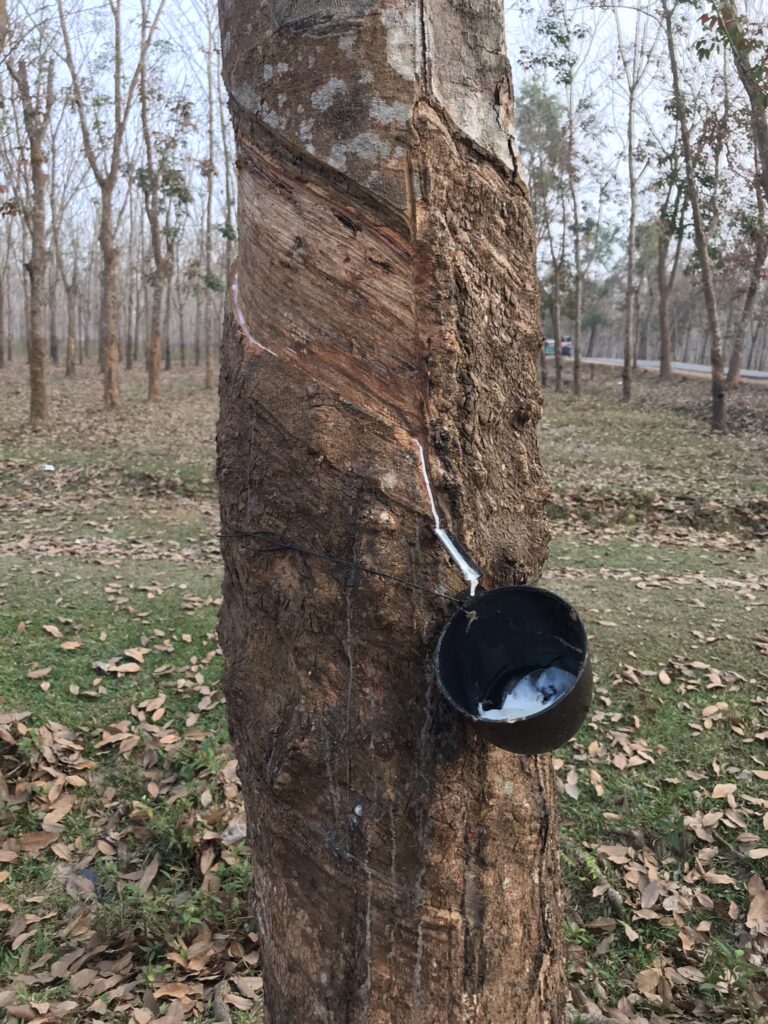
This… is not the most exciting thing in the world
Sylhet
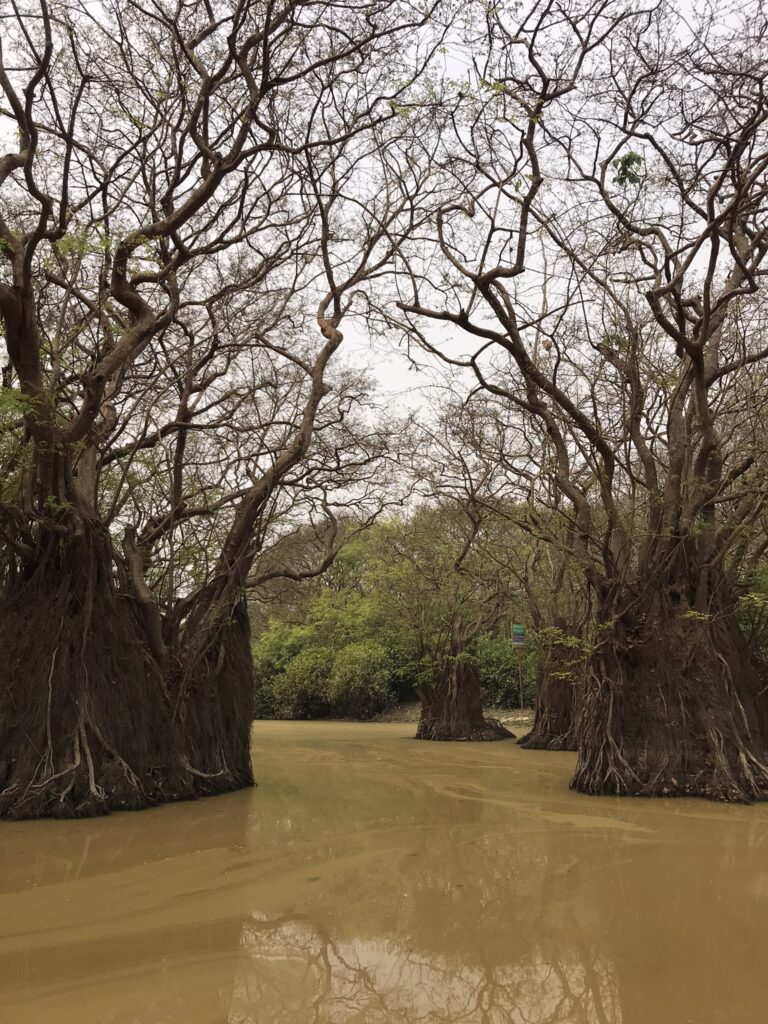
Sylhet is a major regional city close to the border with India. It’s popular with domestic tourists as it is a gateway to both the tea region and a number of other nearby natural landscapes, villages and attractions like Ratargul Swamp Forest, Jaflong and Shadapathor in the far north of the country, which are all part of the wider Sylhet region. If you hear someone saying they are ‘visiting Sylhet’, this is probably what they mean as the city of Sylhet is, at least from our experience, not a pleasant place at all. We found it to be a dirty and chaotic city with high levels of poverty and deprivation.
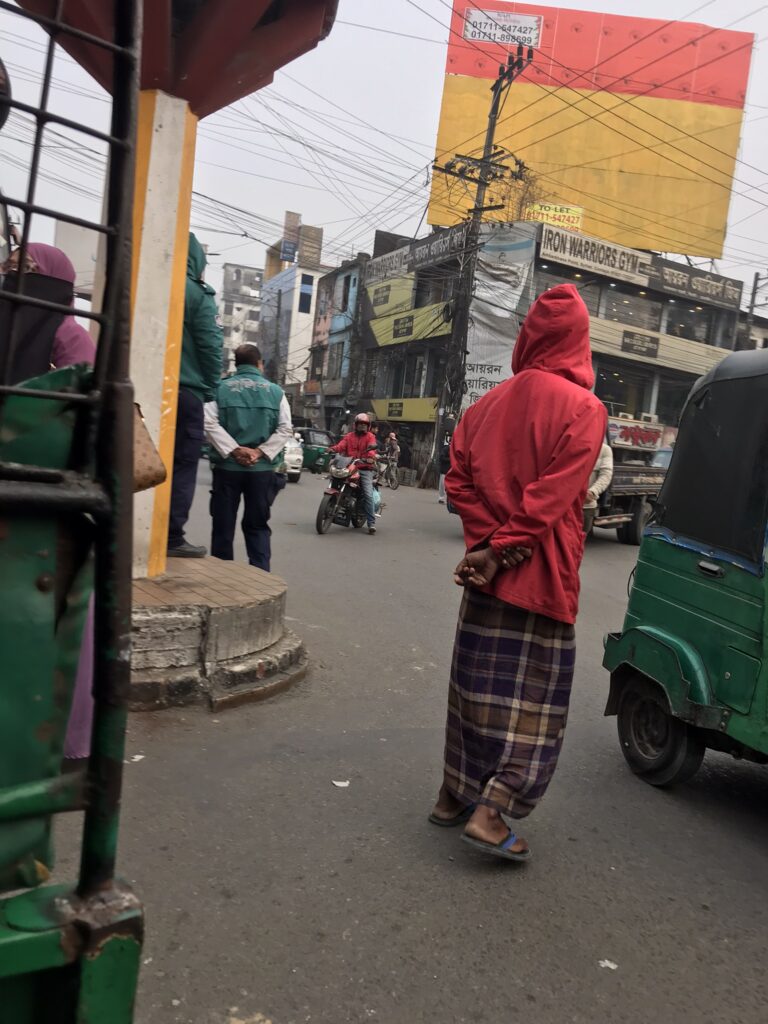
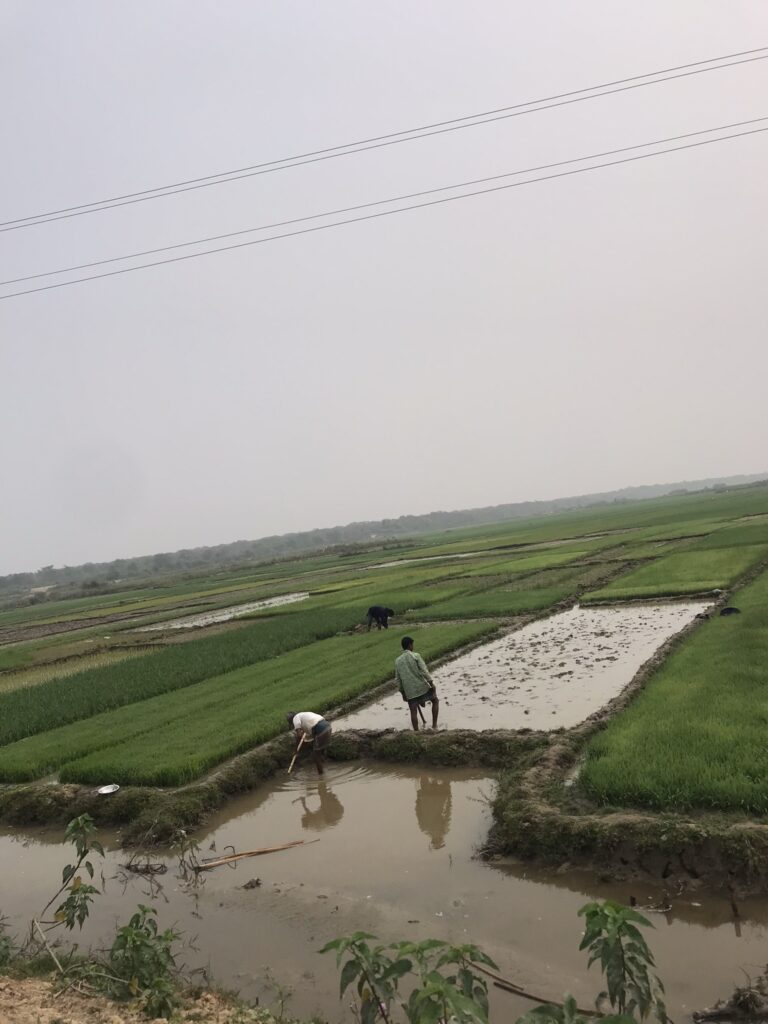
The rural areas are much, much nicer than the city
The areas around the city are filled with flooded rice paddies and agricultural landscapes. We enjoyed seeing rural life in the region which was a big contrast to the chaotic city centre. Unfortunately Sylhet city itself was not a nice place to be and the first place we visited in Bangladesh that really felt a bit sketchy. There were quite a lot of homeless people in a pretty bad state, we even saw a man on the street who appeared to have leprosy. The area around Panshi restaurant was really bad for overly forceful beggars and we were swarmed and hounded every time we stopped at traffic lights. At one point a man reached into our CNG to wave the stump of his amputated arm in our face. It was pretty grim and probably the highest openly visible levels of poverty we saw in South Asia, even worse than the worst parts of India that we visited.
For this reason, I recommend spending your time in Sylhet outside of the city centre. Although it is a little difficult to get around the wider region without a car, we organised a day trip to Ratargul Swamp Forest and Khadimnagar National Park in a CNG via our accommodation and it worked out pretty well. There are also some tea plantations located just outside of the city but these seemed quite dusty and not as picturesque as those in Sreemangal.
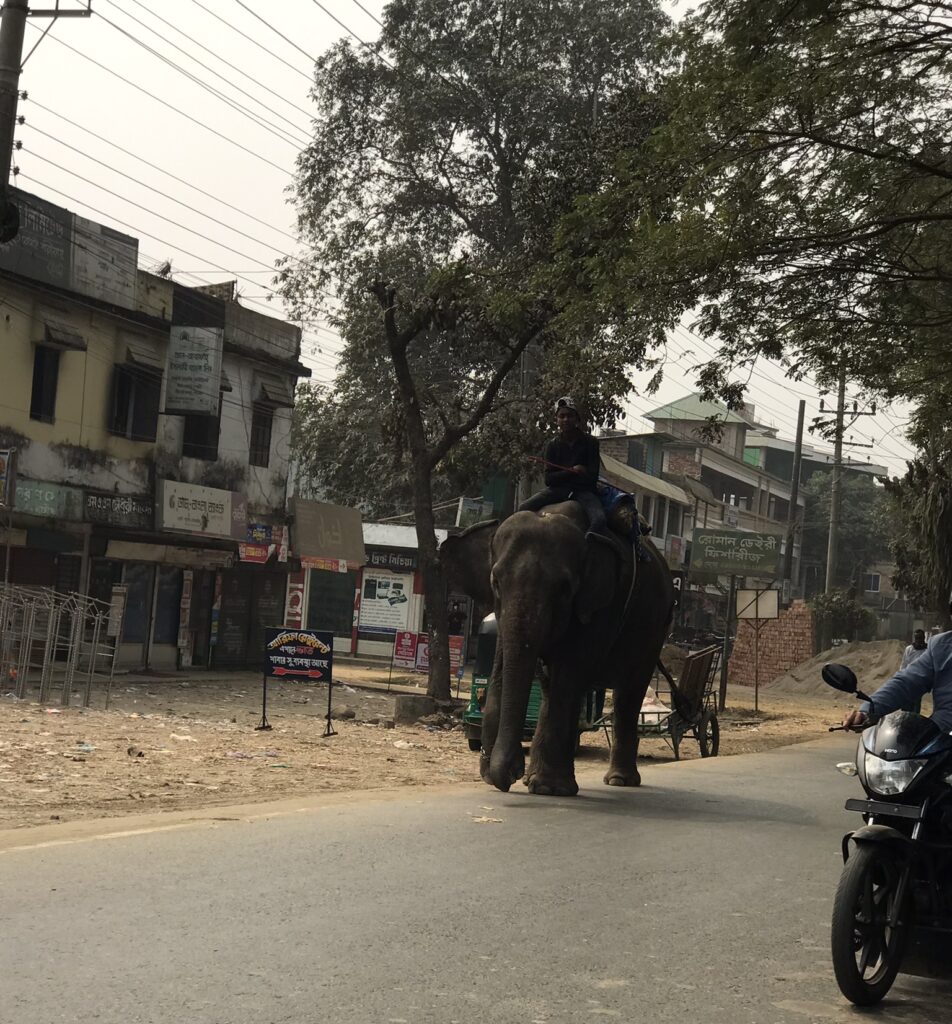
Randomly spotting a kid riding an elephant? Only in Sylhet
Accommodation
Jatra Flagship Sylhet City Centre – exactly the same setup as the Jatra Flagship in Khulna with two apartments turned into hotel rooms, although the rooms themselves weren’t quite as nice as the ones in Khulna. It was still a clean and comfortable room in Sylhet, within walking distance of the train station and bus terminal. The staff helped to organise a tuktuk driver to Khadimnagar National Park and Ratargul Swamp Forest.
Foodie Places
Panshi – an institution in Sylhet which was recommended to us by pretty much everyone we encountered. Tremendously busy and seems to be able to seat a very large number of people. We enjoyed the classic local foods such as kabab and bhorta, as well as the friendly service here.
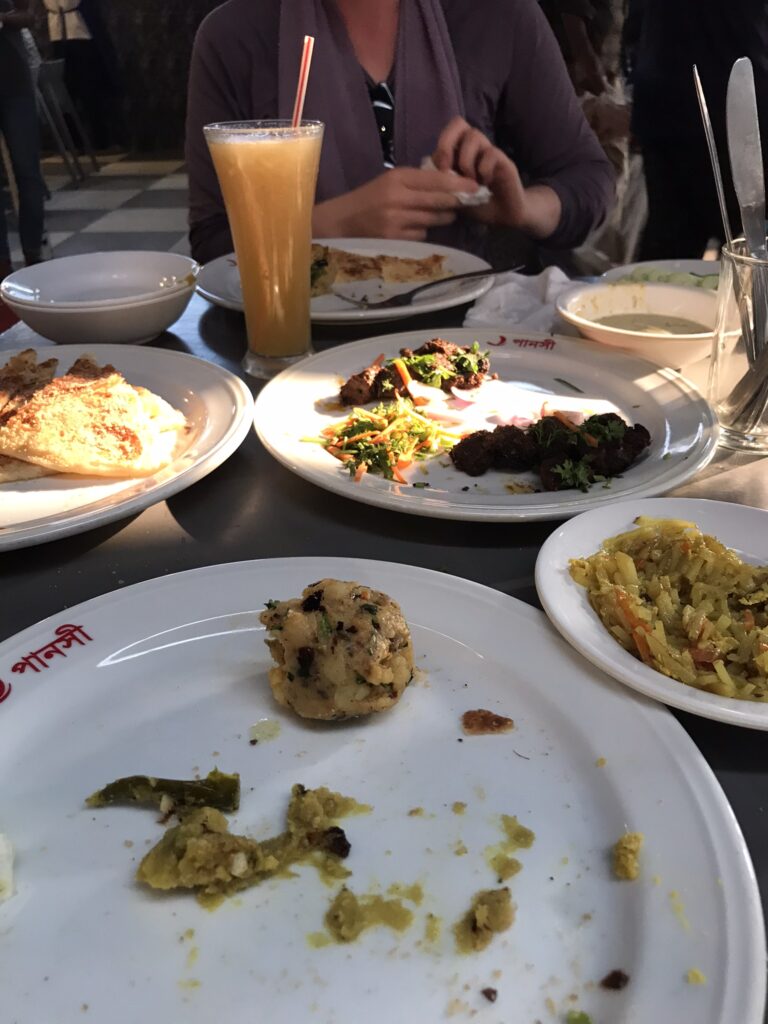
Local delicacies at Panshi
Artisan Coffee Co – we got some decent Western-style food which we ordered for delivery using the Food Panda delivery app. The food was good and the app worked well, although it requires a Bangladesh phone number so we had to enlist the help of one of the staff at our hotel to help us to order.
Activities
We organised a CNG driver to take us to two nearby natural sites. This was arranged through our accommodation, so we were able to get an honest and reliable driver (although he spoke no English).
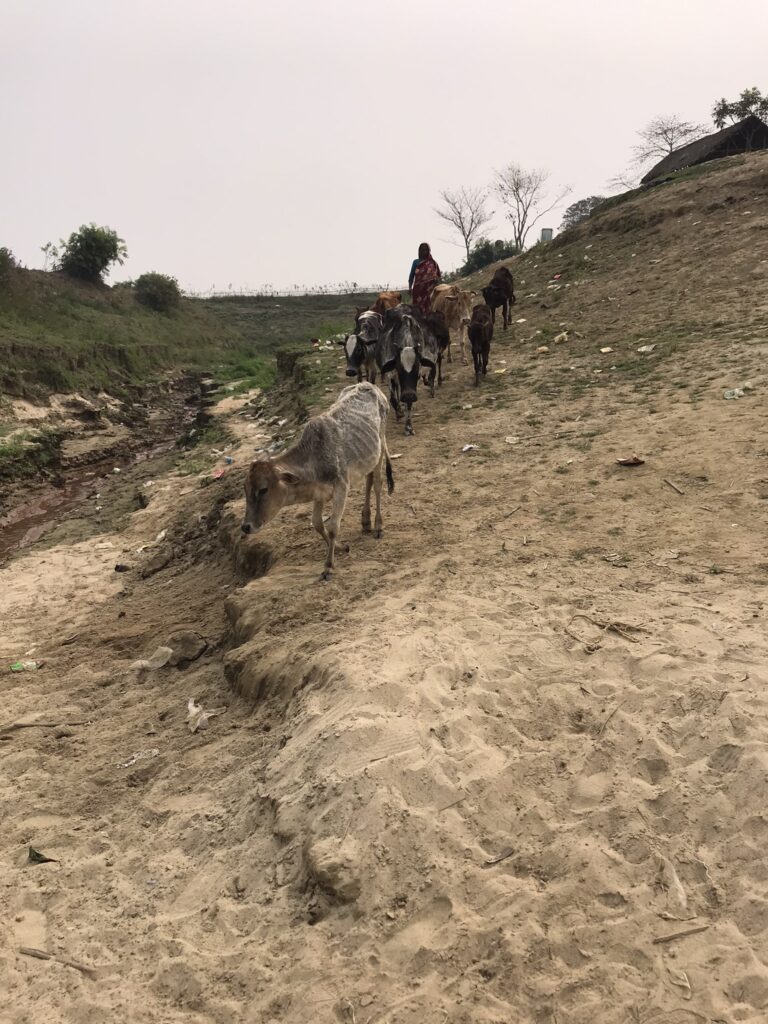
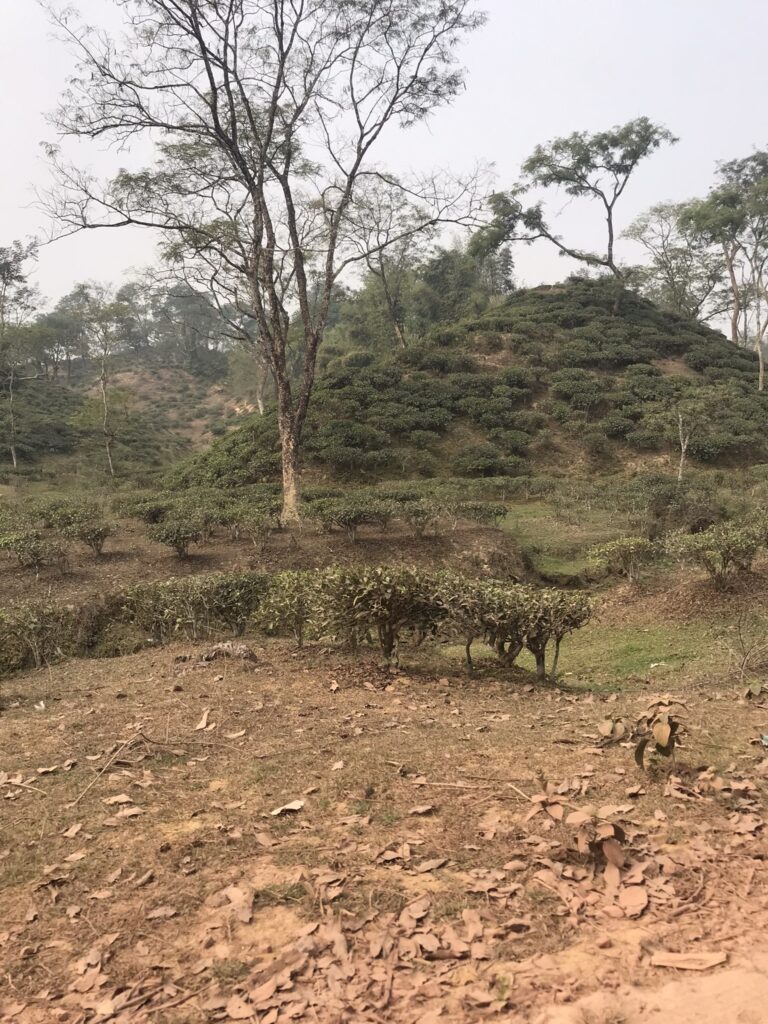
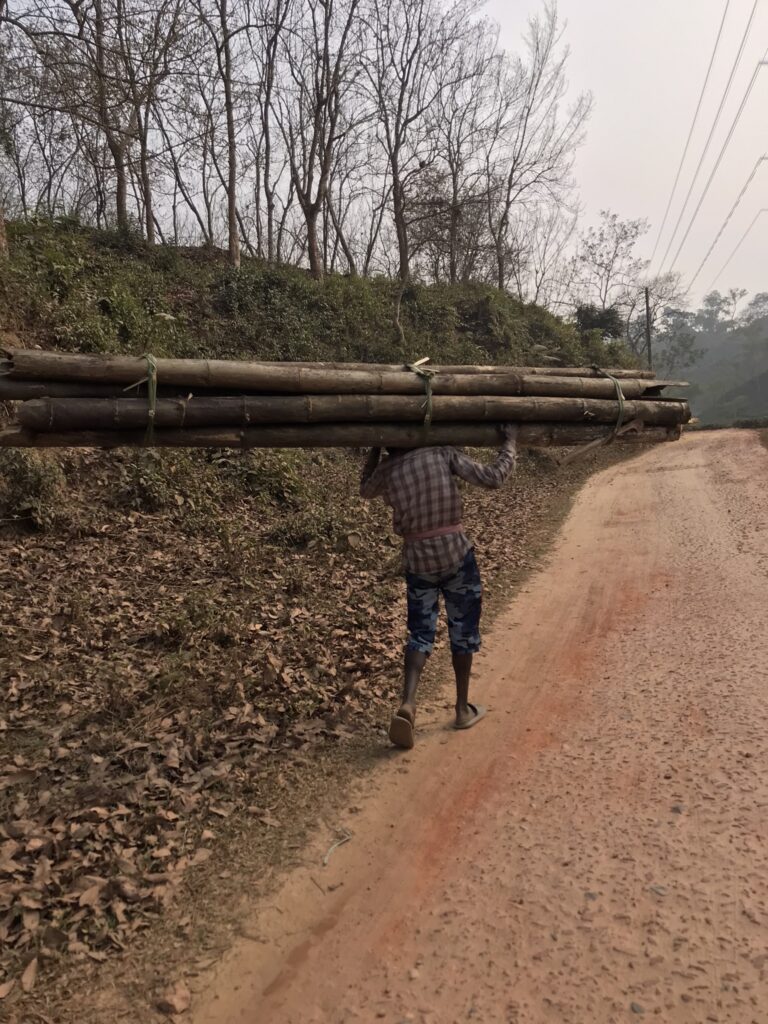
Passing through the rural landscapes around Sylhet was a highlight in itself
Ratargul Swamp Forest – the swamp forest is one of the major attractions in the Sylhet area, located around an hour from the city by CNG. There was some confusion at first when we arrived at the dock. We got out of the CNG to find many men just standing around, nobody spoke English or could really tell us the price or what to do. Eventually our CNG driver got on the phone to an English speaker who was able to translate. It turns out that foreigners are required to have a private boat at Ratargul and there are a number of different fees that need to be paid including a national park entrance fee, boat fee as well as baksheesh for everyone at the end. It ended up being quite an expensive activity.
The trip itself consists firstly of a motorboat ride along the river, the boat then docks at what is presumably the national park entrance (you need to show your ticket), after a short walk through a small nature trail you arrive at the actual swamp forest where you then board a canoe with two guys who paddle around the swamp forest among the sunken trees. All of this was arranged by the guy that we originally spoke to at the dock, who accompanied us along the way. If it sounds complicated, it is.
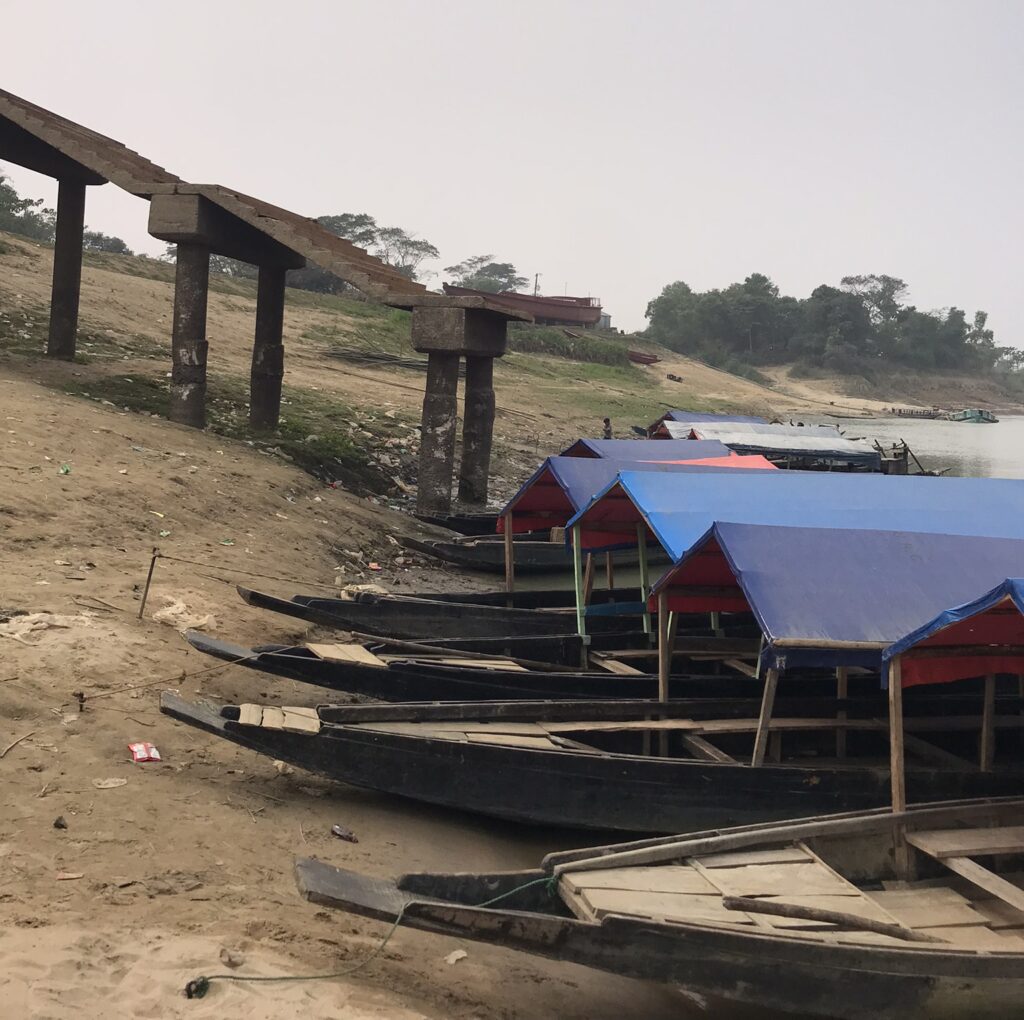
Water levels are clearly much higher in the rainy season
Ratargul Swamp Forest is best visited during the monsoon season when the water level is much higher. We visited during the dry season, there was still some water but the number of routes through the forest and the area covered by the swamp was more limited – we could see the high water mark from the rainy season on the trees, which was significantly higher. We still enjoyed the canoe ride in the forest which also included a photoshoot of epic proportions courtesy of our defacto guide and the ‘boatman’, who also sang us a song. A very touristy activity but still fun.
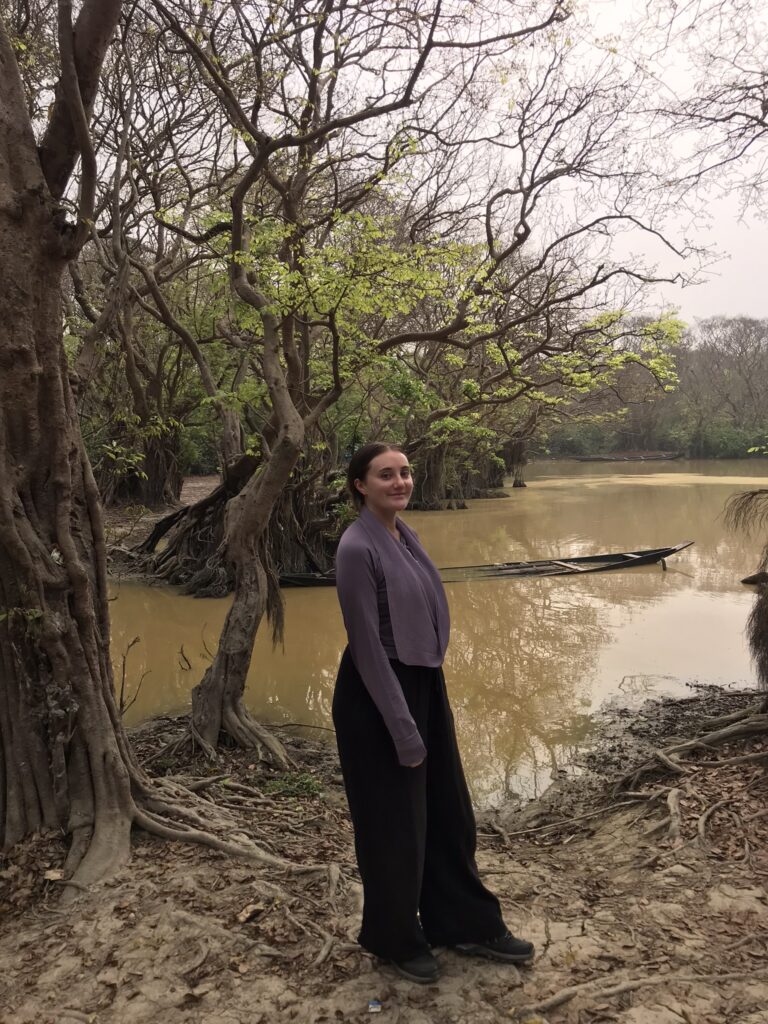
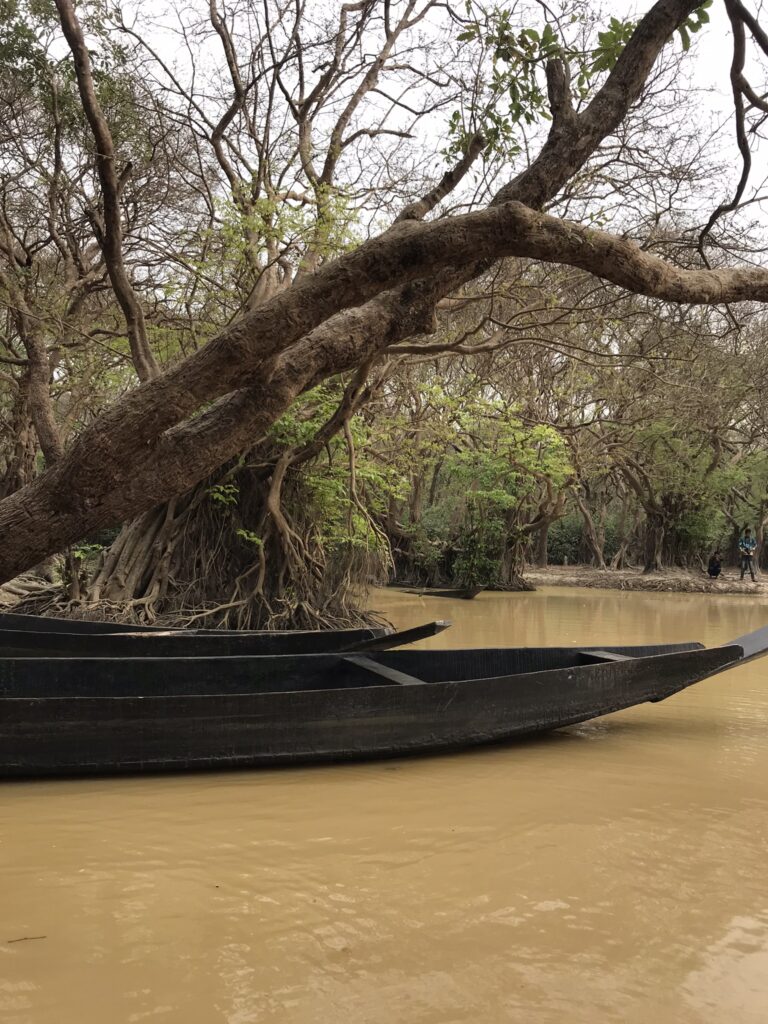

Even in the dry season there was still enough water in the swamp forest for a canoe ride
Khadimnagar National Park – a lesser visited attraction despite its prominence on the map. The road to the national park was pretty tough going in the CNG and our driver didn’t seem to be 100% sure he was heading the right way. After finding the park entrance (which is by the road here) we paid the park entrance fee and embarked on a 2 hour walking trail. Most people recommend a guide for the national park and the guys at the ticket counter were reluctant to let us in without one but our CNG driver intervened to convince them that we would be fine. This probably wasn’t a good idea in hindsight as it is very easy to get lost in the vast park, surrounded by dense undergrowth and with few landmarks. Although there is a map at the entrance, the route isn’t well signposted on the ground. Eventually we reached part of the trail that was flooded, so we just had to turn back and retrace our route.
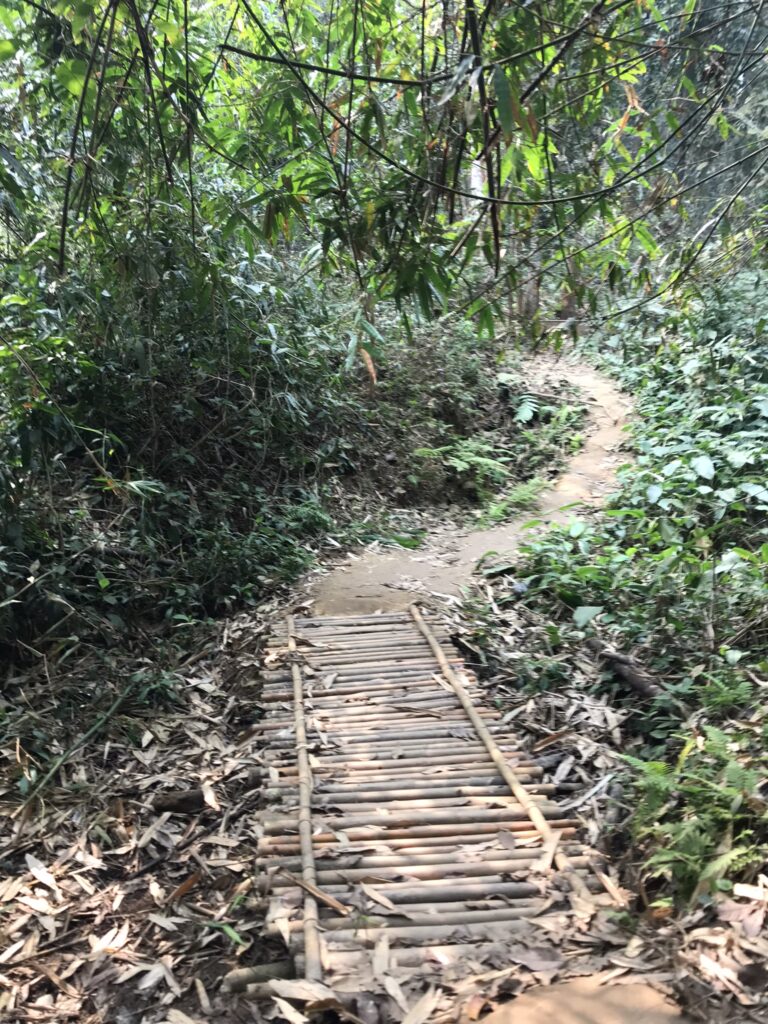

Khadimnagar national park is a pretty wild and remote place
The walk in the park itself wasn’t too strenuous, there was no rubbish along the trails, we heard plenty of birds and encountered virtually no other people – a haven for nature. In total to visit these two attractions we paid 3800 taka for the CNG driver for the day, 3200 in total for Ratargul National Park (various boats and 575 park fee for two people) and 1200 entry fee for Khadimnagar National Park for 2 people. A little expensive by Bangladeshi standards, but it is what it is.
After Sylhet we headed back to Dhaka and got a cheap flight to Chennai in Tamil Nadu! For more South Asia content, check out my destinations and itineraries page!
